
Using the latest Zillow Home Value Index data from 2025, we’ve ranked the 30 most expensive towns in Vermont based on current home prices. These communities represent more than just high-dollar real estate—they showcase Vermont’s most desirable places to live. Mountain resort towns, lakefront communities, and historic villages dominate this list for good reason.
Each town tells a story of natural beauty, recreational opportunities, and quality of life that justifies premium prices. From ski destinations like Stowe to charming valley towns, these rankings reveal where Vermont’s real estate market values location, amenities, and character most highly.
30. Burlington – 105% Home Price Increase Since 2010
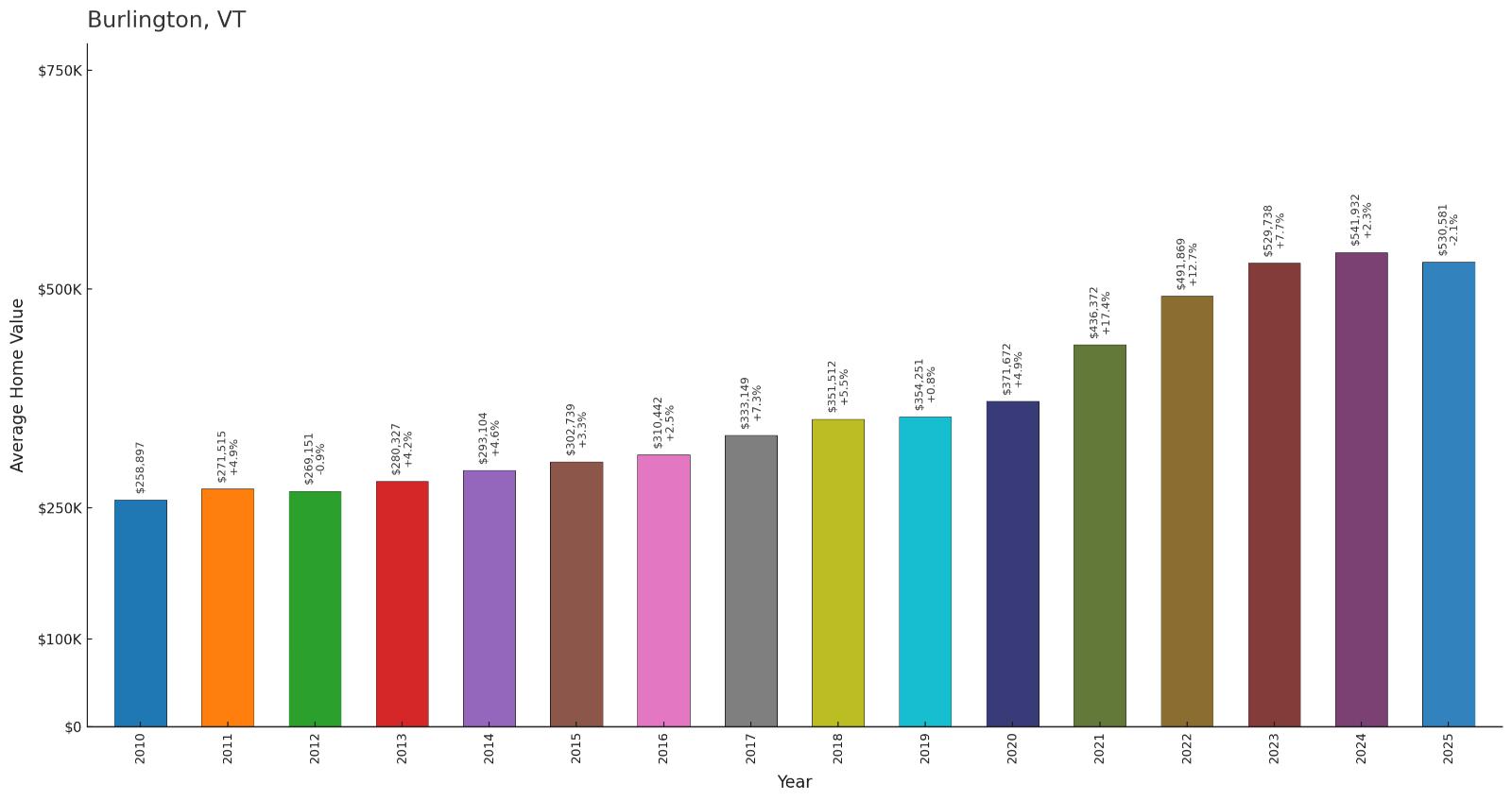
- 2010: $258,897
- 2011: $271,515
- 2012: $269,151
- 2013: $280,327
- 2014: $293,104
- 2015: $302,739
- 2016: $310,442
- 2017: $333,149
- 2018: $351,512
- 2019: $354,251
- 2020: $371,672
- 2021: $436,372
- 2022: $491,869
- 2023: $529,738
- 2024: $541,932
- 2025: $530,581
Burlington has doubled its home values since 2010, climbing from around $259,000 to over $530,000 by 2025. The city experienced its strongest growth period between 2020 and 2022, when prices jumped nearly $120,000 in just two years. Even with a slight pullback in 2025, Burlington maintains its position as Vermont’s economic hub with consistently strong real estate demand.
Why Burlington?
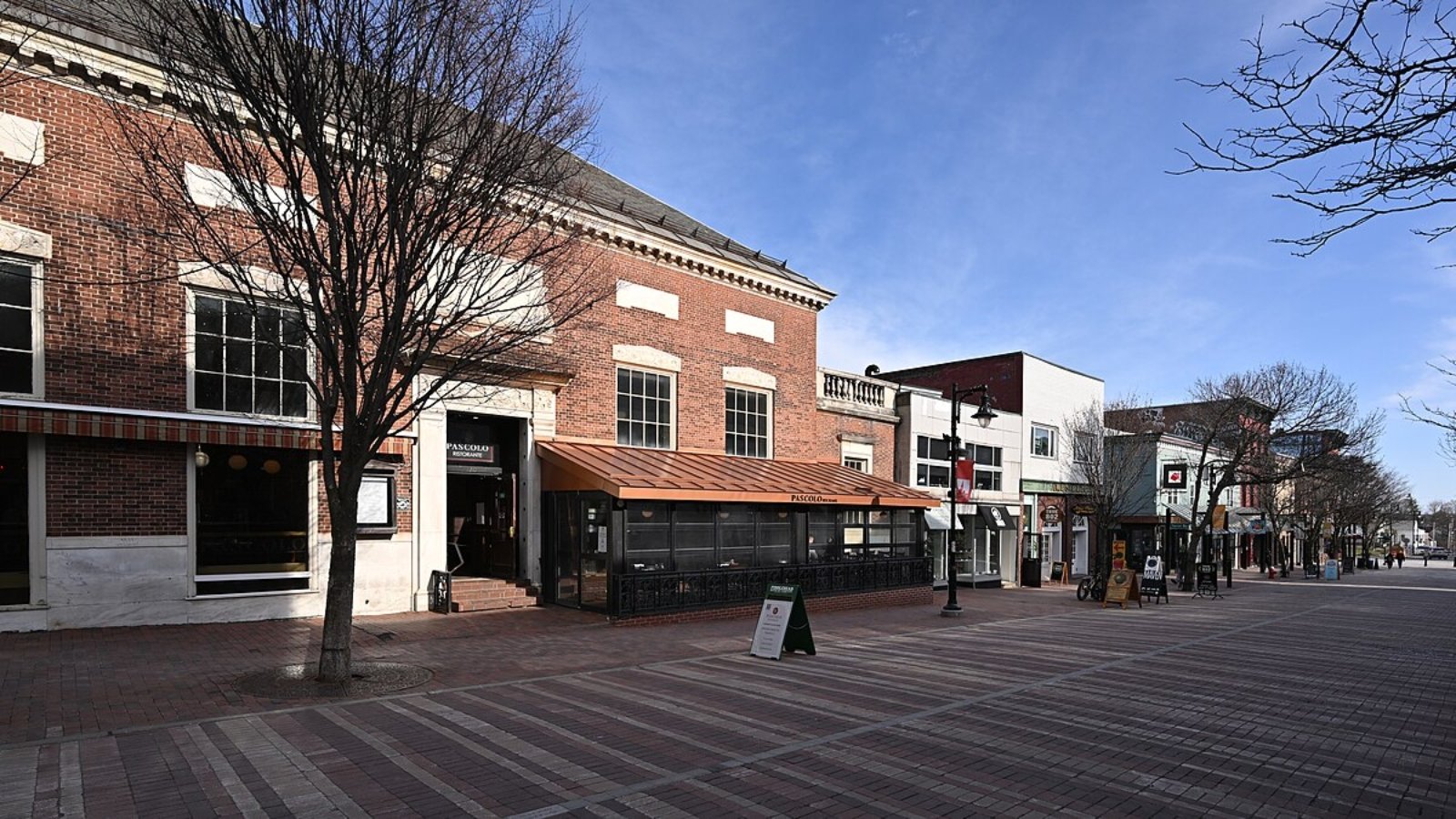
Why are people willing to pay so much to live here? What’s special about it?
Burlington offers the rare combination of urban amenities and outdoor access that defines Vermont living at its best. The city serves as Vermont’s cultural and economic center, with the University of Vermont, medical facilities, and tech companies providing diverse employment opportunities. Lake Champlain creates a stunning waterfront setting with beaches, marinas, and recreational activities just minutes from downtown.
The Church Street Marketplace, vibrant restaurant scene, and year-round festivals give Burlington a cosmopolitan feel that’s hard to find elsewhere in Vermont. Residents enjoy easy access to skiing at nearby resorts while living in a walkable city with excellent schools and healthcare systems.
How Burlington Rose to Prominence
Burlington’s prominence stems from its strategic location on Lake Champlain, which made it a major shipping port and commercial center from the early 1800s. The arrival of railroads in the mid-19th century cemented its role as Vermont’s largest city and economic hub. The University of Vermont, founded in 1791, became a major educational and research institution that attracted businesses and residents.
In recent decades, Burlington has successfully transitioned from manufacturing to a service-based economy centered on healthcare, education, and technology. The city’s progressive politics, environmental focus, and quality of life have attracted young professionals and families who value both urban amenities and Vermont’s outdoor lifestyle.
3 Interesting Tidbits
- Socialist Mayor Legacy – Burlington was famously governed by Bernie Sanders as mayor from 1981-1989, establishing many progressive policies still in place today.
- Ben & Jerry’s Birthplace – The famous ice cream company started in a converted gas station in Burlington in 1978, becoming a symbol of Vermont entrepreneurship.
- Bike-Friendly City – Burlington consistently ranks among America’s most bike-friendly cities, with extensive bike paths including the scenic Waterfront Bike Path along Lake Champlain.
29. Ferrisburgh – 80% Home Price Increase Since 2010

- 2010: $298,580
- 2011: $304,435
- 2012: $308,609
- 2013: $311,794
- 2014: $330,003
- 2015: $338,787
- 2016: $335,883
- 2017: $354,496
- 2018: $377,199
- 2019: $393,271
- 2020: $405,341
- 2021: $471,878
- 2022: $532,182
- 2023: $535,359
- 2024: $548,966
- 2025: $536,139
Ferrisburgh has shown steady appreciation over the past 15 years, growing 80% from its 2010 baseline of about $299,000. The town saw its most dramatic gains during the pandemic years, with values jumping from $405,000 in 2020 to over $532,000 by 2022. Current prices around $536,000 reflect Ferrisburgh’s appeal as a rural retreat with Burlington accessibility.
Why Ferrisburgh?

Why are people willing to pay so much to live here? What’s special about it?
Ferrisburgh attracts buyers seeking rural tranquility without sacrificing modern conveniences or commuting options. The town offers expansive properties with mountain and valley views, appealing to those who want space for horses, farming, or simply privacy. Its location provides easy access to both Burlington’s urban amenities and the recreational opportunities of Lake Champlain and the Green Mountains.
The community maintains a strong agricultural heritage while welcoming newcomers who appreciate Vermont’s traditional way of life. Ferrisburgh’s excellent schools and family-friendly atmosphere make it particularly attractive to professionals who can work remotely or commute to nearby employment centers.
How Ferrisburgh Rose to Prominence
Ferrisburgh was chartered in 1762 and developed as an agricultural community in the fertile Champlain Valley. The town’s prime farmland and proximity to Lake Champlain made it prosperous during Vermont’s early settlement period. Unlike many Vermont towns that relied on manufacturing, Ferrisburgh maintained its agricultural character throughout the 19th and 20th centuries.
In recent decades, Ferrisburgh has benefited from the “rural renaissance” as urban professionals seek countryside living while maintaining career flexibility. The town’s preserved rural character, combined with modern infrastructure and proximity to Burlington, has created a perfect balance for today’s remote workers and lifestyle-focused buyers.
3 Interesting Tidbits
- Rokeby Museum – This National Historic Landmark served as a major Underground Railroad station, helping enslaved people escape to freedom in Canada.
- Lake Champlain Access – Ferrisburgh includes several miles of Lake Champlain shoreline with public access points and scenic vistas.
- Working Landscape – The town still maintains active dairy farms and agricultural operations that preserve its rural character and provide fresh local products.
28. North Hero – 83% Home Price Increase Since 2010

- 2010: $294,140
- 2011: $300,265
- 2012: $306,126
- 2013: $304,228
- 2014: $320,033
- 2015: $328,554
- 2016: $327,685
- 2017: $336,639
- 2018: $354,560
- 2019: $364,090
- 2020: $380,522
- 2021: $466,379
- 2022: $526,354
- 2023: $517,493
- 2024: $536,550
- 2025: $537,551
North Hero’s island location has driven steady appreciation, with values climbing 83% since 2010. The town experienced moderate but consistent growth until 2020, then accelerated sharply during the pandemic years. Current median prices near $538,000 reflect the premium buyers pay for waterfront access and island living in the Champlain Islands.
Why North Hero?
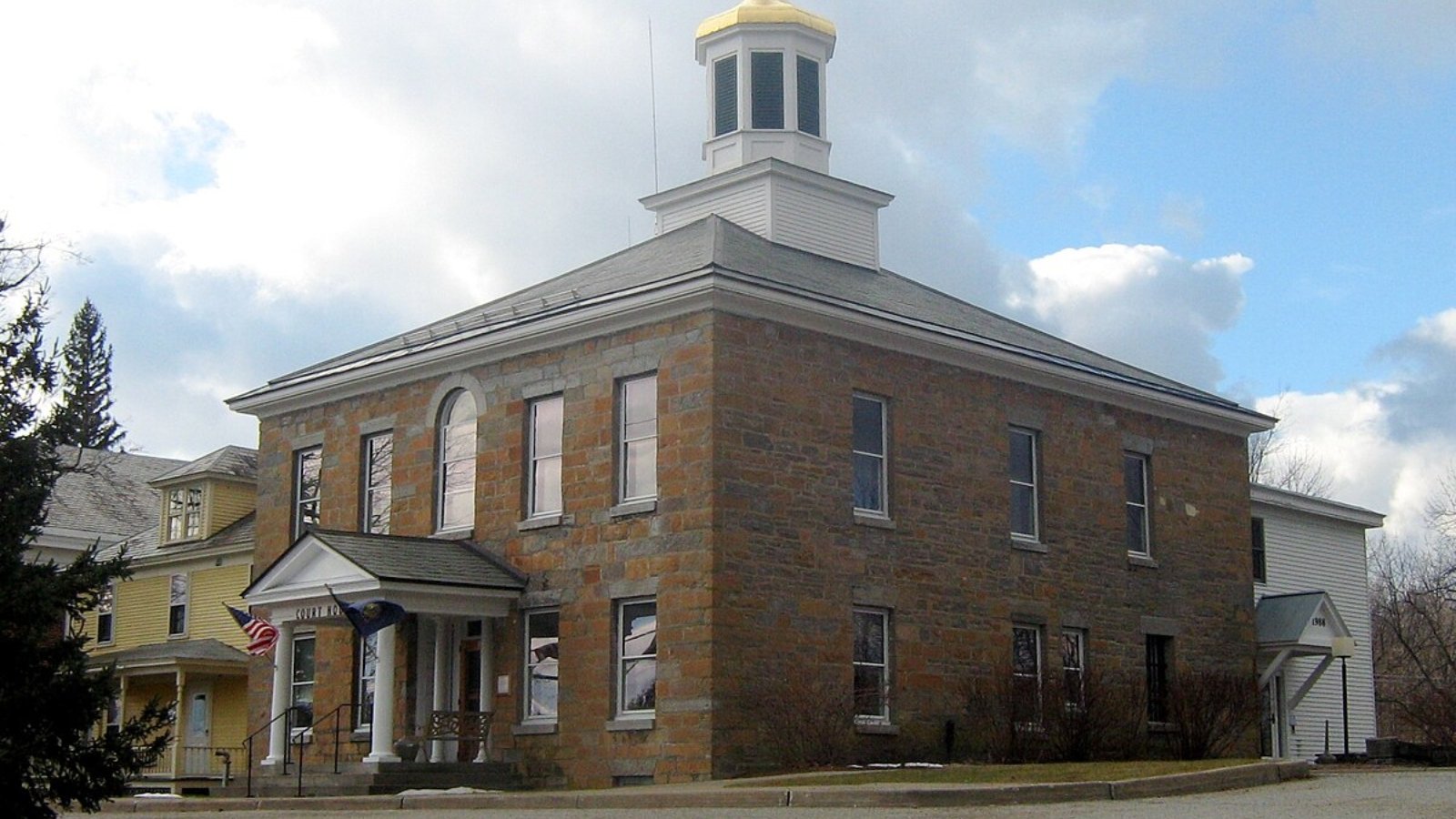
Why are people willing to pay so much to live here? What’s special about it?
North Hero offers the unique experience of island living while remaining connected to mainland Vermont via scenic bridges. The town provides extensive Lake Champlain waterfront access, making it ideal for boating, fishing, and water sports enthusiasts. Many properties feature private shoreline, docks, and panoramic lake views that create a resort-like atmosphere year-round.
The island’s peaceful setting attracts retirees and vacation home buyers who value privacy and natural beauty. Despite its remote feel, North Hero maintains essential services and connects easily to Burlington and Montreal, offering both isolation and accessibility.
How North Hero Rose to Prominence
North Hero Island was originally inhabited by Native American tribes who used it as fishing and hunting grounds. French explorers and settlers arrived in the early 1700s, followed by American colonists after the Revolutionary War. The island’s name honors Revolutionary War heroes Ethan Allen and his Green Mountain Boys, who operated in the region.
Agriculture dominated North Hero’s economy for most of its history, with dairy farming and apple orchards taking advantage of the lake’s moderating climate. The 20th century brought tourism and vacation homes as the island’s scenic beauty attracted visitors from urban areas. Today’s real estate market reflects North Hero’s evolution into a premier destination for waterfront living and recreational properties.
3 Interesting Tidbits
- Royal Lipizzan Stallions – The island hosts summer performances by these famous white horses at Shelburne Farms, attracting visitors from across New England.
- Grand Isle County – North Hero serves as the county seat for Grand Isle County, Vermont’s smallest county by land area.
- Apple Festival – The annual Apple Festival celebrates the island’s agricultural heritage with local cider, crafts, and community events each fall.
27. Westford – 77% Home Price Increase Since 2012
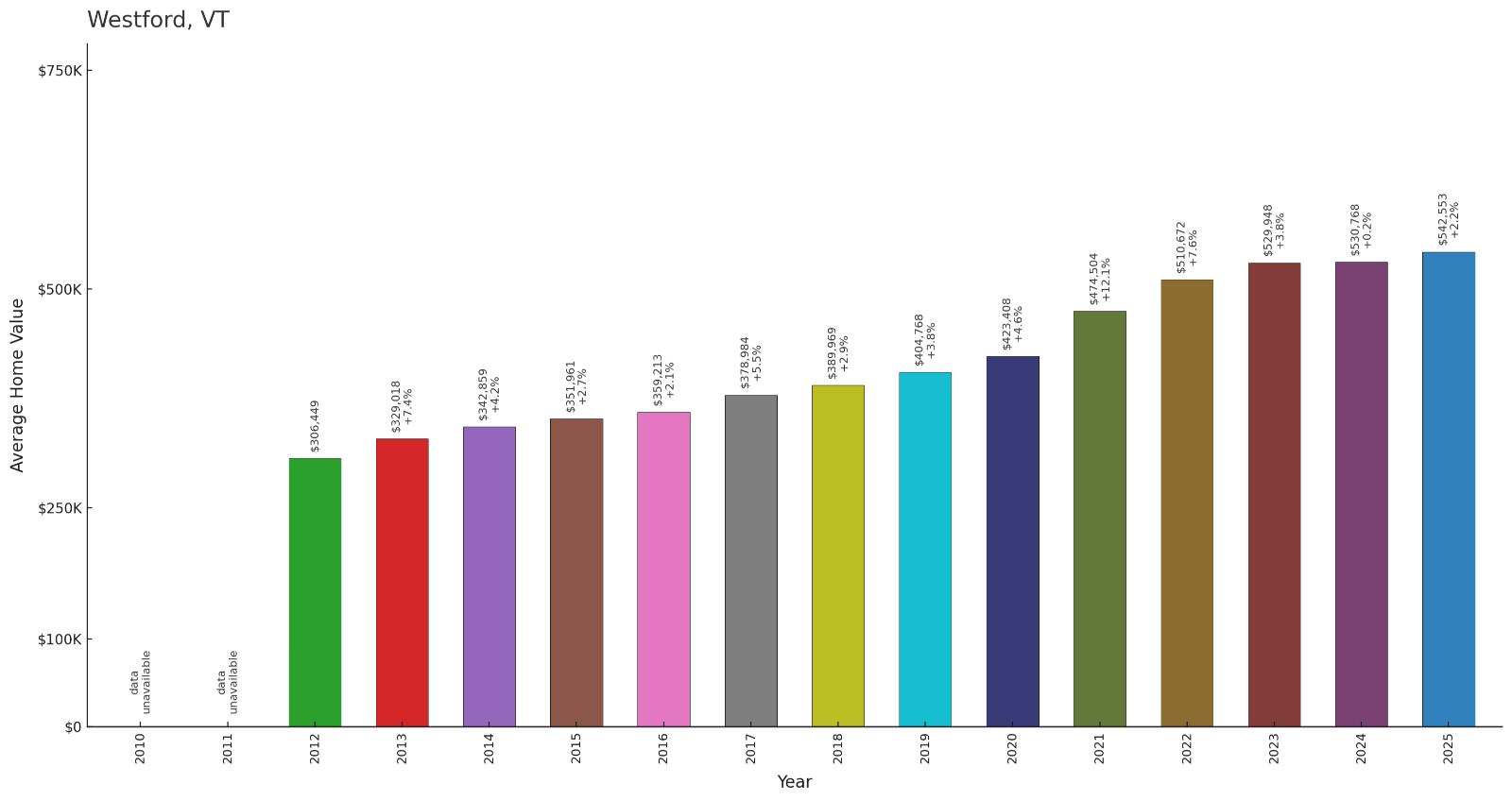
- 2010: N/A
- 2011: N/A
- 2012: $306,449
- 2013: $329,018
- 2014: $342,859
- 2015: $351,961
- 2016: $359,213
- 2017: $378,984
- 2018: $389,969
- 2019: $404,768
- 2020: $423,408
- 2021: $474,504
- 2022: $510,672
- 2023: $529,948
- 2024: $530,768
- 2025: $542,553
Westford has achieved solid 77% growth since 2012, climbing from around $306,000 to over $542,000 today. The town maintained steady appreciation throughout the 2010s, then accelerated during the pandemic years with particularly strong gains between 2020 and 2022. Recent values demonstrate Westford’s appeal as a family-friendly community with Burlington area access.
Why Westford?
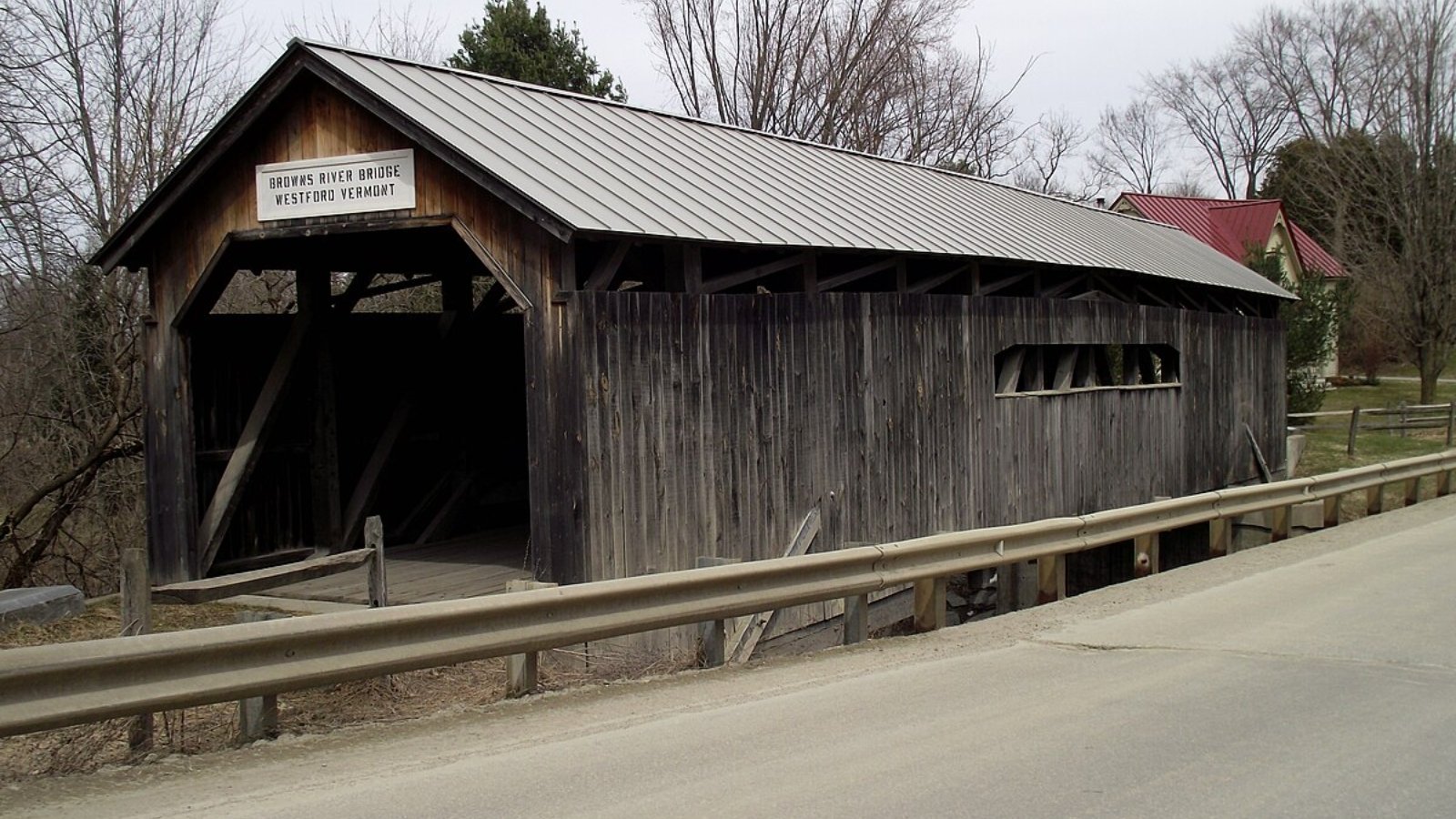
Why are people willing to pay so much to live here? What’s special about it?
Westford combines small-town charm with excellent schools and outdoor recreation opportunities that appeal to growing families. The town offers larger residential lots and newer construction than many Vermont communities, attracting buyers who want modern amenities in a rural setting. Its location provides easy commuting to Burlington while maintaining a peaceful, safe environment for raising children.
The community features excellent recreational facilities including parks, trails, and sports fields that support an active lifestyle. Westford’s proximity to both Smugglers’ Notch and Stowe ski resorts makes it attractive to outdoor enthusiasts who want four-season recreation access.
How Westford Rose to Prominence
Westford was chartered in 1763 and developed as an agricultural community in the Browns River valley. The town remained primarily rural throughout the 19th and early 20th centuries, with small-scale farming and forestry supporting the local economy. Unlike many Vermont towns, Westford avoided major industrial development, preserving its rural character.
Beginning in the 1970s and accelerating in recent decades, Westford transformed into a bedroom community for Burlington-area workers. The town’s excellent school system, family-friendly atmosphere, and development of modern subdivisions attracted professionals seeking suburban living with small-town values. This residential growth has driven Westford’s real estate appreciation and current market position.
3 Interesting Tidbits
- Browns River – This scenic waterway flows through Westford, providing fishing opportunities and powering historic mill sites throughout the town.
- Westford Elementary – The town’s highly-rated elementary school consistently ranks among Vermont’s top primary schools, attracting families throughout the region.
- Green Mountain Trails – Westford maintains an extensive network of hiking and cross-country skiing trails that connect to regional trail systems.
26. Morristown – 126% Home Price Increase Since 2010

- 2010: $240,920
- 2011: $236,732
- 2012: $245,842
- 2013: $256,201
- 2014: $261,940
- 2015: $271,935
- 2016: $280,025
- 2017: $295,333
- 2018: $304,717
- 2019: $321,518
- 2020: $337,500
- 2021: $425,057
- 2022: $497,924
- 2023: $510,119
- 2024: $535,240
- 2025: $545,025
Morristown leads in percentage growth with an impressive 126% increase since 2010, more than doubling from around $241,000 to $545,000. The town showed steady but modest gains through the 2010s before exploding upward after 2020. This dramatic appreciation reflects Morristown’s transformation from affordable rural community to sought-after destination for outdoor recreation enthusiasts.
Why Morristown?
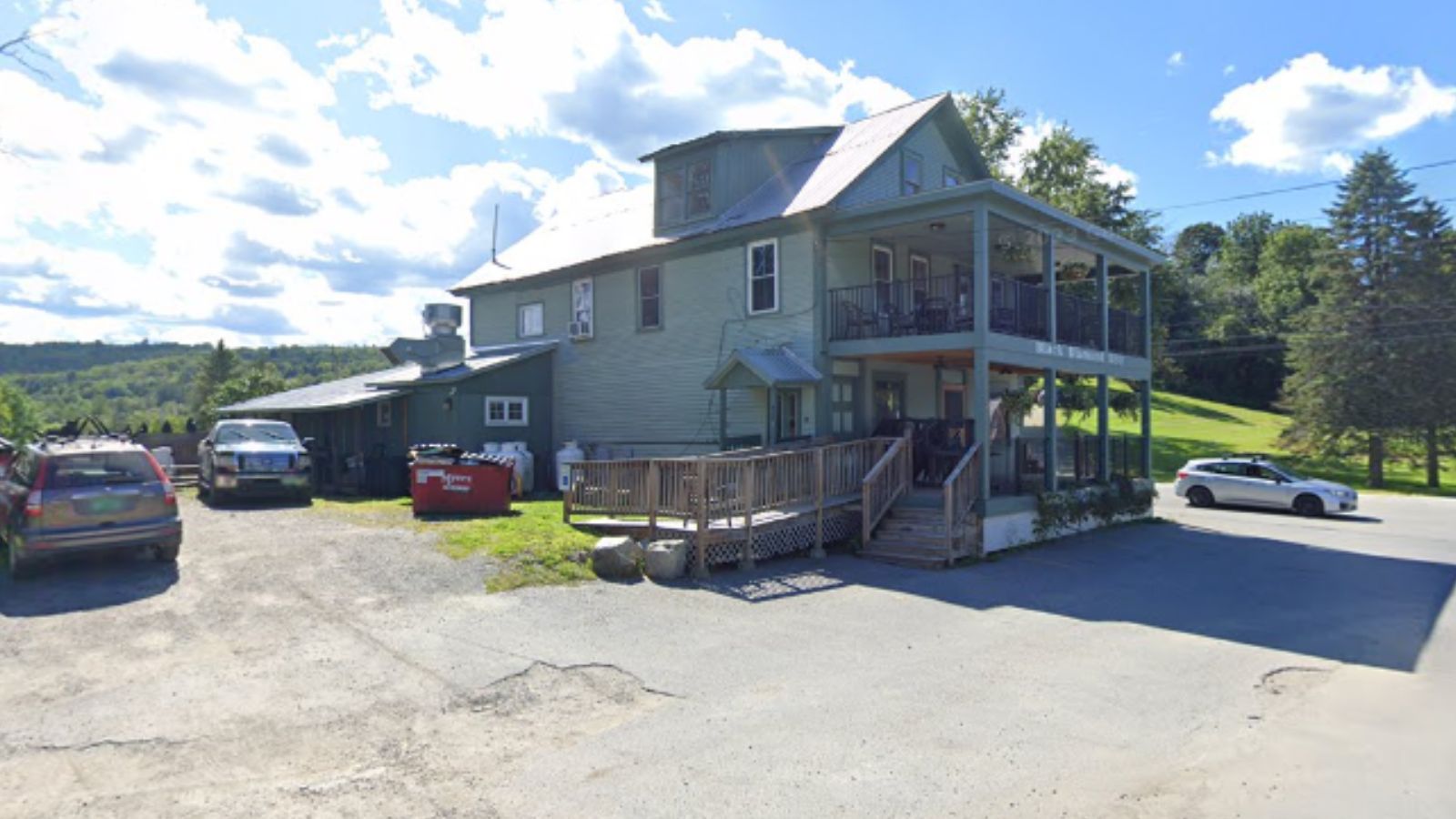
Why are people willing to pay so much to live here? What’s special about it?
Morristown offers immediate access to Stowe Mountain Resort while maintaining more affordable entry points than Stowe proper. The town provides spectacular mountain views, outdoor recreation opportunities, and a authentic Vermont small-town atmosphere that appeals to both full-time residents and vacation home buyers. Many properties offer privacy and acreage that’s increasingly rare in more developed resort areas.
The community benefits from Stowe’s amenities and tourism economy while retaining its agricultural character and local identity. Morristown’s location in the heart of the Green Mountains provides year-round outdoor activities from skiing and hiking to farming and forestry.
How Morristown Rose to Prominence
Morristown was chartered in 1781 and developed as an agricultural and logging community in the Lamoille River valley. The town’s economy centered on farming, particularly dairy operations, and forest products throughout the 19th and early 20th centuries. The arrival of skiing at nearby Stowe Mountain Resort in the 1930s began to change the local economy.
As Stowe evolved into a major ski destination, Morristown benefited from overflow demand for housing and services while maintaining lower costs than the resort town itself. The recent surge in remote work and outdoor recreation popularity has driven unprecedented interest in Morristown properties, creating the dramatic price appreciation seen in recent years.
3 Interesting Tidbits
- Cady’s Falls Nursery – This renowned garden center and landscaping business has operated in Morristown for decades, serving the entire region.
- Green Mountain Railroad – Historic rail lines pass through Morristown, once vital for logging and agriculture, now used for scenic tourist trains.
- Lamoille Valley Rail Trail – This 93-mile recreation trail passes through Morristown, providing year-round access for hiking, biking, and snowmobiling.
25. Weybridge – 58% Home Price Increase Since 2012

- 2010: N/A
- 2011: N/A
- 2012: $345,917
- 2013: $358,037
- 2014: $364,888
- 2015: $367,340
- 2016: $362,103
- 2017: $383,341
- 2018: $410,427
- 2019: $426,753
- 2020: $436,549
- 2021: $482,703
- 2022: $538,067
- 2023: $542,048
- 2024: $559,266
- 2025: $548,271
Weybridge has posted steady 58% growth since 2012, rising from around $346,000 to nearly $548,000 today. The town maintained relatively stable appreciation through the mid-2010s before accelerating during the pandemic period. Current values reflect Weybridge’s position as a prestigious rural community with proximity to Middlebury College and recreational amenities.
Why Weybridge?
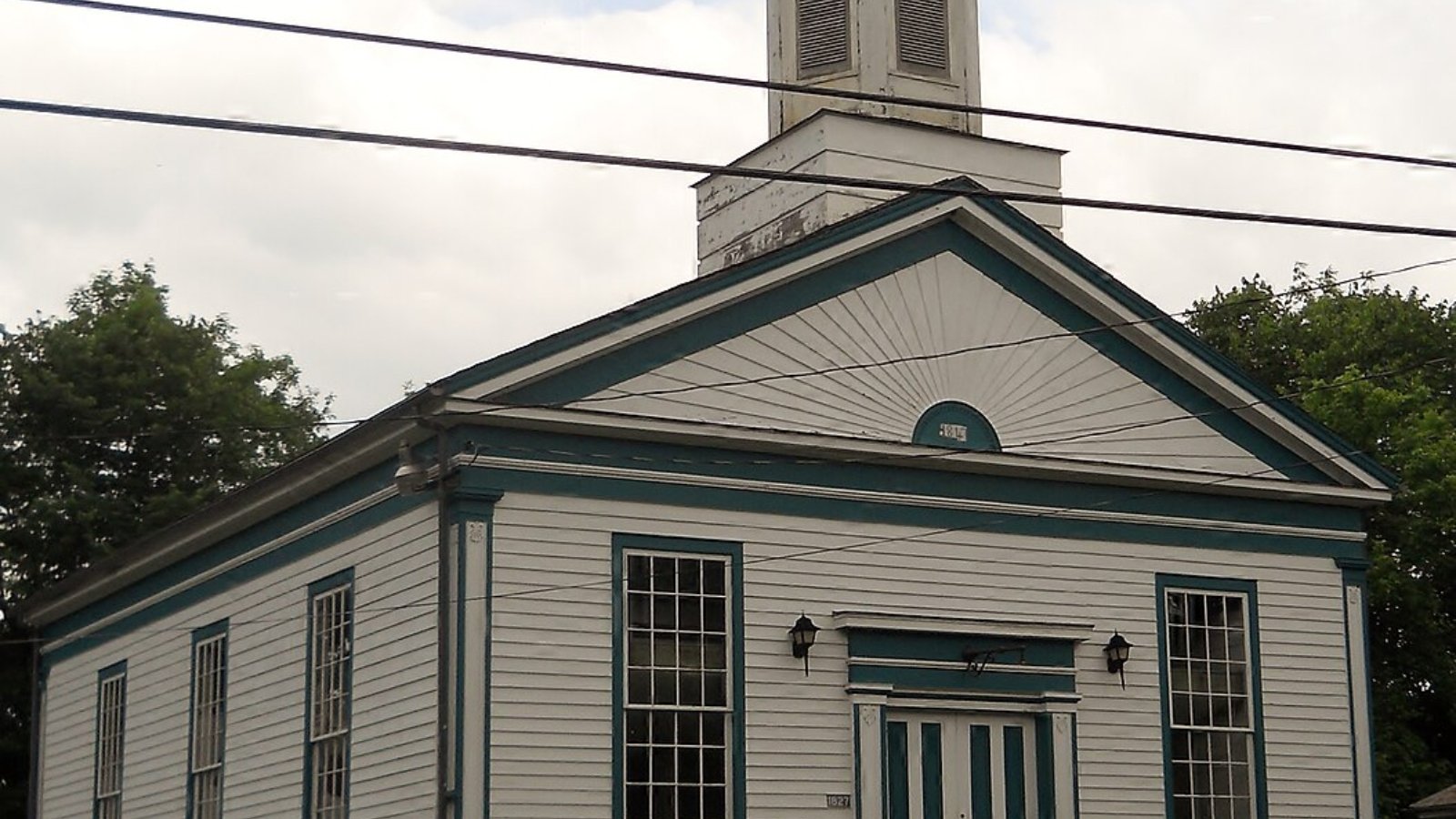
Why are people willing to pay so much to live here? What’s special about it?
Weybridge attracts affluent buyers seeking rural elegance and proximity to Middlebury’s cultural and educational offerings. The town features expansive properties with mountain views, horse farms, and agricultural preservation that creates an exclusive country atmosphere. Many residents are connected to Middlebury College either as faculty, alumni, or supporters who value the area’s intellectual and cultural environment.
The community offers a sophisticated rural lifestyle with easy access to recreational activities including skiing, hiking, and water sports on nearby Lake Champlain. Weybridge’s agricultural heritage and commitment to land conservation ensure the pastoral character that attracts premium buyers.
How Weybridge Rose to Prominence
Weybridge was chartered in 1761 and developed as one of the Champlain Valley’s premier agricultural communities. The town’s fertile soils and favorable climate made it ideal for farming, particularly dairy operations and apple orchards. Throughout the 19th century, Weybridge farmers supplied markets in Burlington and beyond via rail and water transportation.
The presence of Middlebury College, founded in 1800 just across the Otter Creek, has long influenced Weybridge’s character and economy. College faculty and administrators have historically chosen Weybridge for its rural setting and proximity to campus. This academic connection, combined with the town’s agricultural preservation efforts, has created today’s exclusive rural community that commands premium real estate prices.
3 Interesting Tidbits
- Otter Creek – Vermont’s longest river forms Weybridge’s eastern boundary, providing scenic beauty and recreation opportunities including fishing and canoeing.
- Morgan Horse Farms – Several properties in Weybridge breed and train Morgan horses, Vermont’s official state animal and breed.
- Land Trust Protection – Much of Weybridge’s agricultural land is protected by conservation easements, preserving the rural character that drives property values.
24. Fayston – 113% Home Price Increase Since 2010
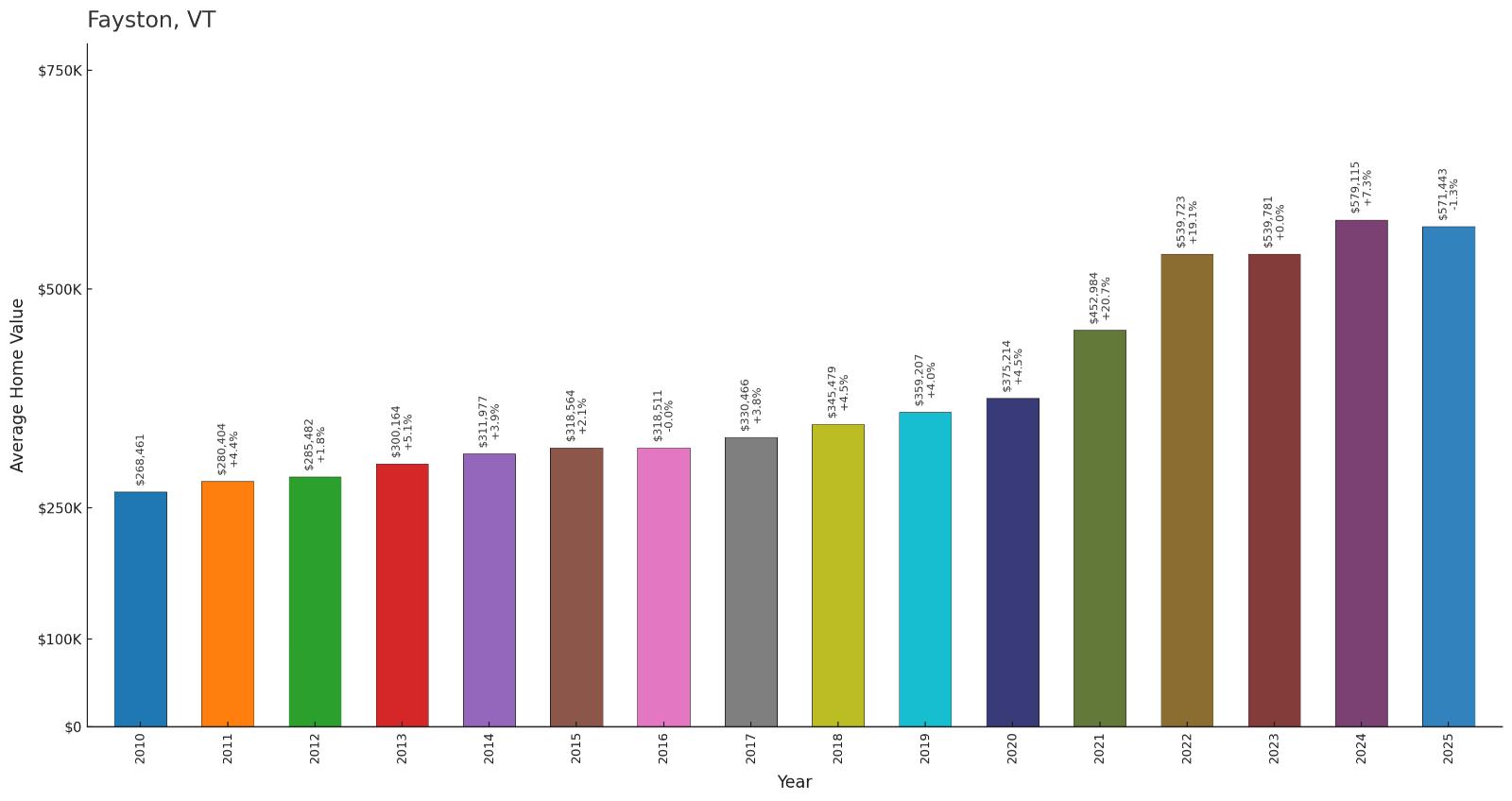
- 2010: $268,461
- 2011: $280,404
- 2012: $285,482
- 2013: $300,164
- 2014: $311,977
- 2015: $318,564
- 2016: $318,511
- 2017: $330,466
- 2018: $345,479
- 2019: $359,207
- 2020: $375,214
- 2021: $452,984
- 2022: $539,723
- 2023: $539,781
- 2024: $579,115
- 2025: $571,443
Fayston has more than doubled in value since 2010, achieving 113% growth from approximately $268,000 to $571,000. The town showed steady but moderate appreciation through most of the 2010s before experiencing explosive growth during the pandemic years. This dramatic increase reflects Fayston’s emergence as a premier destination for Mad River Valley recreation and lifestyle buyers.
Why Fayston?
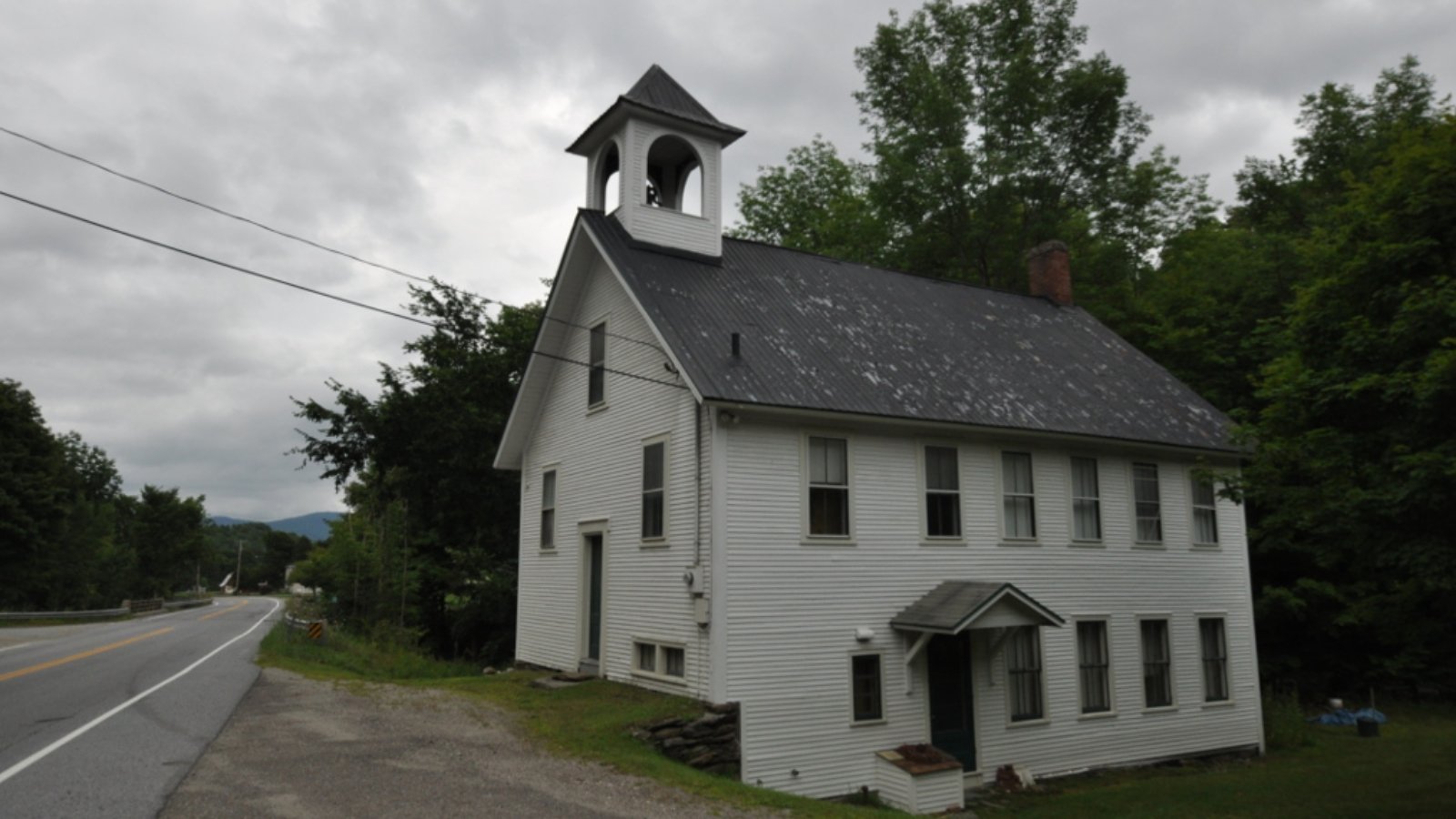
Why are people willing to pay so much to live here? What’s special about it?
Fayston provides exclusive access to some of Vermont’s best skiing at Mad River Glen and Sugarbush, attracting serious skiers and outdoor enthusiasts. The town maintains a commitment to environmental preservation and limited development that keeps it feeling pristine and exclusive. Many properties offer ski-in access, mountain views, and privacy that’s increasingly rare in Vermont’s developed valleys.
The community values its authentic Vermont character and resists over-commercialization, appealing to buyers who want genuine mountain living rather than resort development. Fayston’s location in the Mad River Valley provides year-round recreation with hiking, mountain biking, and cross-country skiing complementing the alpine offerings.
How Fayston Rose to Prominence
Fayston was chartered in 1782 and remained largely wilderness until the mid-20th century due to its mountainous terrain and remote location. Early settlers practiced subsistence farming and logging, but the town’s population remained small throughout the 1800s and early 1900s. The development of skiing at Mad River Glen in 1948 began Fayston’s transformation.
Mad River Glen’s famous “Ski It If You Can” motto and commitment to preserving challenging, natural terrain attracted dedicated skiers who appreciated Fayston’s rugged character. Unlike other ski areas, Mad River Glen remained cooperative-owned and limited development, which helped preserve Fayston’s environmental integrity. This combination of world-class skiing and environmental preservation has created today’s premium real estate market.
3 Interesting Tidbits
- Mad River Glen Cooperative – The famous ski area has been owned by its skiers since 1995, maintaining its authentic, no-snowboarding character.
- Single Chair Lift – Mad River Glen operates the only fixed-grip single chairlift still running in North America, a beloved anachronism for ski purists.
- Vermont Land Trust – Extensive conservation easements throughout Fayston protect the watershed and mountain viewsheds that define the community’s character.
23. Weston – 90% Home Price Increase Since 2012
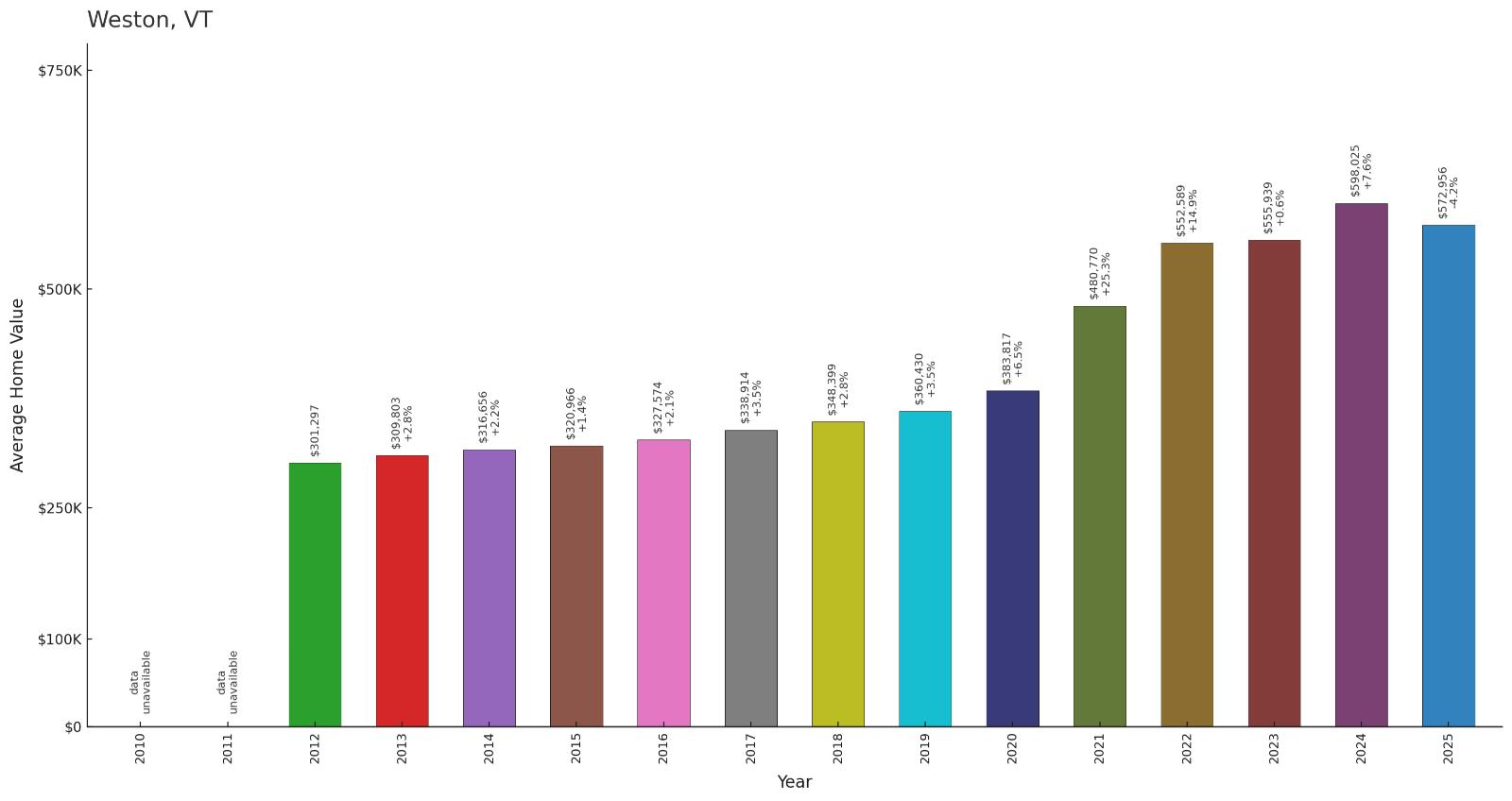
- 2010: N/A
- 2011: N/A
- 2012: $301,297
- 2013: $309,803
- 2014: $316,656
- 2015: $320,966
- 2016: $327,574
- 2017: $338,914
- 2018: $348,399
- 2019: $360,430
- 2020: $383,817
- 2021: $480,770
- 2022: $552,589
- 2023: $555,939
- 2024: $598,025
- 2025: $572,956
Weston has nearly doubled since 2012, posting 90% growth from around $301,000 to $573,000. The town maintained gradual appreciation through the 2010s before accelerating dramatically after 2020. This growth trajectory reflects Weston’s appeal as a picturesque Vermont village with cultural attractions and outdoor recreation access.
Why Weston?
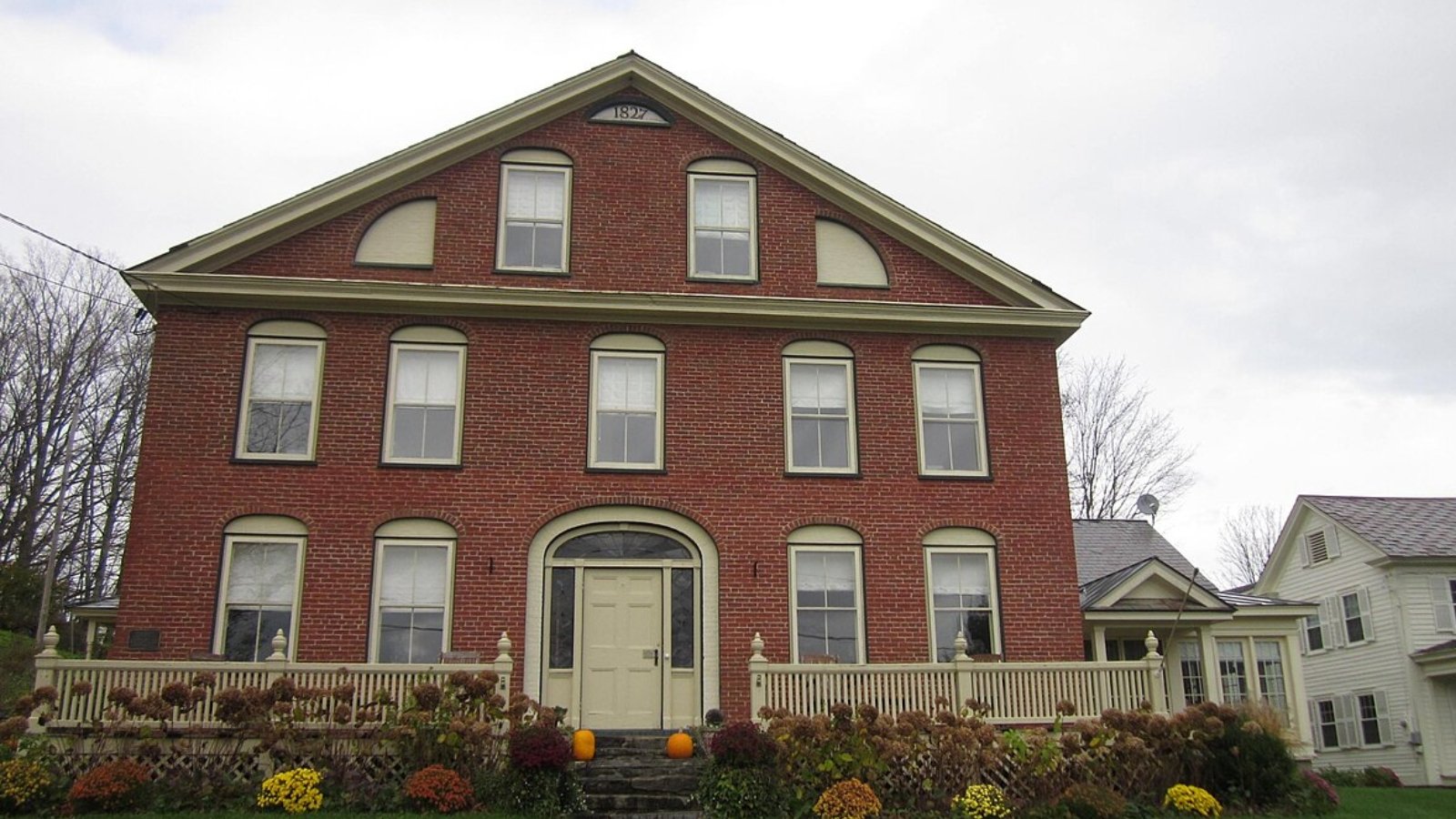
Why are people willing to pay so much to live here? What’s special about it?
Weston combines quintessential Vermont village charm with world-class cultural offerings, particularly the renowned Weston Playhouse Theatre. The town’s carefully preserved historic architecture and scenic valley setting create an ideal environment for vacation homes and retirement properties. Residents enjoy access to excellent restaurants, artisan shops, and cultural events while maintaining small-town intimacy.
The community’s commitment to preserving its character through thoughtful zoning and historic preservation attracts buyers who value authenticity and beauty. Weston’s location provides easy access to skiing at Okemo and Killington while offering hiking, fishing, and outdoor recreation in the Green Mountain National Forest.
How Weston Rose to Prominence
Weston was chartered in 1761 and developed as a typical Vermont farming community in the West River valley. The town prospered through agriculture and small-scale manufacturing throughout the 19th century, with mills powered by the West River. Like many Vermont communities, Weston experienced population decline in the early 20th century as residents moved to cities.
Weston’s renaissance began in the 1930s with the establishment of the Weston Playhouse, which attracted summer visitors and cultural tourism. The town’s commitment to historic preservation and its picture-perfect New England appearance made it a popular destination for second-home buyers and retirees. Today’s real estate market reflects Weston’s successful transformation into a culturally rich destination that maintains its agricultural and historical character.
3 Interesting Tidbits
- Weston Playhouse – Vermont’s oldest professional theater, operating since 1935, attracts thousands of visitors each summer for its acclaimed productions.
- Vermont Country Store – This famous retailer started in Weston in 1946 and still operates its flagship store in the village center.
- Historic Village Green – Weston’s classic New England common is surrounded by pristine 18th and 19th-century buildings that define Vermont’s idealized image.
22. Waitsfield – 102% Home Price Increase Since 2010
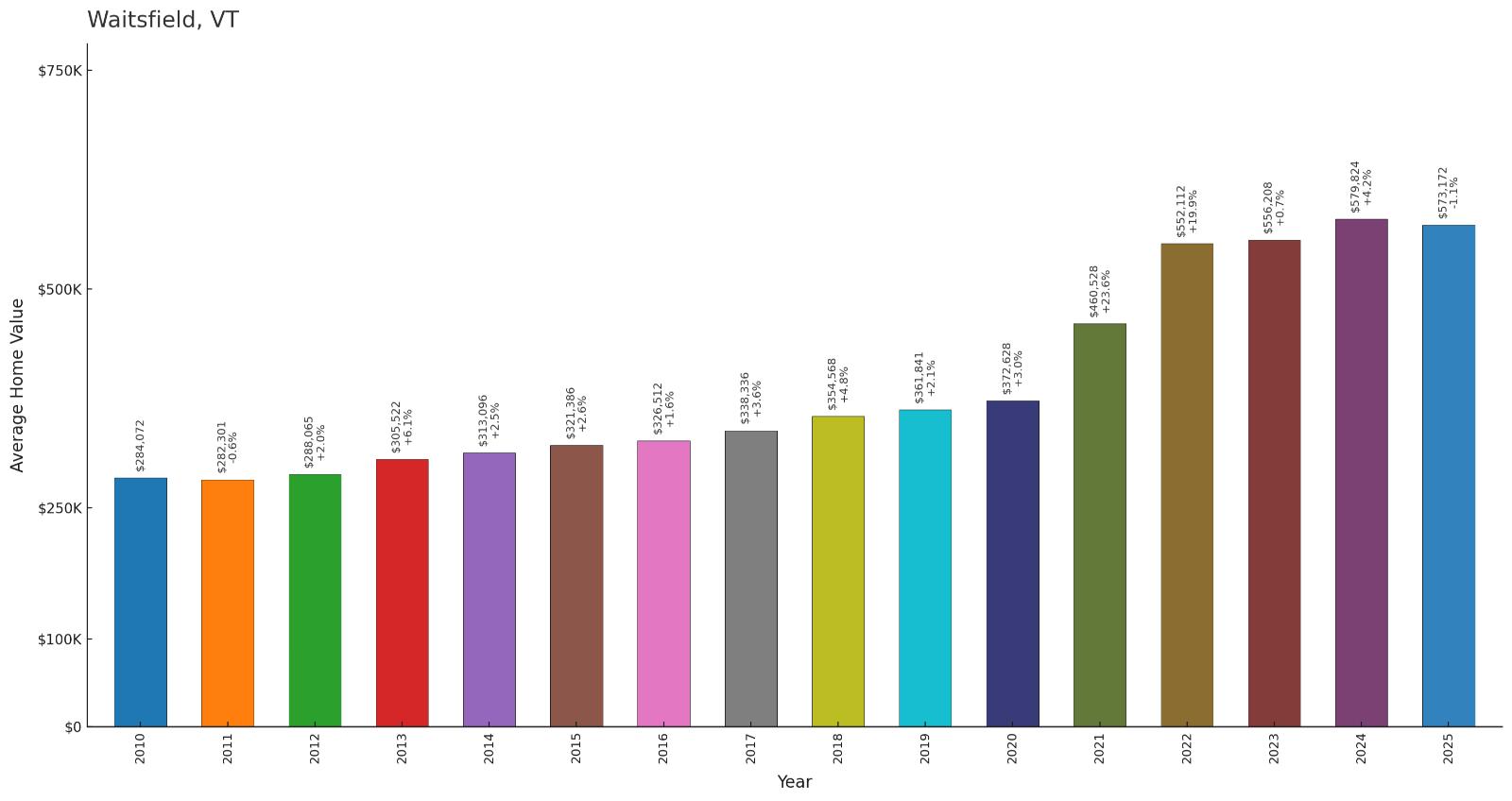
- 2010: $284,072
- 2011: $282,301
- 2012: $288,065
- 2013: $305,522
- 2014: $313,096
- 2015: $321,386
- 2016: $326,512
- 2017: $338,336
- 2018: $354,568
- 2019: $361,841
- 2020: $372,628
- 2021: $460,528
- 2022: $552,112
- 2023: $556,208
- 2024: $579,824
- 2025: $573,172
Waitsfield has achieved strong 102% growth since 2010, doubling from around $284,000 to $573,000. The town showed steady appreciation through the 2010s with acceleration during the pandemic years, particularly between 2020 and 2022. Current values reflect Waitsfield’s status as the Mad River Valley’s main town and gateway to premier skiing at Sugarbush Resort.
Why Waitsfield?
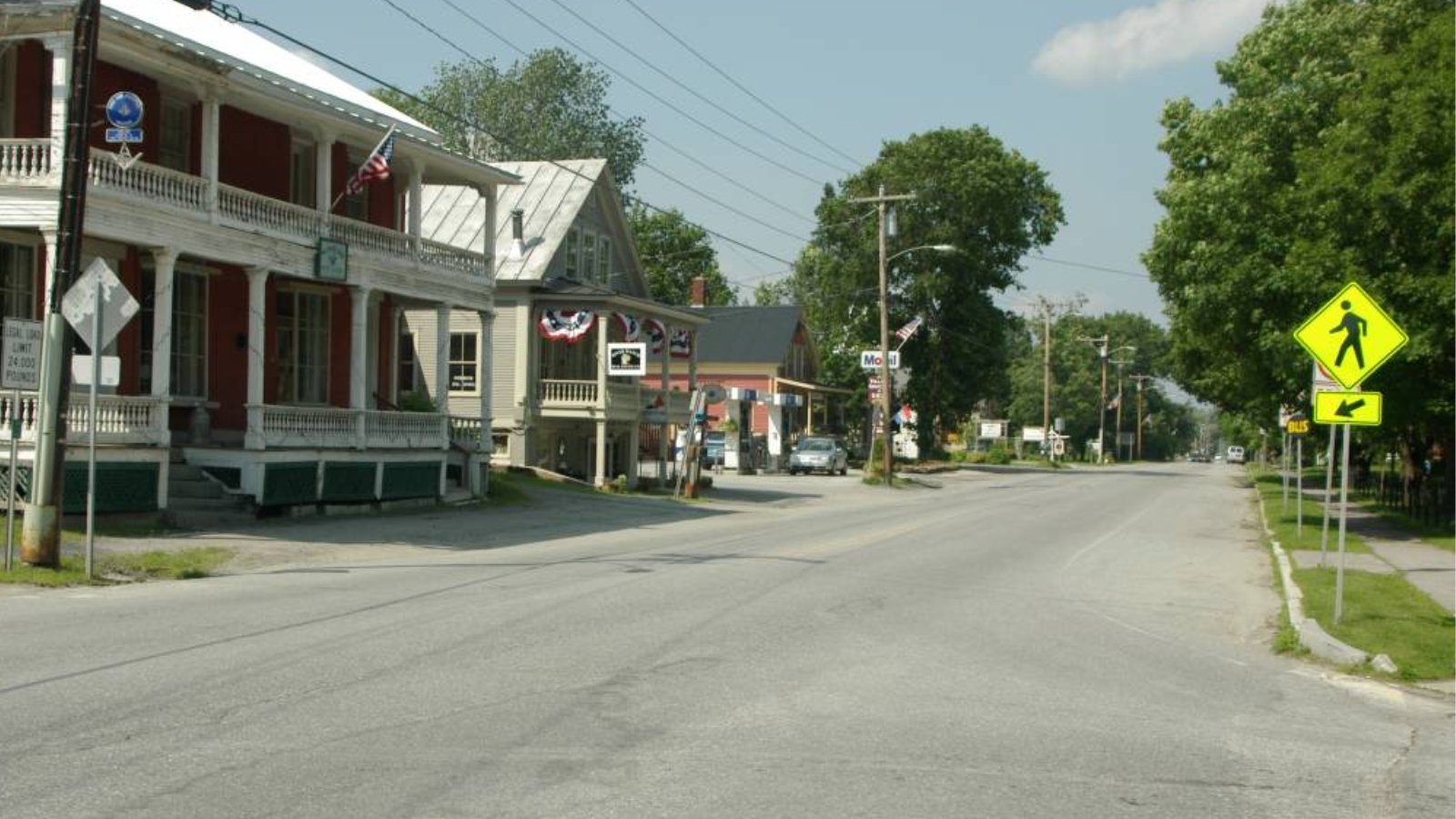
Why are people willing to pay so much to live here? What’s special about it?
Waitsfield serves as the cultural and commercial heart of the Mad River Valley, offering village amenities with immediate access to world-class skiing at Sugarbush. The town combines authentic Vermont character with sophisticated dining, shopping, and lodging that attracts affluent visitors and residents. Many properties provide mountain views and outdoor recreation access while maintaining the walkable village atmosphere that defines Vermont living.
The community hosts year-round events and festivals that create a vibrant social scene, from farmers markets to music festivals. Waitsfield’s location provides four-season recreation opportunities including skiing, hiking, mountain biking, and fishing in some of Vermont’s most scenic terrain.
How Waitsfield Rose to Prominence
Waitsfield was chartered in 1782 and developed along the Mad River as an agricultural and mill town. The fertile valley bottom supported prosperous farms while water power drove sawmills and gristmills throughout the 19th century. The town served as a regional center for surrounding mountain communities, providing services and commerce for the valley.
The development of Sugarbush Resort in 1958 transformed Waitsfield from a rural farming community into Vermont’s premier ski destination. Unlike some resort towns, Waitsfield maintained its village character and local identity while accommodating tourism growth. The town’s careful balance of development and preservation has created today’s sophisticated mountain community that attracts both recreation enthusiasts and cultural tourists.
3 Interesting Tidbits
- Covered Bridge – The historic Warren Covered Bridge, built in 1880, spans the Mad River and has become an iconic symbol of the valley.
- American Flatbread – This renowned restaurant and bakery started in Waitsfield, pioneering farm-to-table dining in Vermont’s ski country.
- Mad River Path – This scenic recreation trail follows the river through Waitsfield, providing walking and biking access to natural areas and local businesses.
21. Waterbury – 92% Home Price Increase Since 2010
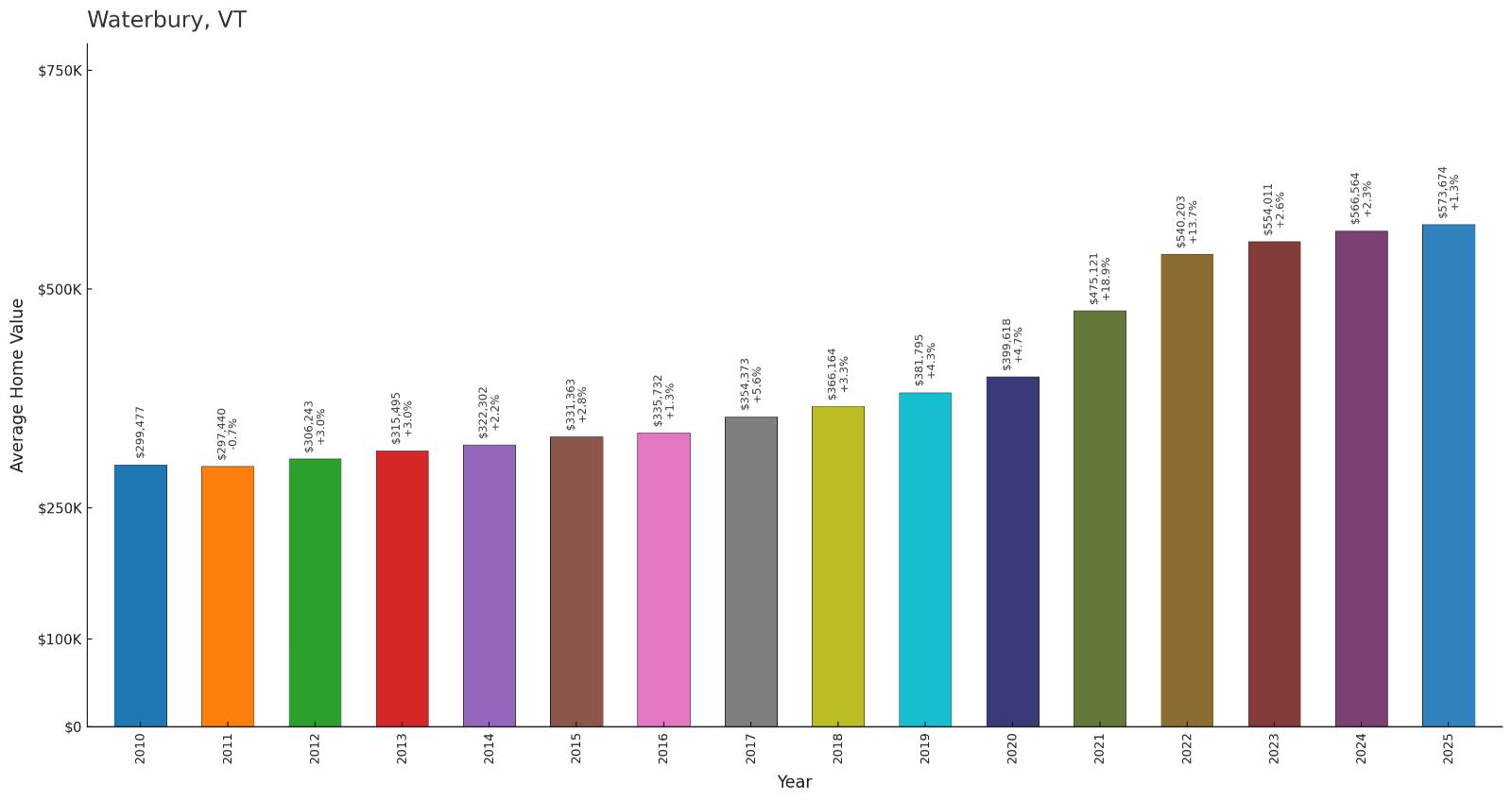
- 2010: $299,477
- 2011: $297,440
- 2012: $306,243
- 2013: $315,495
- 2014: $322,302
- 2015: $331,363
- 2016: $335,732
- 2017: $354,373
- 2018: $366,164
- 2019: $381,795
- 2020: $399,618
- 2021: $475,121
- 2022: $540,203
- 2023: $554,011
- 2024: $566,564
- 2025: $573,674
Waterbury has nearly doubled since 2010, achieving 92% growth from around $299,000 to $574,000. The town maintained steady appreciation through the 2010s before experiencing significant acceleration during the pandemic period. Current prices reflect Waterbury’s position as a regional center with outdoor recreation access and proximity to major ski resorts.
Why Waterbury?
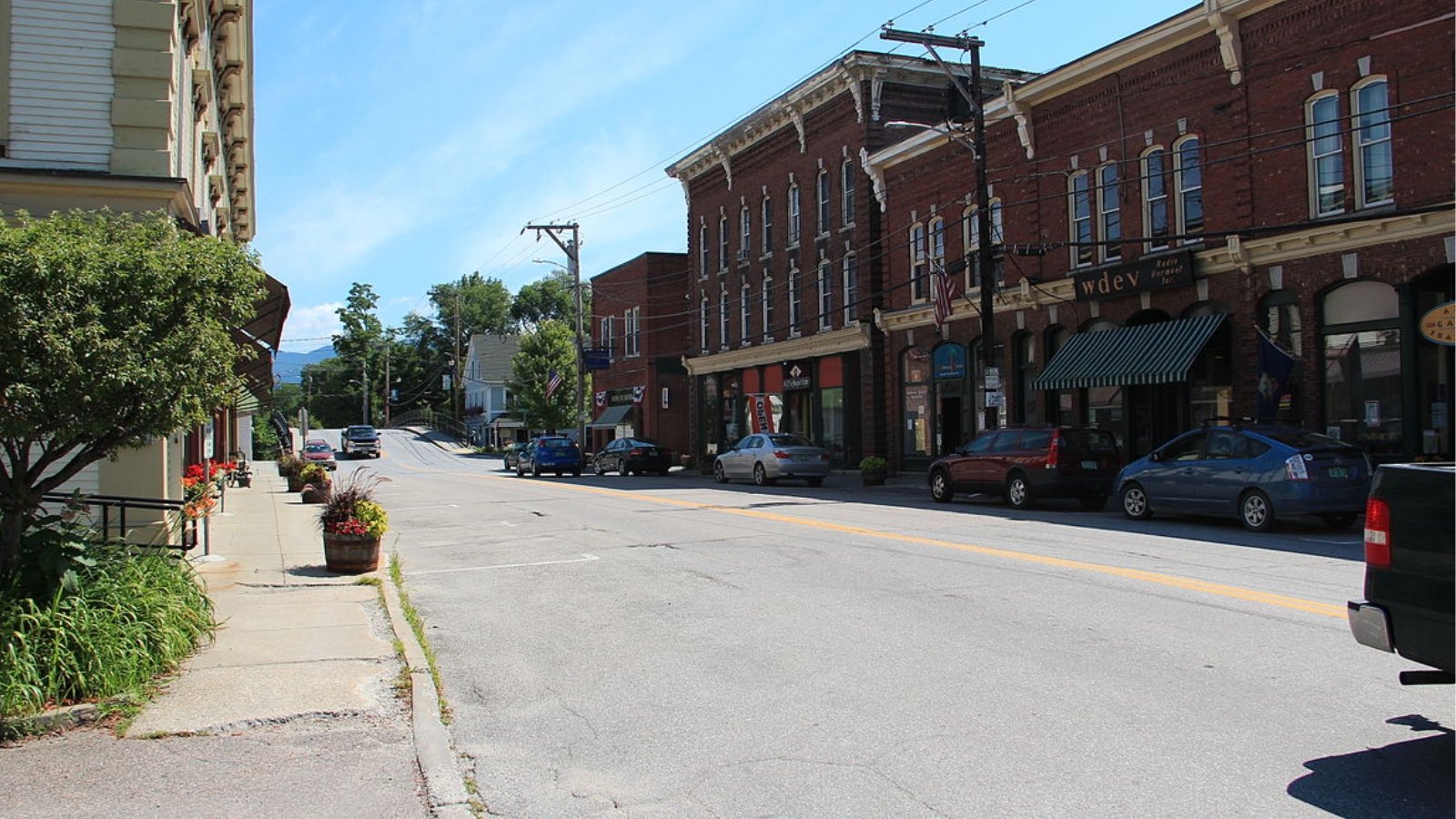
Why are people willing to pay so much to live here? What’s special about it?
Waterbury offers the perfect balance of small-town charm and modern amenities, with excellent restaurants, breweries, and cultural attractions that rival much larger communities. The town provides easy access to Stowe Mountain Resort and other Green Mountain recreation while maintaining its own distinct identity and local economy. Residents enjoy walkable village life with access to employment opportunities in tourism, agriculture, and small business.
The community’s commitment to local food and craft beverage production has created a sophisticated culinary scene that attracts visitors and residents alike. Waterbury’s location at the intersection of major valleys provides convenient access to both mountain recreation and Vermont’s cultural centers.
How Waterbury Rose to Prominence
Waterbury was chartered in 1763 and developed as a regional center in the Winooski River valley. The town’s location at the confluence of several valleys made it a natural hub for transportation and commerce throughout the 19th century. Railroad connections enhanced Waterbury’s role as a service center for surrounding agricultural and logging communities.
The establishment of the Vermont State Hospital in Waterbury in 1891 brought steady employment and population growth. In recent decades, Waterbury has reinvented itself as a destination for craft brewing, artisanal food production, and outdoor recreation tourism. The town’s success in balancing economic development with historic preservation has created today’s vibrant community that attracts both residents and visitors.
3 Interesting Tidbits
- Ben & Jerry’s Factory – The famous ice cream company’s original factory operates in Waterbury, offering tours and serving as a major tourist attraction.
- Cold Hollow Cider Mill – This working cider mill produces fresh cider and cider donuts, continuing Waterbury’s agricultural traditions.
- Cabot Annex Store – The cooperative’s retail outlet showcases Vermont’s award-winning cheeses and supports local dairy farmers.
20. Jericho – 91% Home Price Increase Since 2010

- 2010: $302,691
- 2011: $313,332
- 2012: $309,153
- 2013: $317,256
- 2014: $332,358
- 2015: $332,329
- 2016: $336,634
- 2017: $361,349
- 2018: $377,593
- 2019: $389,306
- 2020: $406,864
- 2021: $474,631
- 2022: $540,247
- 2023: $548,340
- 2024: $570,054
- 2025: $576,648
Jericho has posted solid 91% growth since 2010, rising from around $303,000 to nearly $577,000. The town experienced steady but moderate appreciation through most of the 2010s before accelerating significantly during the pandemic years. Current values reflect Jericho’s appeal as a family-friendly community with excellent schools and outdoor recreation access.
Why Jericho?
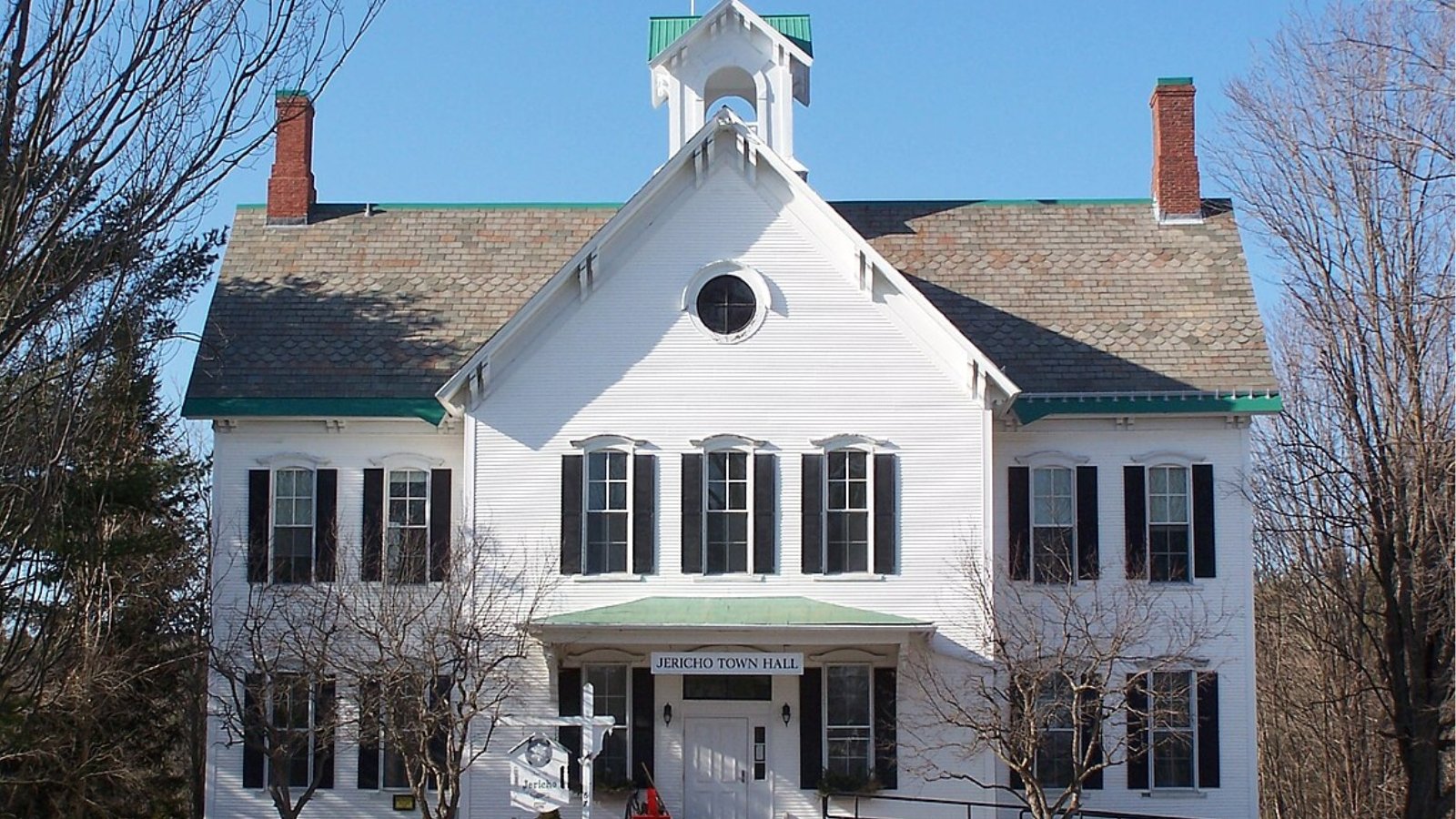
Why are people willing to pay so much to live here? What’s special about it?
Jericho attracts families seeking excellent schools, outdoor recreation, and small-town safety while maintaining reasonable commuting distance to Burlington. The town offers extensive trail systems, parks, and natural areas that support an active lifestyle year-round. Many residents work in Burlington or other Chittenden County communities while enjoying Jericho’s rural atmosphere and community spirit.
The community maintains strong local traditions including town meetings, volunteer organizations, and community events that create genuine connections among residents. Jericho’s location provides access to both Green Mountain recreation and Lake Champlain activities while preserving agricultural land and forest cover.
How Jericho Rose to Prominence
Jericho was chartered in 1763 and developed as an agricultural community in the Winooski River valley. The town’s fertile soils and water power supported farming and small-scale manufacturing throughout the 19th century. Mills along the Browns River processed local agricultural products and provided employment for rural residents.
Beginning in the mid-20th century, Jericho evolved into a bedroom community for Burlington-area workers seeking rural living with urban employment access. The town’s excellent school system and family-friendly atmosphere attracted professionals who valued education and community involvement. This residential development pattern has driven Jericho’s real estate appreciation and current market position.
3 Interesting Tidbits
- Old Red Mill – This historic gristmill, built in 1855, now houses a museum showcasing local history and traditional crafts.
- Jericho Center Country Store – This community gathering place has served residents since the 1800s and continues as a local institution.
- Mount Mansfield State Forest – Much of Jericho borders this protected forest, providing hiking trails and natural areas for residents.
19. Hinesburg – 89% Home Price Increase Since 2012
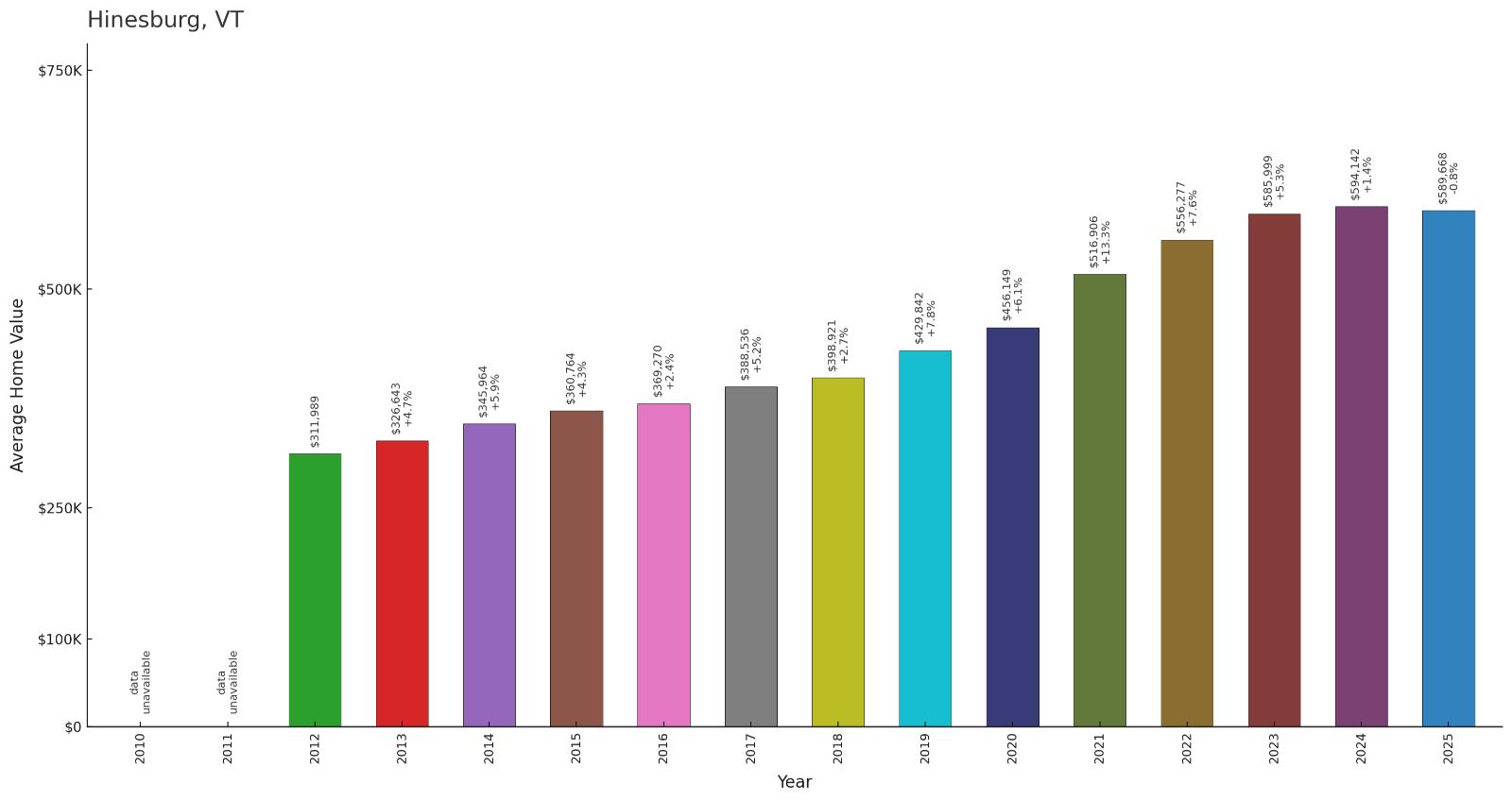
- 2010: N/A
- 2011: N/A
- 2012: $311,989
- 2013: $326,643
- 2014: $345,964
- 2015: $360,764
- 2016: $369,270
- 2017: $388,536
- 2018: $398,921
- 2019: $429,842
- 2020: $456,149
- 2021: $516,906
- 2022: $556,277
- 2023: $585,999
- 2024: $594,142
- 2025: $589,668
Hinesburg has achieved strong 89% growth since 2012, climbing from around $312,000 to nearly $590,000. The town showed consistent appreciation throughout the period with particular acceleration during the pandemic years. Current values reflect Hinesburg’s popularity as a family-oriented community with excellent schools and convenient location between Burlington and the Green Mountains.
Why Hinesburg?
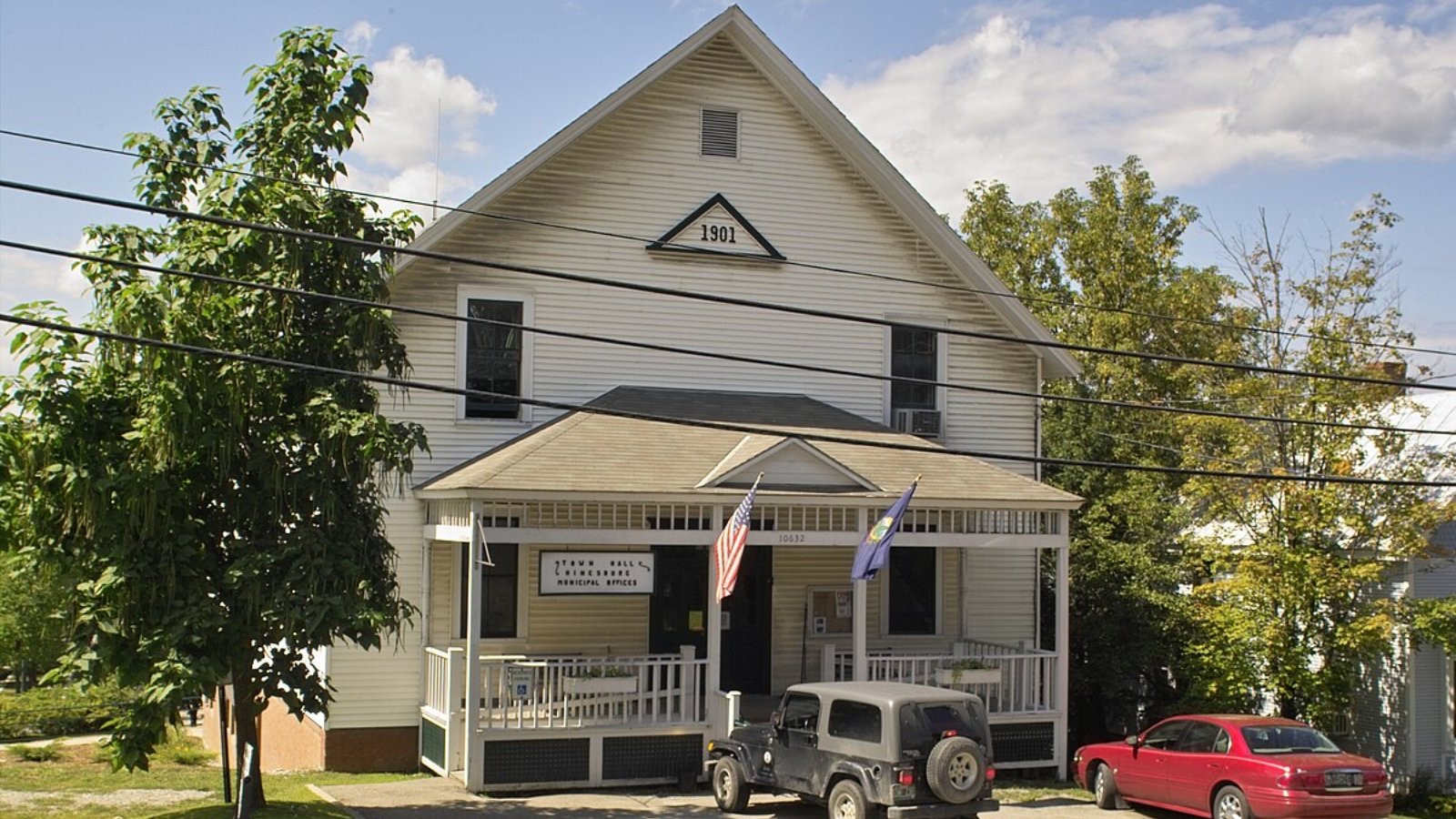
Why are people willing to pay so much to live here? What’s special about it?
Hinesburg provides an ideal combination of rural character and suburban convenience that appeals particularly to families with children. The town offers excellent schools, extensive recreational facilities, and strong community programs while maintaining easy access to Burlington employment and cultural opportunities. Many properties feature larger lots and newer construction that attracts buyers seeking modern amenities in a small-town setting.
The community’s commitment to balanced growth and environmental protection has preserved natural areas and agricultural land while accommodating residential development. Hinesburg’s location provides access to hiking, skiing, and Lake Champlain recreation while maintaining the peaceful atmosphere that draws families from urban areas.
How Hinesburg Rose to Prominence
Hinesburg was chartered in 1762 and developed as an agricultural community in the fertile Champlain Valley. The town’s excellent soils supported prosperous dairy farms and crop production throughout the 19th and early 20th centuries. Like many Vermont towns, Hinesburg experienced population decline during the early industrial period as residents moved to cities.
Beginning in the 1960s, Hinesburg transformed into a growing suburban community as Burlington-area development expanded into surrounding towns. The town’s excellent school system, family-friendly atmosphere, and careful planning attracted professionals seeking quality of life outside the city. This suburban growth pattern, combined with Hinesburg’s natural amenities, has driven the real estate appreciation seen in recent decades.
3 Interesting Tidbits
- Hinesburg Community School – This highly-rated K-8 school consistently ranks among Vermont’s top elementary schools and serves as a major community gathering place.
- Geprags Community Park – This 58-acre park provides fields, trails, and facilities for youth sports and community events throughout the year.
- LaPlatte River – This scenic waterway flows through Hinesburg, providing fishing opportunities and powering historic mill sites in the town center.
18. Williston – 107% Home Price Increase Since 2010
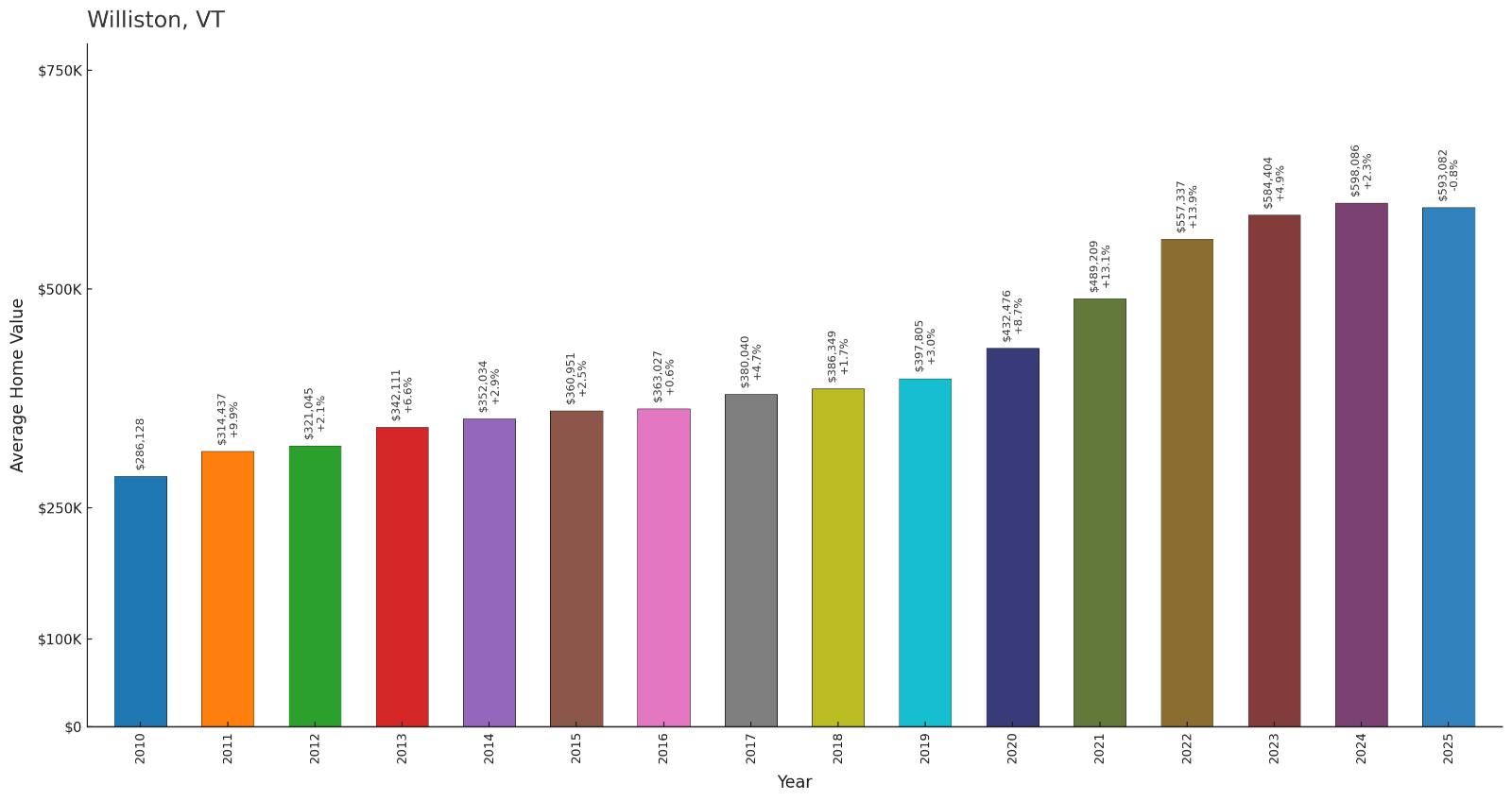
- 2010: $286,128
- 2011: $314,437
- 2012: $321,045
- 2013: $342,111
- 2014: $352,034
- 2015: $360,951
- 2016: $363,027
- 2017: $380,040
- 2018: $386,349
- 2019: $397,805
- 2020: $432,476
- 2021: $489,209
- 2022: $557,337
- 2023: $584,404
- 2024: $598,086
- 2025: $593,082
Williston has more than doubled since 2010, achieving 107% growth from around $286,000 to $593,000. The town maintained steady appreciation through the 2010s before experiencing significant acceleration during the pandemic period. Current values reflect Williston’s status as Chittenden County’s fastest-growing community with excellent amenities and strategic location.
Why Williston?
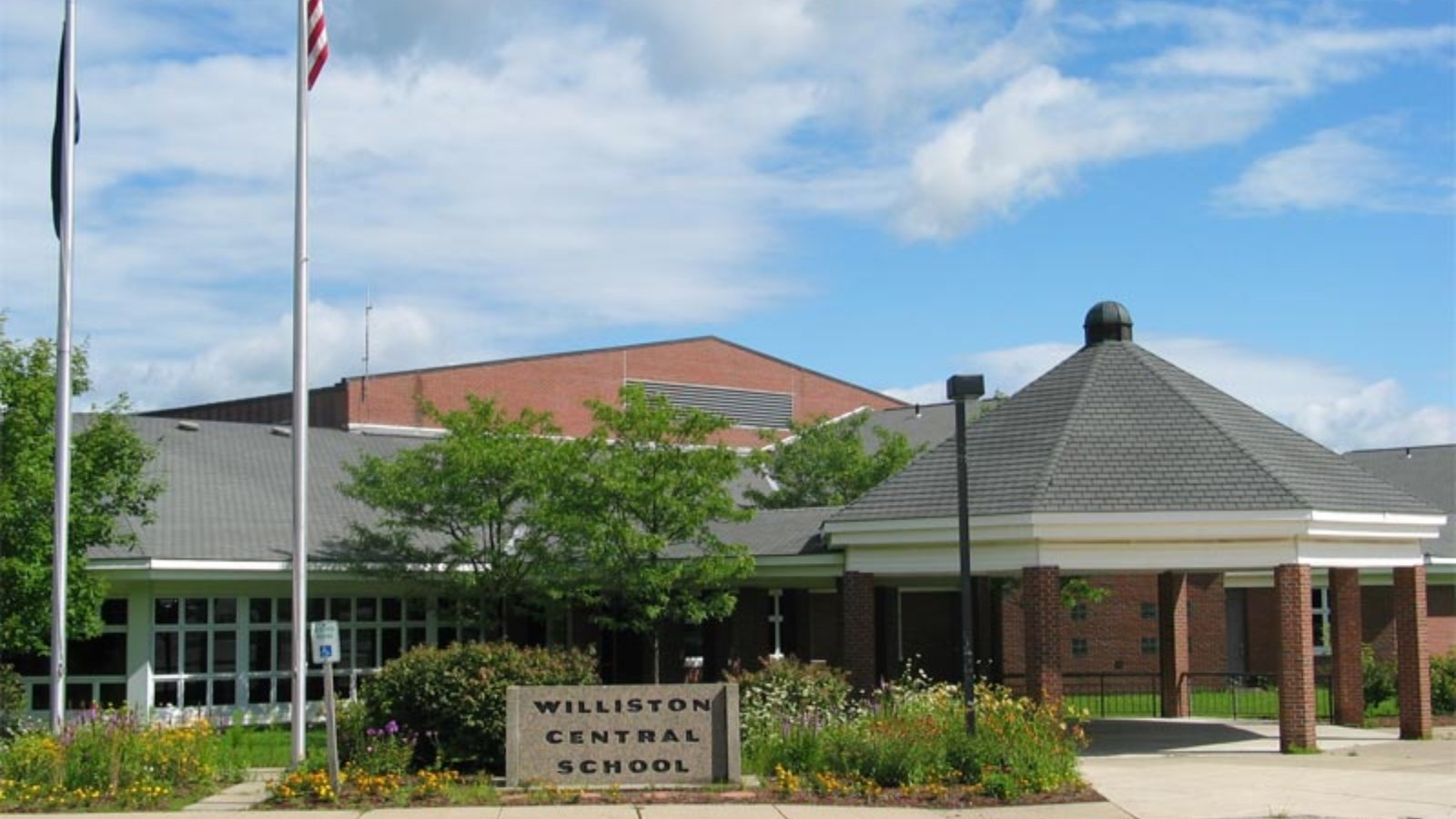
Why are people willing to pay so much to live here? What’s special about it?
Williston offers modern suburban living with excellent schools, shopping, and recreational facilities that attract families throughout the region. The town provides easy access to Burlington while maintaining newer infrastructure and planned development that creates a contemporary living environment. Many residents appreciate Williston’s balance of convenience and community atmosphere.
The community features extensive recreational facilities including parks, trails, and sports complexes that support active lifestyles. Williston’s location provides quick access to both downtown Burlington and Green Mountain recreation while offering modern amenities and services.
How Williston Rose to Prominence
Williston was chartered in 1763 and remained primarily agricultural until the late 20th century. The town’s location in the fertile Champlain Valley supported dairy farming and crop production, with small villages serving local needs. Williston’s character began changing dramatically in the 1980s and 1990s as Burlington-area development expanded.
The construction of major retail centers, business parks, and residential subdivisions transformed Williston from a rural farming community into Chittenden County’s commercial and residential growth center. The town’s modern infrastructure, excellent schools, and planned development have attracted families and businesses seeking contemporary amenities with Vermont location advantages.
3 Interesting Tidbits
- Williston Central School – This modern K-8 school serves as a model for educational excellence and community engagement in Vermont.
- Taft Corners – This major retail and commercial center serves the entire region with shopping, dining, and business services.
- Muddy Brook Recreation Area – This popular park provides trails, fields, and natural areas for outdoor recreation and community events.
17. Richmond – 77% Home Price Increase Since 2012

- 2010: N/A
- 2011: N/A
- 2012: $339,370
- 2013: $355,608
- 2014: $362,736
- 2015: $373,107
- 2016: $379,654
- 2017: $394,522
- 2018: $406,291
- 2019: $422,726
- 2020: $450,810
- 2021: $506,809
- 2022: $564,577
- 2023: $583,997
- 2024: $591,465
- 2025: $600,723
Richmond has achieved solid 77% growth since 2012, rising from around $339,000 to over $600,000. The town showed steady appreciation through the 2010s with acceleration during recent years, culminating in current values that reflect Richmond’s appeal as a picturesque village with outdoor recreation access and convenient location.
Why Richmond?
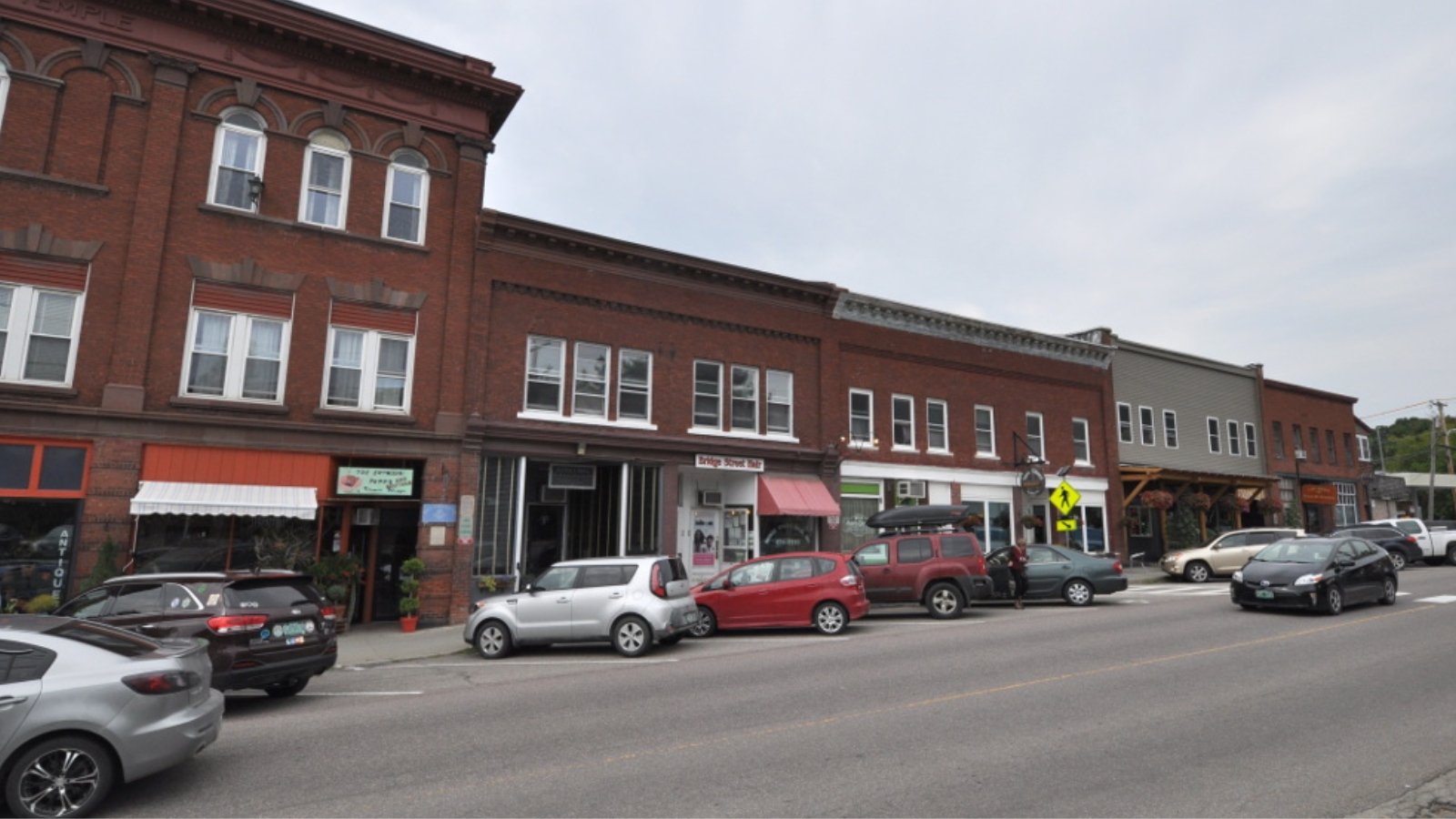
Why are people willing to pay so much to live here? What’s special about it?
Richmond combines historic village charm with excellent outdoor recreation access, particularly the popular Winooski River and surrounding natural areas. The town offers a walkable village center with local businesses while providing easy access to both Burlington and Green Mountain recreation. Many residents value Richmond’s balance of community character and convenient location for work and recreation.
The community maintains strong local traditions and volunteer organizations that create genuine connections among residents. Richmond’s location along the Winooski River provides water recreation opportunities while nearby forests and trails offer hiking and outdoor activities throughout the year.
How Richmond Rose to Prominence
Richmond was chartered in 1794 and developed as a mill town along the Winooski River. The town’s water power supported various industries including gristmills, sawmills, and small manufacturing throughout the 19th century. Richmond served as a regional center for surrounding agricultural communities, providing services and commerce for the Winooski Valley.
The town’s compact village design and historic architecture attracted preservation-minded residents beginning in the mid-20th century. Richmond’s proximity to Burlington and access to outdoor recreation made it increasingly popular with professionals seeking small-town living with urban employment opportunities. The town’s careful preservation of its historic character while accommodating modern needs has created today’s attractive real estate market.
3 Interesting Tidbits
- Richmond Round Church – This unique 16-sided community church, built in 1813, serves as an iconic symbol of Vermont architecture and ecumenical cooperation.
- Winooski Valley Park District – Richmond serves as headquarters for this regional park system that maintains trails and natural areas throughout the valley.
- Old Round Church Center – This community center hosts concerts, events, and gatherings that bring together residents and visitors throughout the year.
16. Underhill – 70% Home Price Increase Since 2012

- 2010: N/A
- 2011: N/A
- 2012: $356,648
- 2013: $371,577
- 2014: $383,698
- 2015: $392,527
- 2016: $409,698
- 2017: $423,619
- 2018: $433,091
- 2019: $453,407
- 2020: $486,059
- 2021: $559,002
- 2022: $611,774
- 2023: $635,043
- 2024: $638,361
- 2025: $605,532
Underhill has achieved steady 70% growth since 2012, rising from around $357,000 to over $605,000. The town maintained consistent appreciation through the 2010s before experiencing significant acceleration during the pandemic years. Current values reflect Underhill’s appeal as a mountain community with direct access to Mount Mansfield recreation and proximity to Burlington.
Why Underhill?
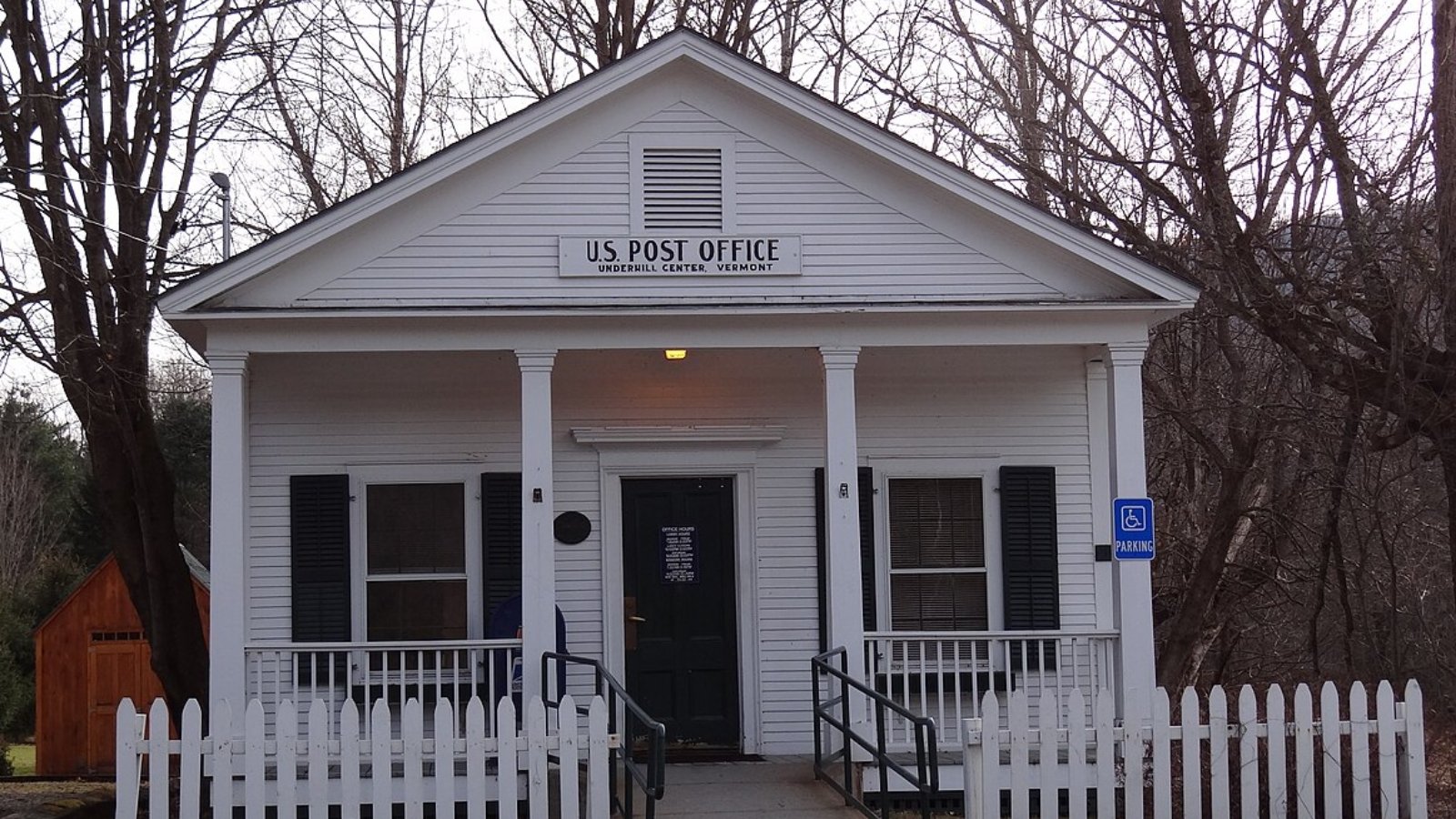
Why are people willing to pay so much to live here? What’s special about it?
Underhill provides unparalleled access to Mount Mansfield State Forest and Vermont’s premier hiking and outdoor recreation opportunities. The town offers mountain properties with spectacular views and direct trail access while maintaining reasonable proximity to Burlington for employment and cultural activities. Many residents are outdoor enthusiasts who value year-round recreation access and mountain living.
The community maintains a strong conservation ethic and rural character that appeals to environmentally conscious buyers. Underhill’s location at the base of Vermont’s highest peak provides unique recreational opportunities while preserving natural areas and agricultural land that define the town’s character.
How Underhill Rose to Prominence
Underhill was chartered in 1763 and developed as an agricultural community in the shadow of Mount Mansfield. The town’s mountainous terrain limited farming to valley areas, while forests provided timber and seasonal employment. Unlike flatter Vermont communities, Underhill remained largely rural due to its challenging topography.
The development of hiking and skiing on Mount Mansfield beginning in the early 20th century gradually brought recreation-focused residents to Underhill. The establishment of Mount Mansfield State Forest preserved much of the town’s mountain terrain while providing public recreation access. This combination of mountain recreation and conservation has attracted outdoor enthusiasts and created today’s premium real estate market focused on mountain properties and recreational access.
3 Interesting Tidbits
- Mount Mansfield – Vermont’s highest peak rises directly from Underhill, providing hiking trails and scenic vistas accessible from town properties.
- Underhill State Park – This popular park provides camping and hiking access to Mount Mansfield’s summit and ridge trails.
- Nebraska Notch – This remote mountain pass provides access to backcountry hiking and connects Underhill to Stowe through scenic wilderness terrain.
15. Ludlow – 86% Home Price Increase Since 2010
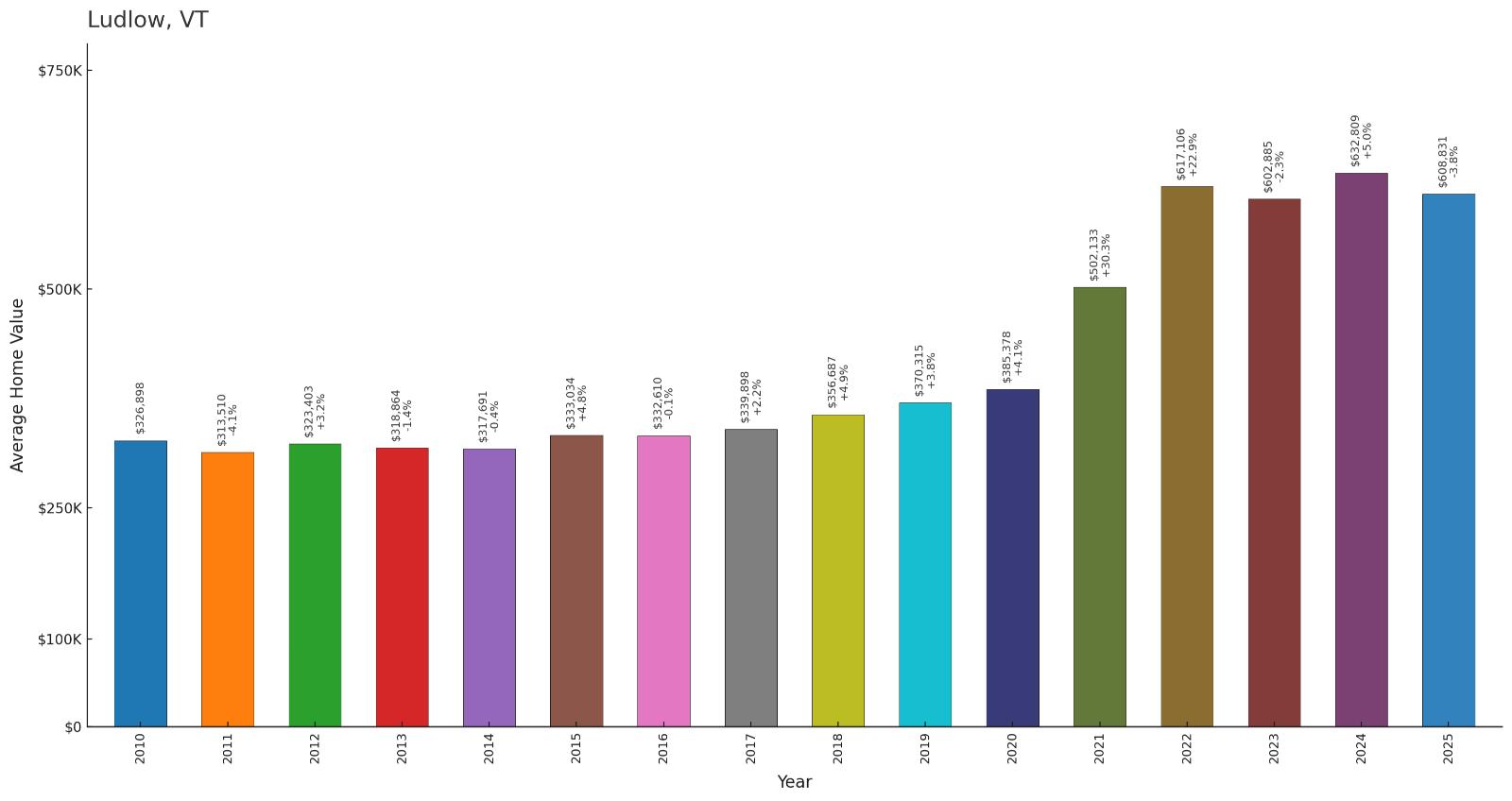
- 2010: $326,898
- 2011: $313,510
- 2012: $323,403
- 2013: $318,864
- 2014: $317,691
- 2015: $333,034
- 2016: $332,610
- 2017: $339,898
- 2018: $356,687
- 2019: $370,315
- 2020: $385,378
- 2021: $502,133
- 2022: $617,106
- 2023: $602,885
- 2024: $632,809
- 2025: $608,831
Ludlow has posted strong 86% growth since 2010, rising from around $327,000 to nearly $609,000. The town showed relatively modest gains through most of the 2010s before experiencing dramatic acceleration during the pandemic years. Current values reflect Ludlow’s position as a major ski destination with Okemo Mountain Resort and recreational opportunities.
Why Ludlow?
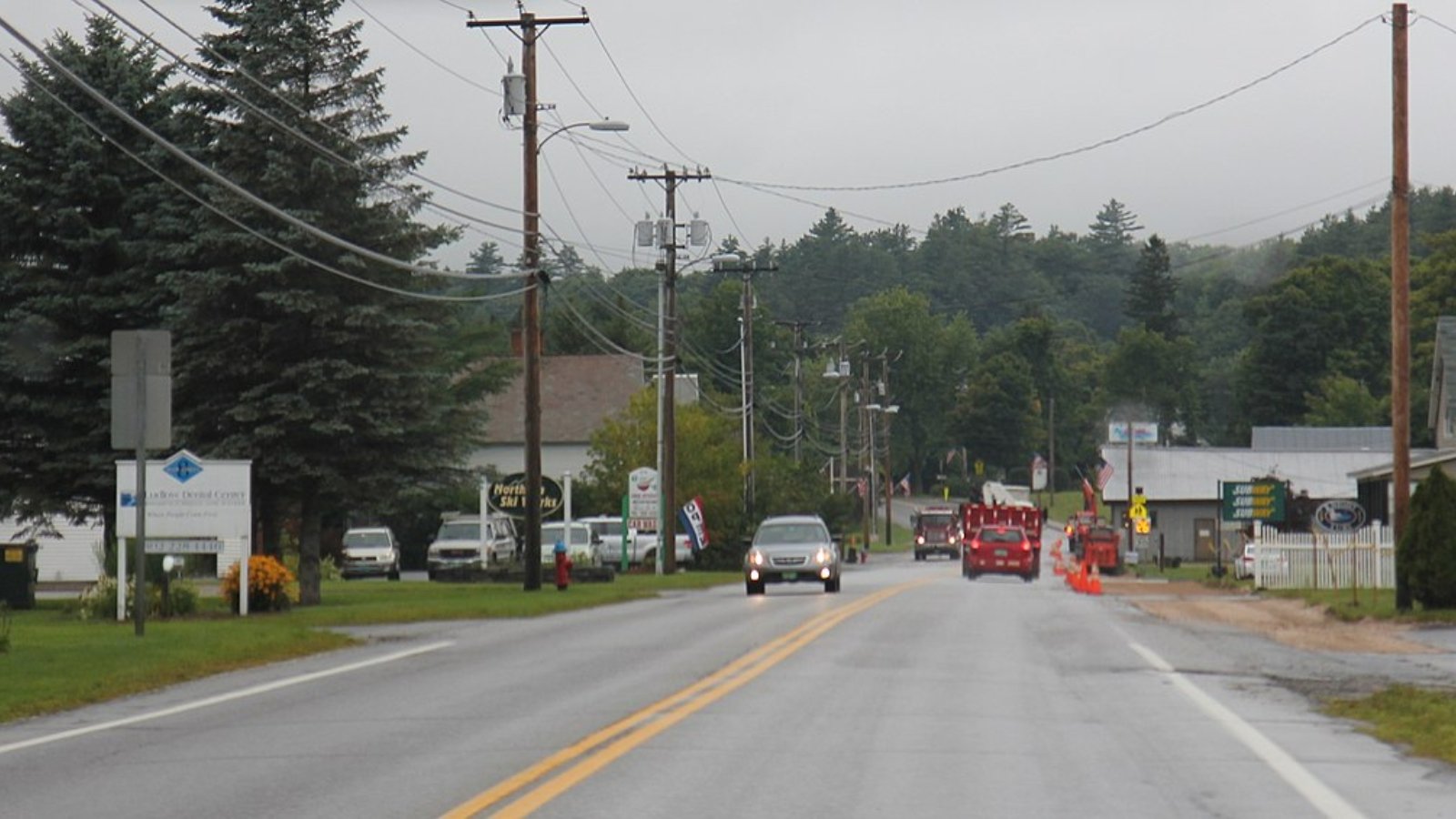
Why are people willing to pay so much to live here? What’s special about it?
Ludlow centers around Okemo Mountain Resort, one of Vermont’s premier ski destinations known for excellent snowmaking and family-friendly amenities. The town offers ski-in/ski-out properties and vacation homes that provide direct access to alpine recreation while maintaining a authentic Vermont village atmosphere. Many buyers are drawn to Ludlow’s four-season recreation opportunities and established tourism infrastructure.
The community balances resort development with historic preservation, maintaining its mill town character while accommodating modern recreation needs. Ludlow’s location provides access to other southern Vermont ski areas while offering hiking, fishing, and outdoor activities throughout the warmer months.
How Ludlow Rose to Prominence
Ludlow was chartered in 1761 and developed as a mill town along the Black River. The town’s abundant water power supported various industries including textiles, wood products, and machine manufacturing throughout the 19th and early 20th centuries. Ludlow Mills became one of Vermont’s major industrial employers, producing woolen goods for national markets.
The development of Okemo Mountain as a ski area in 1955 began Ludlow’s transformation from industrial town to recreation destination. As manufacturing declined, tourism and recreation became increasingly important to the local economy. Okemo’s expansion and modernization, combined with Ludlow’s preserved village character, has created today’s ski town real estate market that attracts vacation home buyers and recreation enthusiasts.
3 Interesting Tidbits
- Okemo Mountain Resort – This major ski area features 121 trails and terrain parks, making it one of southern Vermont’s premier winter destinations.
- Black River – This scenic waterway powered Ludlow’s historic mills and now provides fishing and recreation opportunities through the town center.
- Ludlow Mills Historic District – The preserved mill buildings showcase Vermont’s industrial heritage and now house shops, restaurants, and community facilities.
14. Cornwall – 85% Home Price Increase Since 2010

- 2010: $332,301
- 2011: $343,805
- 2012: $357,969
- 2013: $385,753
- 2014: $398,899
- 2015: $399,067
- 2016: $404,740
- 2017: $423,750
- 2018: $450,913
- 2019: $475,825
- 2020: $492,208
- 2021: $565,958
- 2022: $634,212
- 2023: $633,664
- 2024: $652,151
- 2025: $614,094
Cornwall has achieved solid 85% growth since 2010, rising from around $332,000 to over $614,000. The town showed steady appreciation through the 2010s with particularly strong gains during the pandemic years. Current values reflect Cornwall’s appeal as an upscale rural community with proximity to Middlebury and exceptional natural amenities.
Why Cornwall?
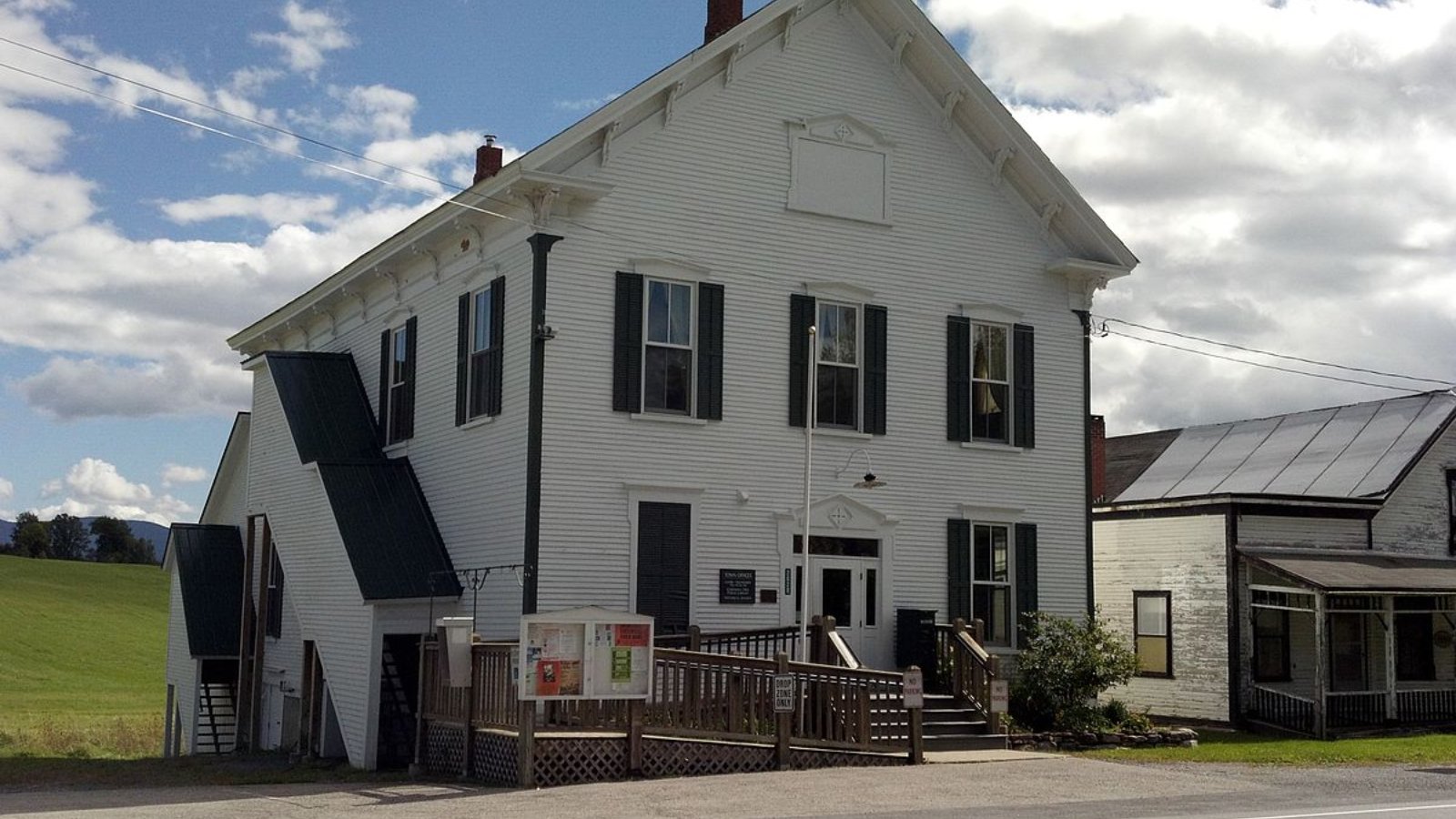
Why are people willing to pay so much to live here? What’s special about it?
Cornwall attracts affluent buyers seeking rural elegance and proximity to Middlebury College’s cultural offerings. The town features expansive properties with mountain views, horse farms, and agricultural preservation that creates an exclusive countryside atmosphere. Many residents are connected to academia or seek sophisticated rural living with access to educational and cultural amenities.
The community offers excellent recreational opportunities including hiking trails, fishing streams, and proximity to Lake Champlain activities. Cornwall’s commitment to land conservation and agricultural preservation ensures the pastoral character that attracts premium buyers seeking authentic Vermont countryside living.
How Cornwall Rose to Prominence
Cornwall was chartered in 1761 and developed as one of the Champlain Valley’s premier agricultural communities. The town’s fertile soils and favorable climate made it ideal for diversified farming, particularly dairy operations and specialty crops. Throughout the 19th century, Cornwall farmers supplied regional markets while maintaining substantial landholdings.
The presence of nearby Middlebury College, founded in 1800, has long influenced Cornwall’s character and attracted educated residents who value rural living with cultural access. The town’s agricultural preservation efforts and resistance to suburban development have maintained its exclusive rural character. This combination of preserved agriculture, natural beauty, and proximity to educational institutions has created today’s premium real estate market.
3 Interesting Tidbits
- Cornwall Swamp Wildlife Management Area – This 1,200-acre preserve protects important wetlands and provides wildlife viewing and hunting opportunities.
- Lemon Fair River – This scenic waterway flows through Cornwall, providing fishing opportunities and powering historic mill sites.
- Agricultural Heritage – Cornwall maintains active dairy farms and agricultural operations that preserve the rural character prized by residents.
13. South Hero – 66% Home Price Increase Since 2010
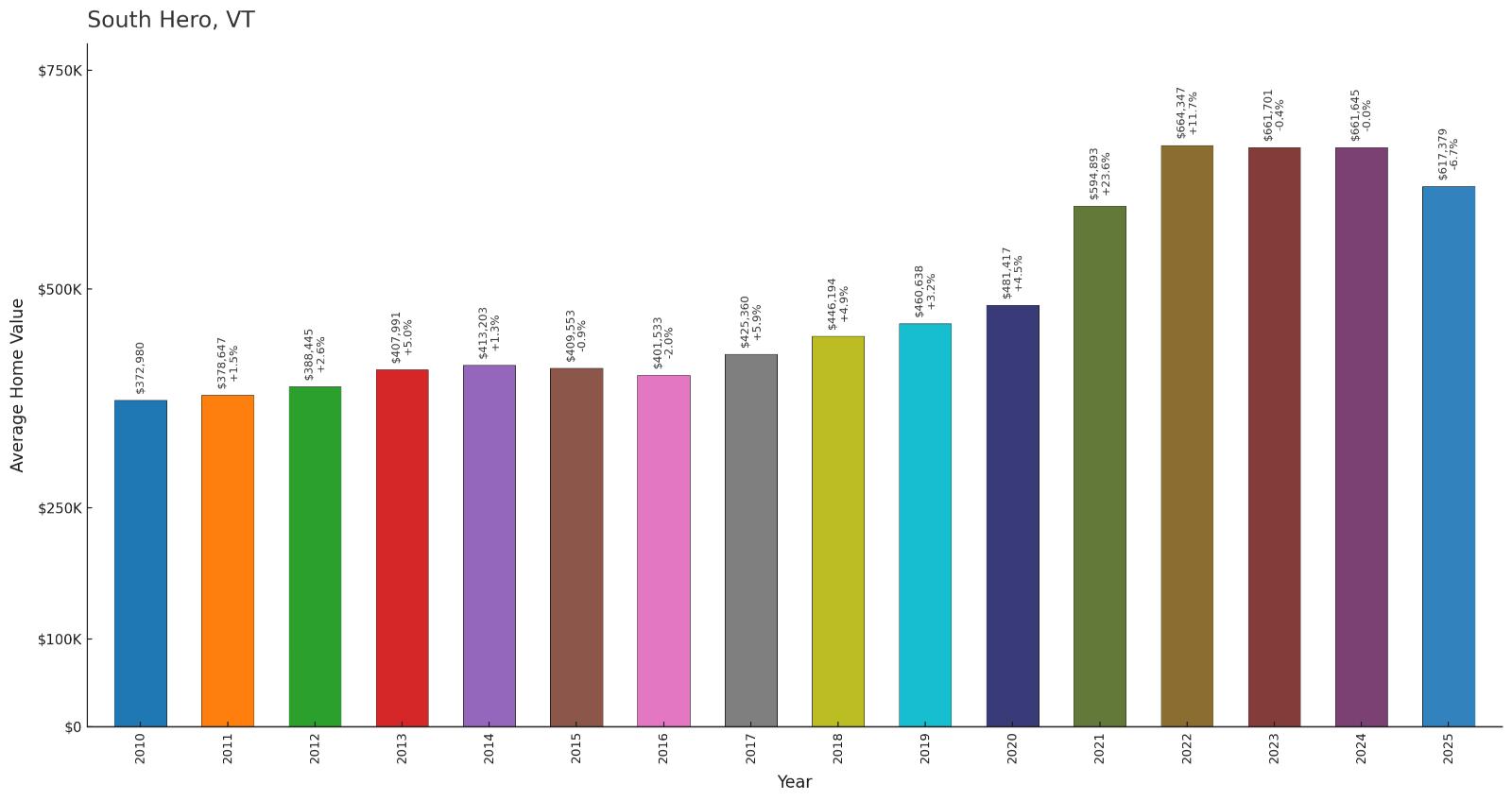
- 2010: $372,980
- 2011: $378,647
- 2012: $388,445
- 2013: $407,991
- 2014: $413,203
- 2015: $409,553
- 2016: $401,533
- 2017: $425,360
- 2018: $446,194
- 2019: $460,638
- 2020: $481,417
- 2021: $594,893
- 2022: $664,347
- 2023: $661,701
- 2024: $661,645
- 2025: $617,379
South Hero has achieved steady 66% growth since 2010, rising from around $373,000 to over $617,000. The town showed gradual appreciation through the 2010s with significant acceleration during the pandemic years, particularly between 2020 and 2022. Current values reflect South Hero’s premium island location and extensive Lake Champlain waterfront access.
Why South Hero?
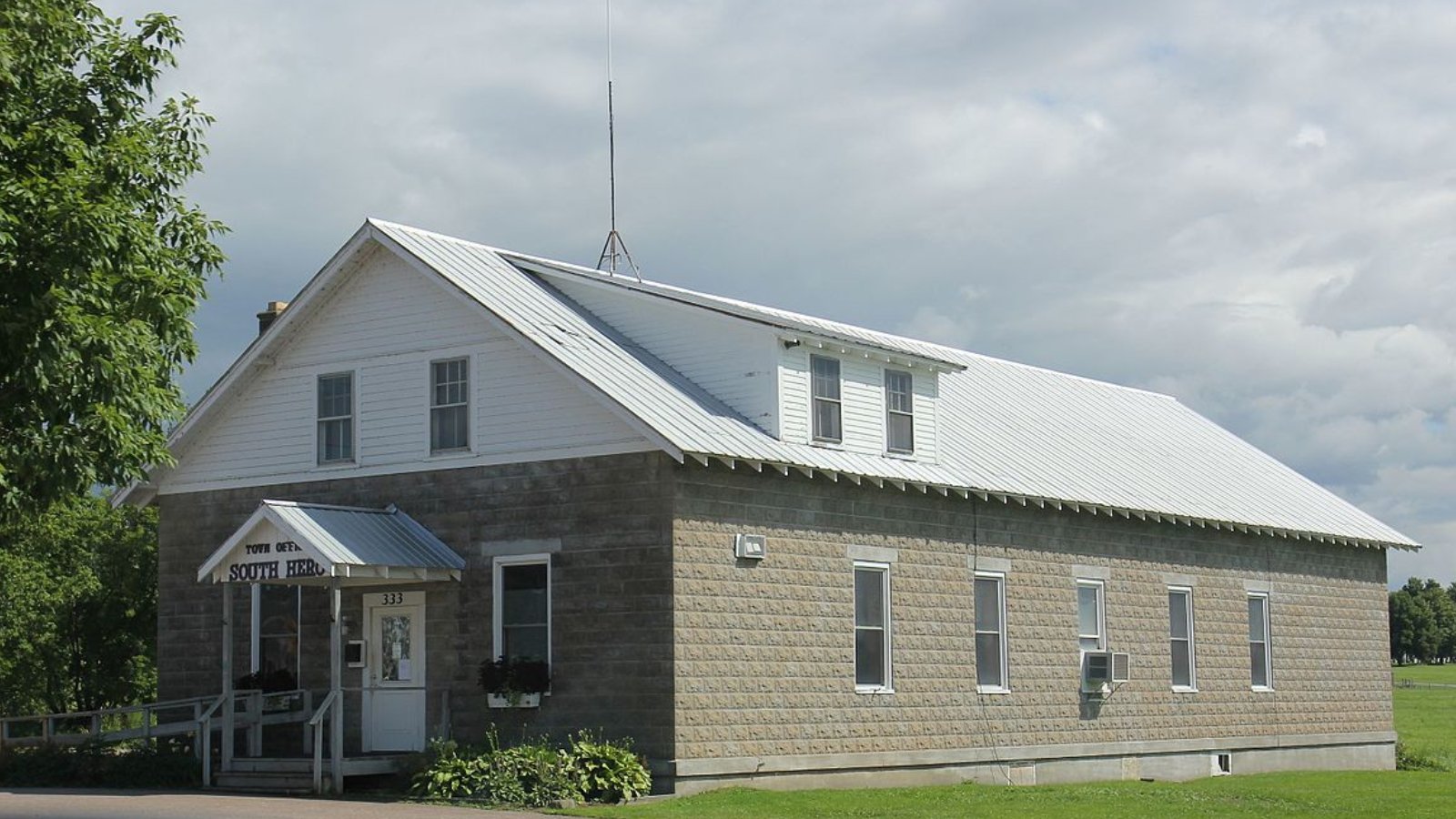
Why are people willing to pay so much to live here? What’s special about it?
South Hero offers exclusive island living with extensive Lake Champlain waterfront access and panoramic mountain views. The town provides a resort-like atmosphere year-round while maintaining convenient access to Burlington and Montreal via scenic bridges. Many properties feature private shoreline, boat access, and the peaceful isolation that island living provides.
The community offers excellent recreational opportunities including boating, fishing, swimming, and water sports throughout the warmer months. South Hero’s agricultural heritage and commitment to preservation ensure the rural character and scenic beauty that attract premium buyers seeking waterfront properties and island lifestyle.
How South Hero Rose to Prominence
South Hero Island was originally inhabited by Native American tribes who used Lake Champlain for fishing and transportation. French explorers arrived in the early 1600s, followed by American settlers after the Revolutionary War. The island’s name honors Ethan Allen and his Green Mountain Boys, who fought for Vermont’s independence.
Agriculture dominated South Hero’s economy throughout the 19th and early 20th centuries, with apple orchards and dairy farms taking advantage of the lake’s moderating climate. The development of tourism and vacation homes began in the mid-20th century as the island’s scenic beauty attracted visitors from urban areas. Today’s real estate market reflects South Hero’s evolution into a premier destination for waterfront living and recreational properties.
3 Interesting Tidbits
- Snow Farm Vineyard – Vermont’s first commercial vineyard operates on South Hero, producing wines that benefit from the lake’s unique microclimate.
- Ed Weed Fish Culture Station – This state facility raises fish for Vermont’s lakes and streams, supporting recreational fishing throughout the region.
- Apple Orchards – South Hero maintains several pick-your-own apple orchards that continue the island’s agricultural traditions and attract fall visitors.
12. Manchester – 93% Home Price Increase Since 2010
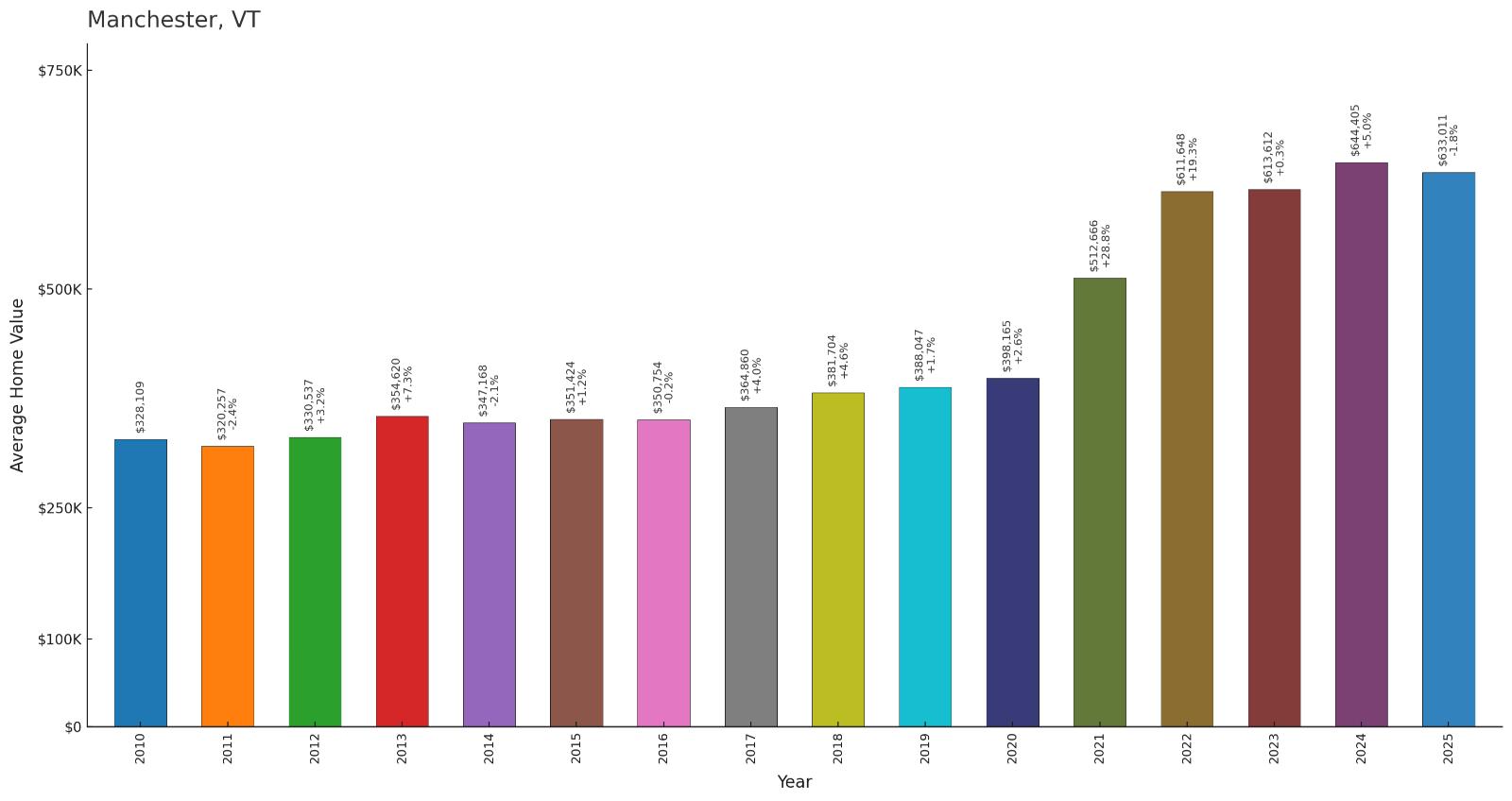
- 2010: $328,109
- 2011: $320,257
- 2012: $330,537
- 2013: $354,620
- 2014: $347,168
- 2015: $351,424
- 2016: $350,754
- 2017: $364,860
- 2018: $381,704
- 2019: $388,047
- 2020: $398,165
- 2021: $512,666
- 2022: $611,648
- 2023: $613,612
- 2024: $644,405
- 2025: $633,011
Manchester has achieved strong 93% growth since 2010, rising from around $328,000 to over $633,000. The town showed modest gains through most of the 2010s before experiencing dramatic acceleration during the pandemic years. Current values reflect Manchester’s status as a premier destination for upscale shopping, dining, and outdoor recreation in southern Vermont.
Why Manchester?

Why are people willing to pay so much to live here? What’s special about it?
Manchester combines sophisticated shopping and dining with access to premier outdoor recreation, creating a resort town atmosphere that attracts affluent visitors and residents. The town features designer outlets, upscale restaurants, and cultural attractions while providing easy access to skiing, hiking, and fishing in the Green Mountains. Many buyers seek vacation homes or retirement properties that offer both luxury amenities and recreational opportunities.
The community maintains its historic charm while accommodating upscale tourism and retail development. Manchester’s location provides access to multiple ski areas and outdoor activities while offering the sophisticated amenities that appeal to affluent buyers seeking Vermont’s recreational lifestyle.
How Manchester Rose to Prominence
Manchester was chartered in 1761 and developed as an agricultural and mill town in the Battenkill Valley. The town’s scenic mountain setting and mineral springs attracted visitors as early as the mid-19th century, establishing Manchester as one of Vermont’s first resort destinations. The Equinox Hotel, built in 1769, became a fashionable retreat for wealthy visitors from New York and Boston.
The development of skiing and the establishment of designer outlet shopping in the late 20th century transformed Manchester into a major tourist destination. The town successfully balanced commercial development with historic preservation, creating today’s upscale resort community. Manchester’s combination of recreation access, shopping, and dining has attracted vacation home buyers and retirees seeking sophisticated amenities in a mountain setting.
3 Interesting Tidbits
- Orvis Company – This famous fly-fishing and outdoor gear company was founded in Manchester in 1856 and still operates its flagship store there.
- Hildene – Robert Todd Lincoln’s estate offers tours of the Georgian Revival mansion and formal gardens that showcase Manchester’s gilded age heritage.
- Manchester Designer Outlets – This upscale shopping center attracts visitors from throughout New England with premium brands and mountain views.
11. Barnard – 81% Home Price Increase Since 2012

- 2010: N/A
- 2011: N/A
- 2012: $349,893
- 2013: $370,957
- 2014: $390,016
- 2015: $385,854
- 2016: $391,298
- 2017: $412,118
- 2018: $436,379
- 2019: $461,347
- 2020: $485,929
- 2021: $608,956
- 2022: $689,376
- 2023: $631,797
- 2024: $638,926
- 2025: $634,442
Barnard has achieved solid 81% growth since 2012, rising from around $350,000 to over $634,000. The town showed steady appreciation through the 2010s with particularly strong gains during the pandemic years. Current values reflect Barnard’s appeal as a picturesque rural community with proximity to Woodstock and access to outdoor recreation.
Why Barnard?

Why are people willing to pay so much to live here? What’s special about it?
Barnard offers quintessential Vermont countryside living with rolling hills, working farms, and pristine natural areas that attract buyers seeking authentic rural experiences. The town provides privacy and space while maintaining proximity to Woodstock’s cultural amenities and recreational opportunities. Many properties feature expansive acreage, mountain views, and agricultural heritage that appeal to lifestyle-focused buyers.
The community maintains strong conservation values and agricultural preservation that ensure the pastoral character prized by residents. Barnard’s location provides access to hiking, skiing, and outdoor recreation while preserving the working landscape that defines traditional Vermont living.
How Barnard Rose to Prominence
Barnard was chartered in 1761 and developed as an agricultural community in the hills east of the White River. The town’s challenging terrain limited development to scattered farms and small settlements, helping preserve its rural character throughout the 19th and 20th centuries. Unlike valley communities, Barnard avoided major industrial development.
The town’s proximity to Woodstock and its preserved agricultural landscape began attracting newcomers seeking authentic Vermont rural living in the mid-20th century. Barnard’s commitment to conservation and agricultural preservation has maintained the pastoral setting that appeals to affluent buyers. The town’s combination of natural beauty, privacy, and proximity to cultural amenities has created today’s premium rural real estate market.
3 Interesting Tidbits
- Silver Lake State Park – This popular recreation area provides swimming, fishing, and camping opportunities in Barnard’s scenic lake country.
- Barnard General Store – This community institution serves as a gathering place and maintains the traditional Vermont country store atmosphere.
- Working Farms – Barnard maintains active dairy and livestock operations that preserve the agricultural character valued by residents.
10. Winhall – 111% Home Price Increase Since 2012
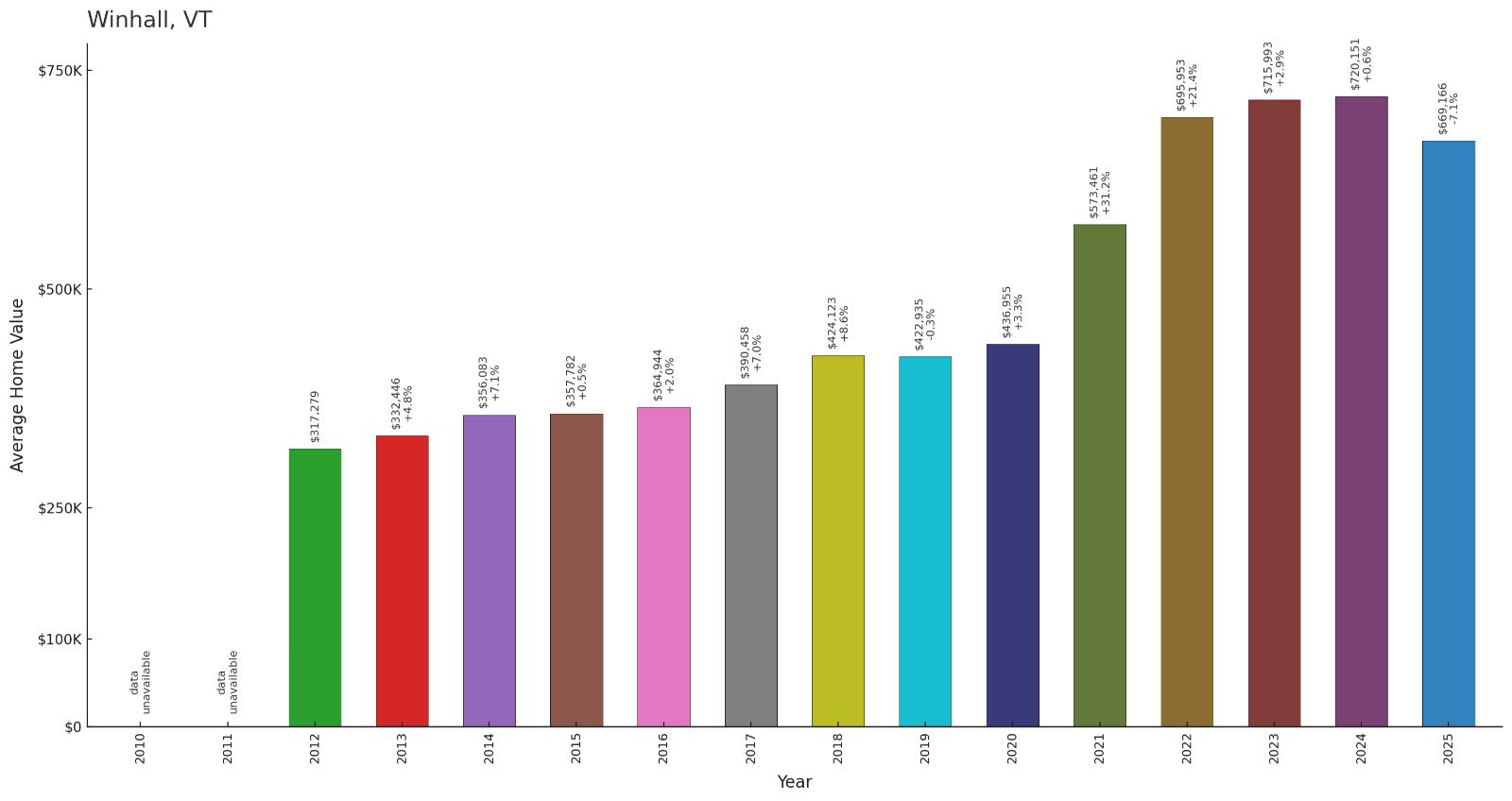
- 2010: N/A
- 2011: N/A
- 2012: $317,279
- 2013: $332,446
- 2014: $356,083
- 2015: $357,782
- 2016: $364,944
- 2017: $390,458
- 2018: $424,123
- 2019: $422,935
- 2020: $436,955
- 2021: $573,461
- 2022: $695,953
- 2023: $715,993
- 2024: $720,151
- 2025: $669,166
Winhall has more than doubled since 2012, achieving impressive 111% growth from around $317,000 to nearly $669,000. The town showed gradual appreciation through the 2010s before experiencing explosive growth during the pandemic years. Current values reflect Winhall’s position as home to Stratton Mountain Resort and premier southern Vermont recreation opportunities.
Why Winhall?
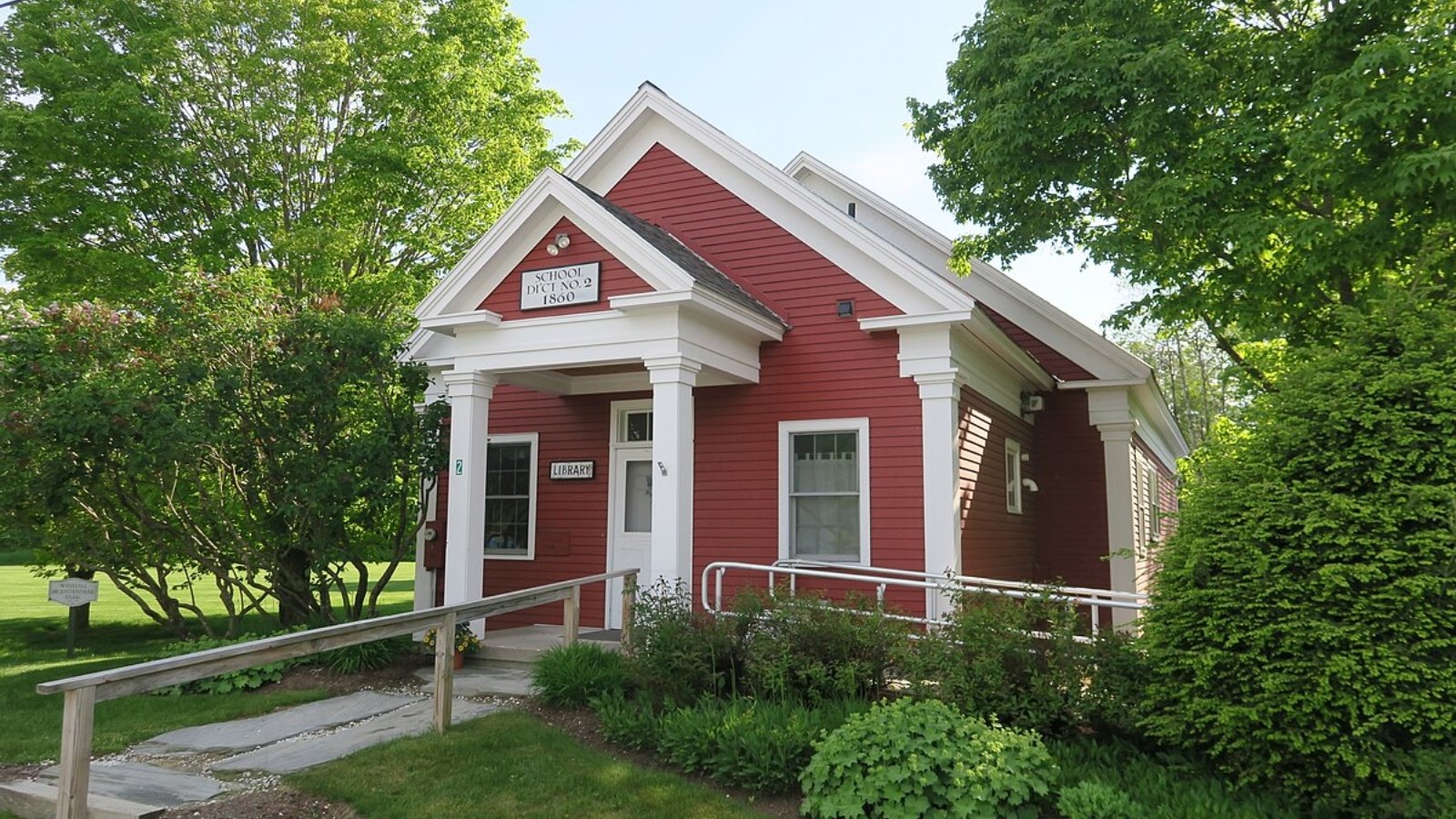
Why are people willing to pay so much to live here? What’s special about it?
Winhall centers around Stratton Mountain Resort, offering some of Vermont’s best skiing and mountain recreation opportunities. The town provides ski-in/ski-out properties and mountain homes with direct access to alpine recreation while maintaining a more exclusive atmosphere than larger resort areas. Many buyers are attracted to Winhall’s four-season recreation access and sophisticated mountain community.
The community offers upscale amenities including golf courses, spa facilities, and fine dining that create a resort lifestyle year-round. Winhall’s location provides access to both winter sports and summer mountain activities while offering the privacy and natural beauty that define premium mountain real estate.
How Winhall Rose to Prominence
Winhall was chartered in 1761 but remained largely wilderness due to its mountainous terrain and remote location. Early settlers practiced limited farming and logging, but the town’s population remained small throughout the 19th and early 20th centuries. The challenging mountain environment discouraged significant development until the ski era.
The development of Stratton Mountain as a ski resort in 1961 transformed Winhall from remote mountain community to major recreation destination. Stratton’s upscale approach and comprehensive resort amenities attracted affluent skiers and vacation home buyers. The resort’s continued expansion and enhancement has driven Winhall’s emergence as one of Vermont’s premier mountain real estate markets.
3 Interesting Tidbits
- Stratton Mountain Resort – This major ski area features 99 trails and pioneered snowboarding in the 1980s, hosting many professional competitions.
- Stratton Village – The resort’s European-style base village provides shopping, dining, and lodging in an upscale mountain setting.
- Green Mountain National Forest – Much of Winhall lies within this protected forest, ensuring preserved wilderness and recreational access.
9. Pomfret – 91% Home Price Increase Since 2012
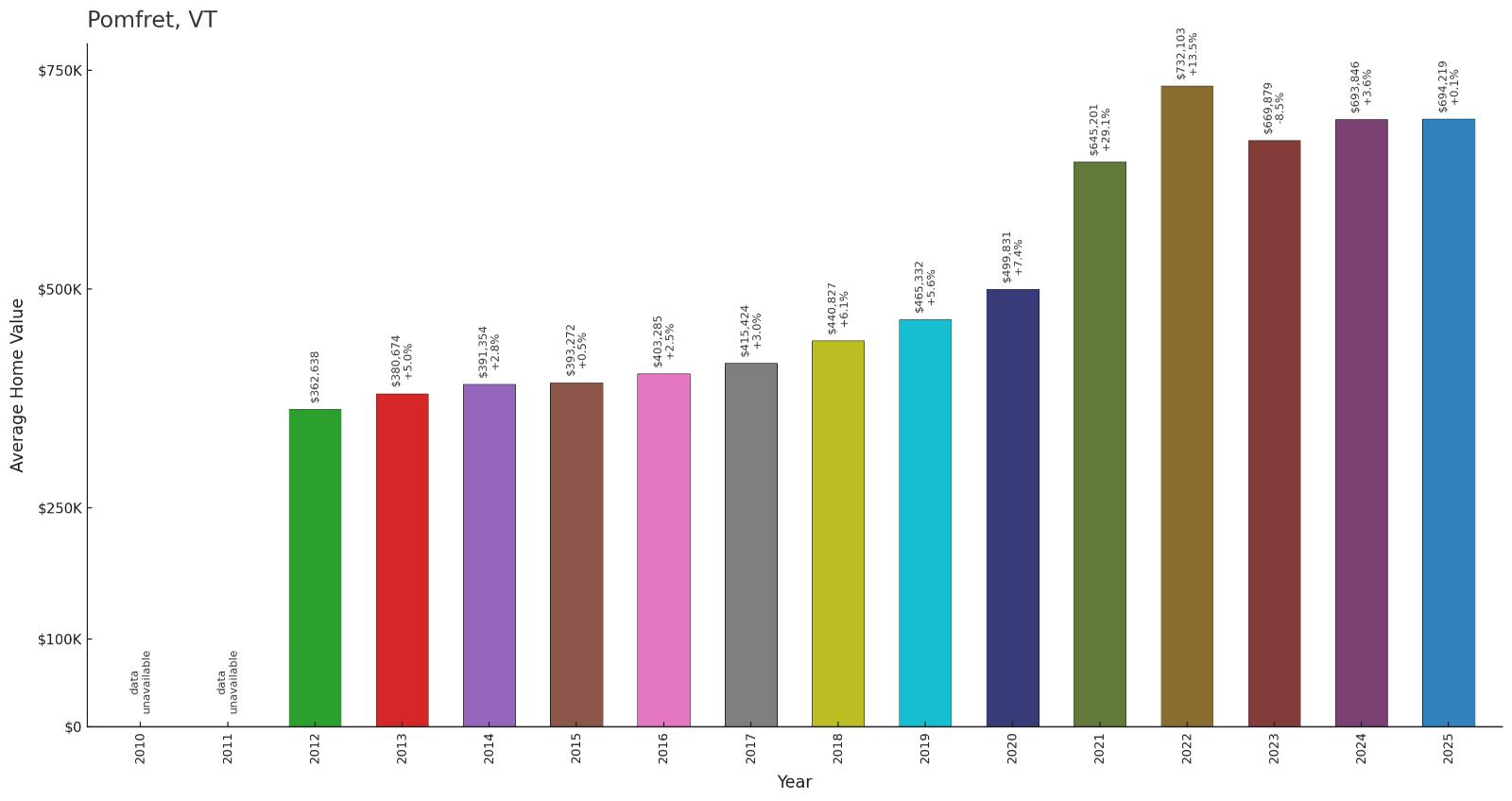
- 2010: N/A
- 2011: N/A
- 2012: $362,638
- 2013: $380,674
- 2014: $391,354
- 2015: $393,272
- 2016: $403,285
- 2017: $415,424
- 2018: $440,827
- 2019: $465,332
- 2020: $499,831
- 2021: $645,201
- 2022: $732,103
- 2023: $669,879
- 2024: $693,846
- 2025: $694,219
Pomfret has achieved strong 91% growth since 2012, rising from around $363,000 to nearly $694,000. The town showed steady appreciation through the 2010s with dramatic acceleration during the pandemic years, particularly in 2021-2022. Current values reflect Pomfret’s status as an exclusive rural community with proximity to Woodstock and exceptional recreational amenities.
Why Pomfret?
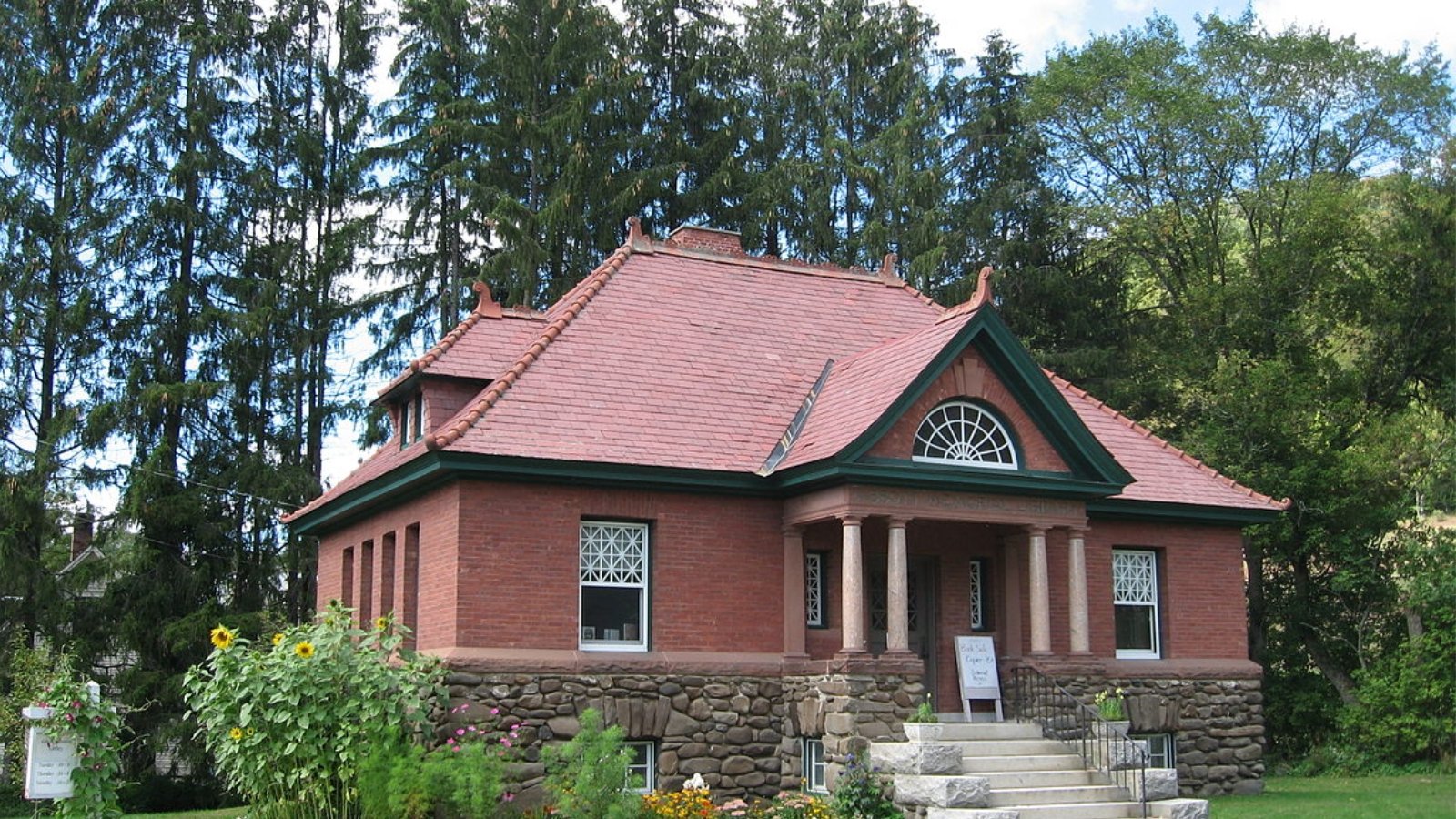
Why are people willing to pay so much to live here? What’s special about it?
Pomfret attracts affluent buyers seeking sophisticated rural living with proximity to Woodstock’s cultural offerings and recreational amenities. The town features expansive properties with mountain views, working farms, and preserved agricultural landscapes that create an exclusive countryside atmosphere. Many residents value Pomfret’s combination of privacy, natural beauty, and access to Vermont’s premier cultural and recreational destinations.
The community maintains strong conservation values and agricultural preservation that ensure the pastoral character prized by residents. Pomfret’s location provides easy access to skiing, hiking, and cultural activities while preserving the rural elegance that defines Vermont’s most exclusive communities.
How Pomfret Rose to Prominence
Pomfret was chartered in 1761 and developed as an agricultural community in the hills surrounding the White River valley. The town’s excellent soils and favorable climate supported prosperous farming operations, particularly dairy farms and sheep raising throughout the 19th century. Pomfret’s hilltop location and scenic setting attracted summer visitors even in the early settlement period.
The presence of nearby Woodstock and the development of recreational opportunities began attracting affluent newcomers in the mid-20th century. Pomfret’s commitment to agricultural preservation and limited development has maintained its exclusive rural character. The town’s combination of natural beauty, agricultural heritage, and proximity to cultural amenities has created today’s premium rural real estate market that attracts lifestyle-focused buyers.
3 Interesting Tidbits
- Suicide Six Ski Area – This historic ski area in Pomfret was one of the first in the United States and continues to operate as part of the Woodstock Inn resort.
- Teago General Store – This community institution serves as a gathering place and maintains traditional Vermont country store character.
- Agricultural Heritage – Pomfret maintains active farms and agricultural operations that preserve the rural character valued by affluent residents.
8. Shelburne – 69% Home Price Increase Since 2011
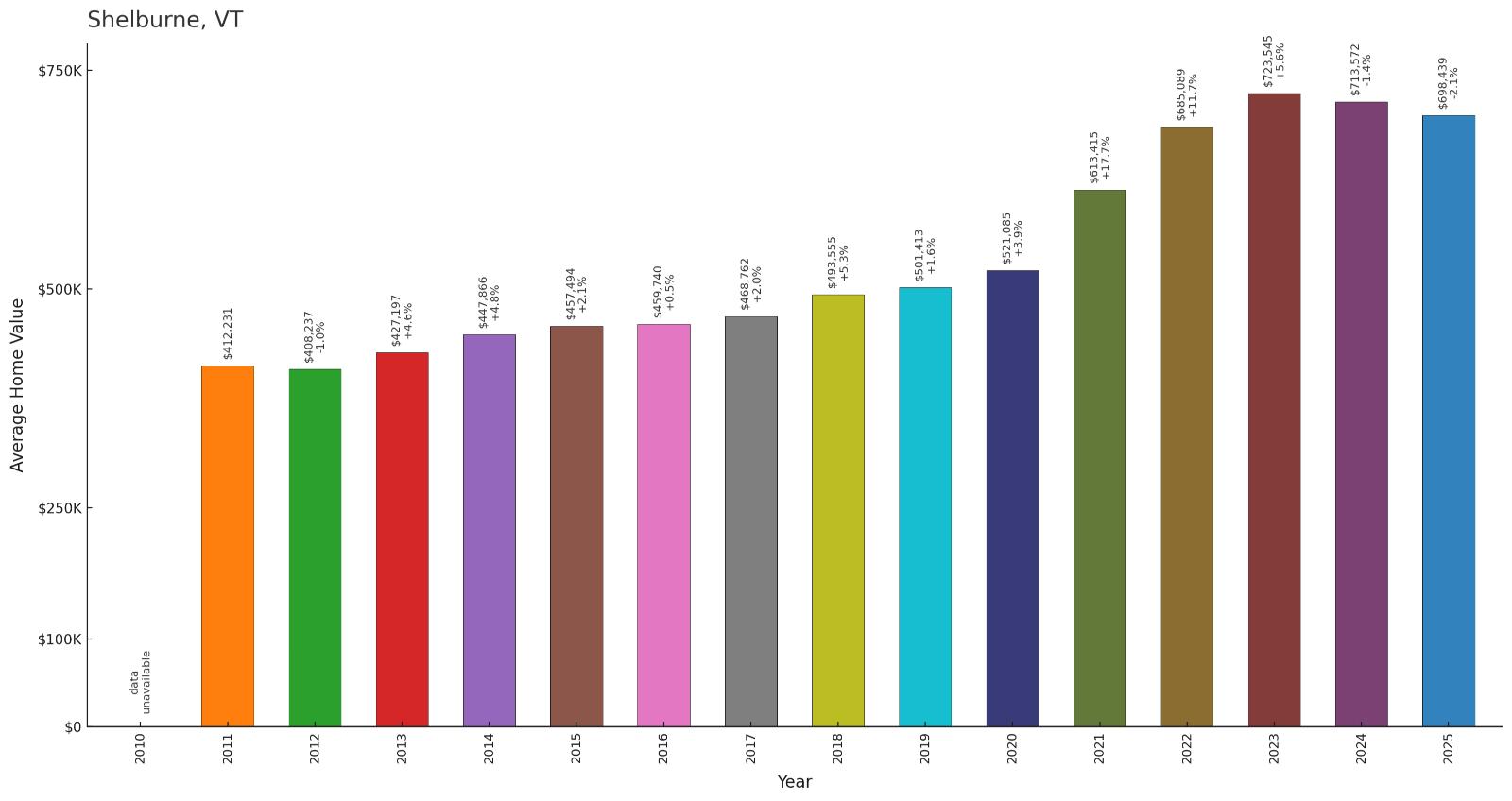
- 2010: N/A
- 2011: $412,231
- 2012: $408,237
- 2013: $427,197
- 2014: $447,866
- 2015: $457,494
- 2016: $459,740
- 2017: $468,762
- 2018: $493,555
- 2019: $501,413
- 2020: $521,085
- 2021: $613,415
- 2022: $685,089
- 2023: $723,545
- 2024: $713,572
- 2025: $698,439
Shelburne has achieved solid 69% growth since 2011, rising from around $412,000 to nearly $698,000. The town maintained steady appreciation through the 2010s with significant acceleration during the pandemic years. Current values reflect Shelburne’s prestige as an upscale community with Lake Champlain access and proximity to Burlington’s amenities.
Why Shelburne?
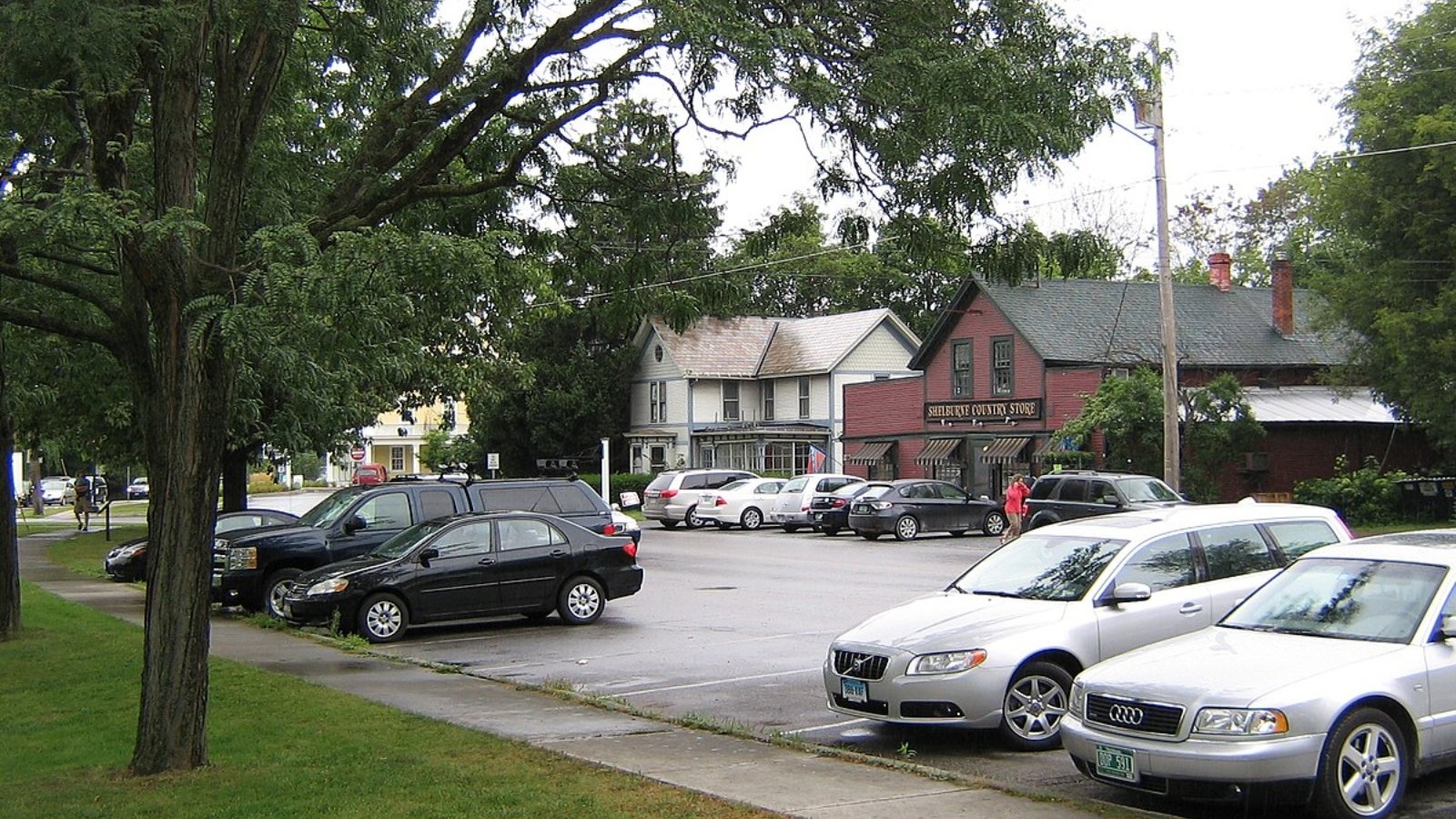
Why are people willing to pay so much to live here? What’s special about it?
Shelburne combines rural elegance with sophisticated amenities, offering residents access to world-class cultural attractions including Shelburne Museum and Shelburne Farms. The town provides Lake Champlain waterfront access and mountain views while maintaining convenient proximity to Burlington’s employment and cultural opportunities. Many properties feature expansive lots, historic architecture, and the refined atmosphere that attracts affluent buyers.
The community offers excellent schools, recreational facilities, and cultural amenities that create a sophisticated suburban environment. Shelburne’s commitment to preservation and thoughtful development has maintained the character and natural beauty that justify premium real estate prices.
How Shelburne Rose to Prominence
Shelburne was chartered in 1763 and developed as an agricultural community along Lake Champlain’s eastern shore. The town’s fertile soils and lake access supported prosperous farming and small-scale commerce throughout the 19th century. Shelburne’s scenic setting and proximity to Burlington attracted wealthy families who built substantial estates in the area.
The Webb family’s development of Shelburne Farms in the late 19th century established the town’s reputation for agricultural innovation and cultural sophistication. The creation of Shelburne Museum and preservation of historic properties enhanced the town’s cultural appeal. Today’s real estate market reflects Shelburne’s evolution into one of Vermont’s most prestigious communities, combining rural beauty with sophisticated amenities.
3 Interesting Tidbits
- Shelburne Museum – This world-renowned museum features 39 historic buildings and extensive collections of American folk art and artifacts.
- Shelburne Farms – This 1,400-acre working farm and National Historic Landmark produces award-winning cheese and offers educational programs.
- Lake Champlain Access – Shelburne provides multiple public and private access points to Lake Champlain for boating and water recreation.
7. Woodstock – 87% Home Price Increase Since 2010

- 2010: $380,403
- 2011: $372,296
- 2012: $381,196
- 2013: $391,527
- 2014: $399,269
- 2015: $409,277
- 2016: $407,703
- 2017: $428,413
- 2018: $451,127
- 2019: $465,174
- 2020: $491,877
- 2021: $649,744
- 2022: $774,159
- 2023: $721,958
- 2024: $730,372
- 2025: $712,916
Woodstock has achieved strong 87% growth since 2010, rising from around $380,000 to over $712,000. The town showed steady appreciation through the 2010s before experiencing dramatic acceleration during the pandemic years, particularly in 2021-2022. Current values reflect Woodstock’s status as Vermont’s premier historic village and cultural destination.
Why Woodstock?
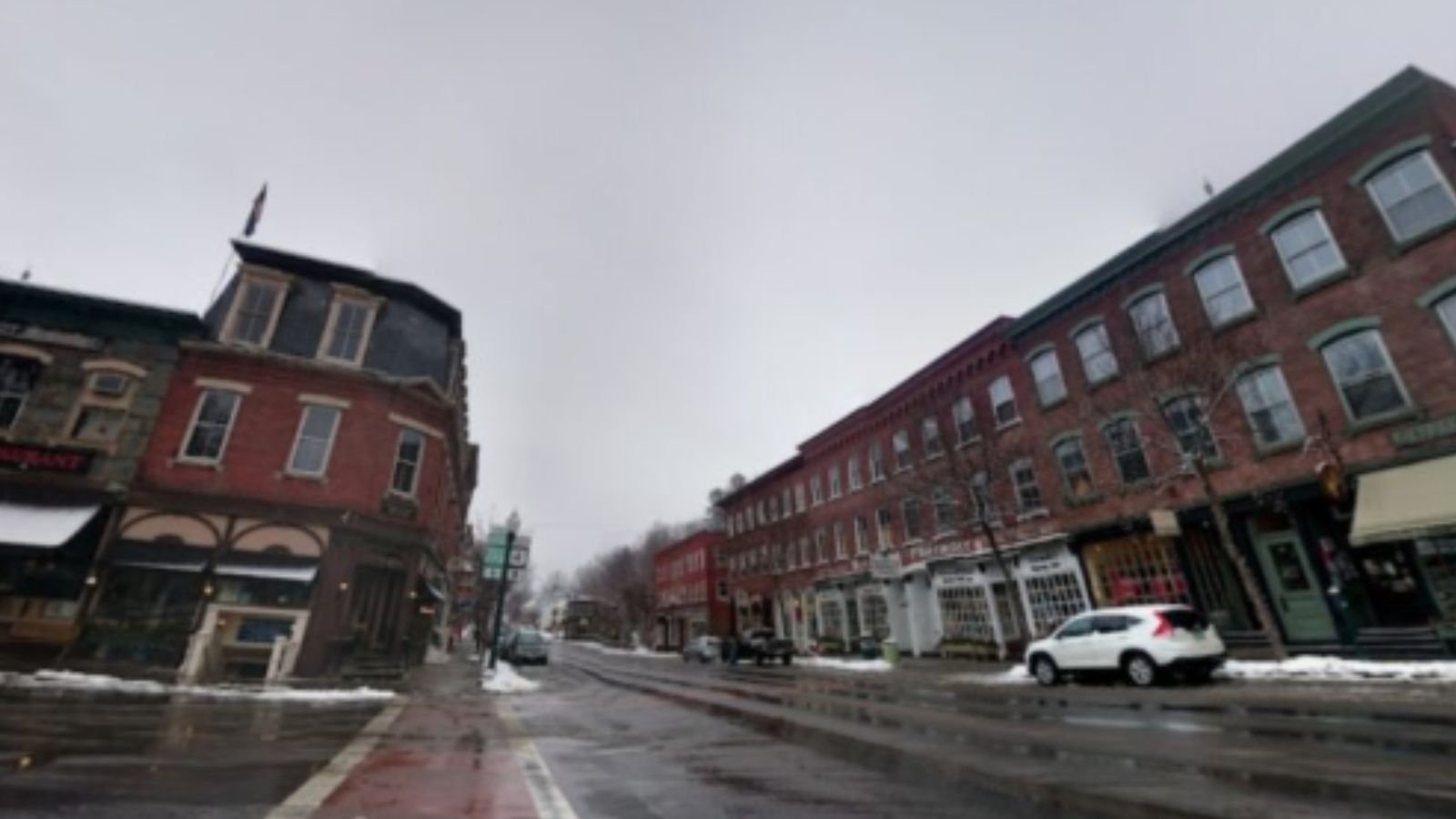
Why are people willing to pay so much to live here? What’s special about it?
Woodstock represents the pinnacle of Vermont village life, combining meticulously preserved 18th and 19th-century architecture with world-class cultural attractions and recreational amenities. The town offers sophisticated dining, shopping, and lodging while maintaining the intimate scale and historic character that define quintessential New England. Many buyers seek properties that provide access to this unique combination of history, culture, and natural beauty.
The community provides four-season recreation including skiing at Suicide Six, hiking in surrounding forests, and cultural events throughout the year. Woodstock’s commitment to historic preservation and architectural excellence has created an unparalleled setting that attracts affluent buyers from throughout the country.
How Woodstock Rose to Prominence
Woodstock was chartered in 1761 and quickly developed as the Windsor County seat and regional center. The town’s strategic location in the Ottauquechee River valley made it a hub for commerce, government, and transportation throughout the 19th century. Woodstock’s prosperity attracted skilled craftsmen and merchants who built the exceptional architecture that defines the town today.
The Rockefeller family’s involvement in Woodstock beginning in the 1930s brought unprecedented resources for preservation and enhancement. Their establishment of the Woodstock Inn, Billings Farm Museum, and extensive conservation efforts transformed Woodstock into a model historic community. Today’s real estate market reflects decades of careful preservation and cultural development that have created Vermont’s most prestigious village setting.
3 Interesting Tidbits
- Billings Farm & Museum – This working dairy farm and museum showcases Vermont’s agricultural heritage and sustainable farming practices.
- Marsh-Billings-Rockefeller National Historical Park – America’s only national park focused on conservation history and land stewardship surrounds Woodstock.
- Covered Bridge – Woodstock’s famous covered bridge in the village center has become an iconic symbol of Vermont and appears in countless photographs.
6. Stratton – 114% Home Price Increase Since 2012

- 2010: N/A
- 2011: N/A
- 2012: $332,937
- 2013: $344,196
- 2014: $360,636
- 2015: $341,368
- 2016: $350,517
- 2017: $359,758
- 2018: $390,639
- 2019: $399,987
- 2020: $416,570
- 2021: $581,530
- 2022: $664,664
- 2023: $647,698
- 2024: $703,834
- 2025: $713,387
Stratton has more than doubled since 2012, achieving impressive 114% growth from around $333,000 to over $713,000. The town showed modest gains through the 2010s before experiencing explosive growth during the pandemic years. Current values reflect Stratton’s position as a premier mountain resort community with comprehensive recreational amenities.
Why Stratton?
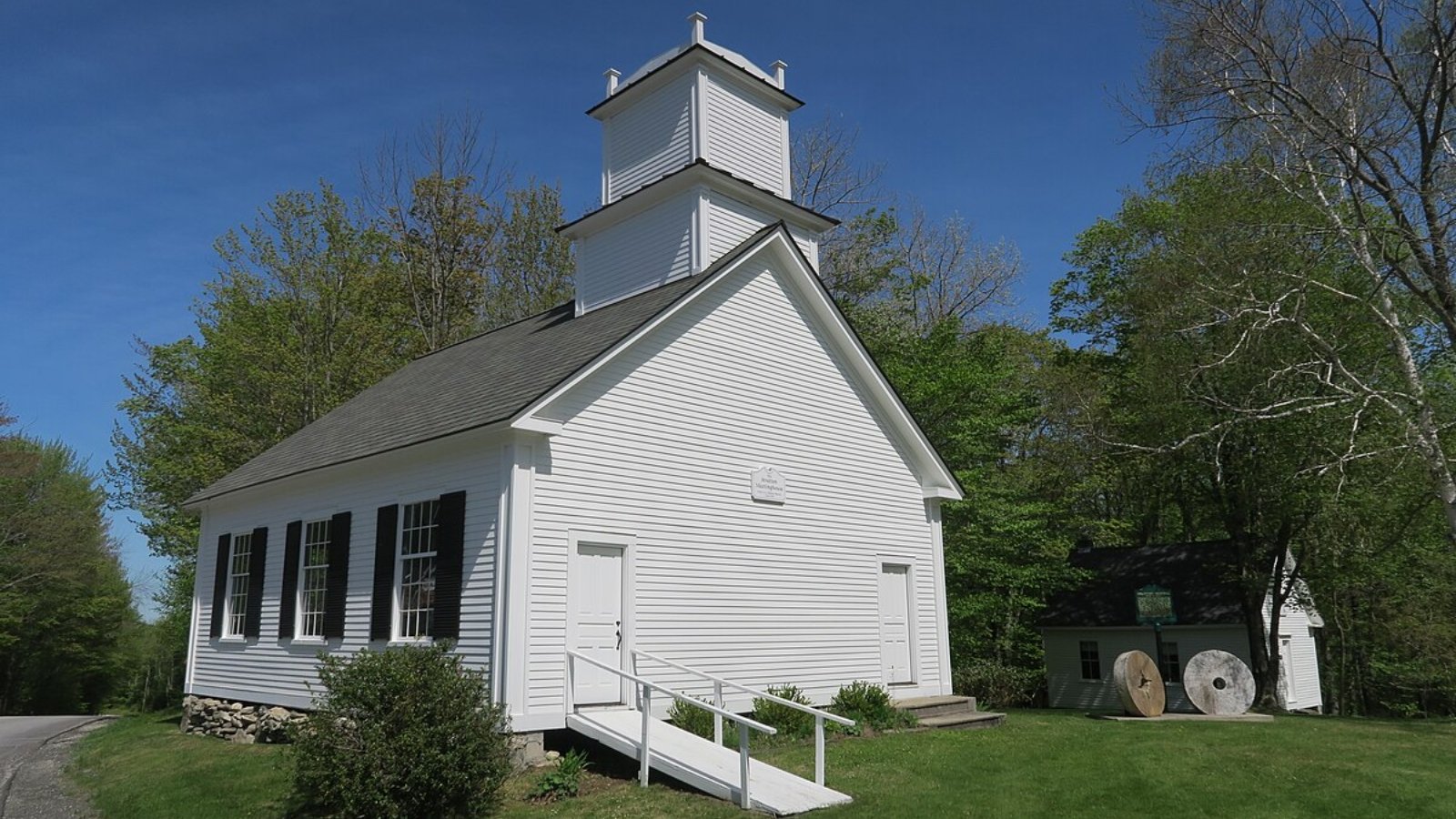
Why are people willing to pay so much to live here? What’s special about it?
Stratton offers the complete mountain resort experience with world-class skiing, golf, and spa facilities that create a year-round recreational destination. The town provides ski-in/ski-out properties and luxury mountain homes with direct access to alpine recreation and resort amenities. Many buyers are attracted to Stratton’s sophisticated mountain community and comprehensive recreational infrastructure.
The community offers upscale amenities including championship golf courses, luxury spa facilities, and fine dining that create an exclusive resort atmosphere. Stratton’s location in the Green Mountains provides spectacular scenery and four-season recreation while offering the convenience and services that appeal to affluent buyers.
How Stratton Rose to Prominence
Stratton was originally part of several chartered towns but remained largely wilderness due to its remote mountain location. Early logging operations harvested the area’s extensive forests, but permanent settlement remained limited until the development of recreational skiing. The challenging mountain terrain discouraged agriculture and significant early development.
The creation of Stratton Mountain Resort in 1961 transformed the area from remote wilderness into a major recreational destination. Stratton’s comprehensive approach to resort development, including golf courses, real estate, and year-round amenities, attracted affluent visitors and vacation home buyers. The resort’s continued expansion and enhancement has created today’s premier mountain real estate market focused on luxury recreational properties.
3 Interesting Tidbits
- Snowboarding Birthplace – Stratton Mountain is credited as the birthplace of snowboarding, where Jake Burton Carpenter developed the modern snowboard in the 1980s.
- Stratton Golf School – The resort operates one of the country’s premier golf instruction facilities with multiple championship courses.
- Mountain Village – Stratton’s Austrian-inspired base village provides European-style mountain resort atmosphere with luxury amenities.
5. Dorset – 89% Home Price Increase Since 2010
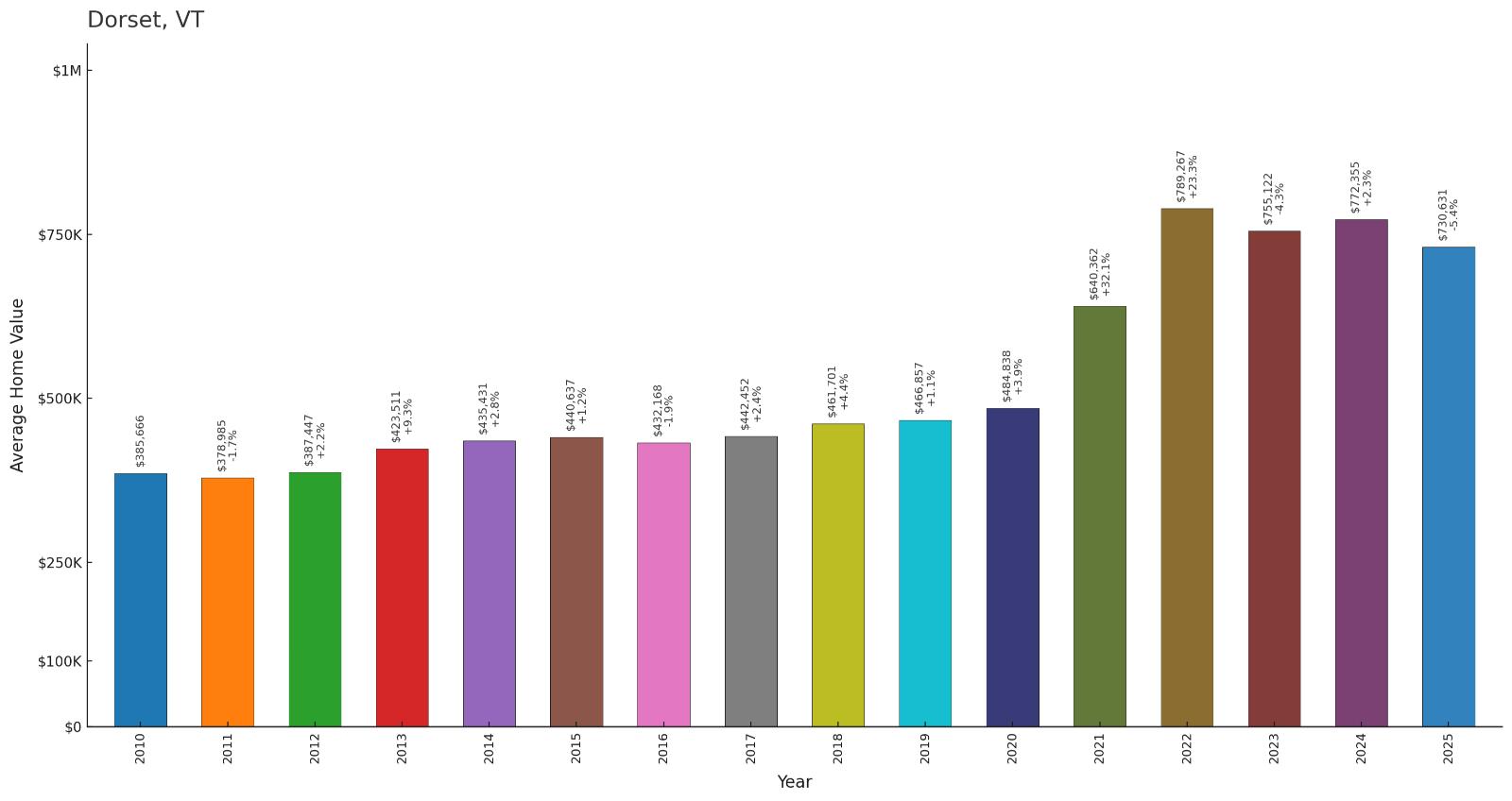
- 2010: $385,666
- 2011: $378,985
- 2012: $387,447
- 2013: $423,511
- 2014: $435,431
- 2015: $440,637
- 2016: $432,168
- 2017: $442,452
- 2018: $461,701
- 2019: $466,857
- 2020: $484,838
- 2021: $640,362
- 2022: $789,267
- 2023: $755,122
- 2024: $772,355
- 2025: $730,631
Dorset has achieved strong 89% growth since 2010, rising from around $386,000 to over $730,000. The town showed gradual appreciation through the 2010s before experiencing dramatic acceleration during the pandemic years, particularly in 2021-2022. Current values reflect Dorset’s status as an exclusive resort community with historic charm and recreational amenities.
Why Dorset?
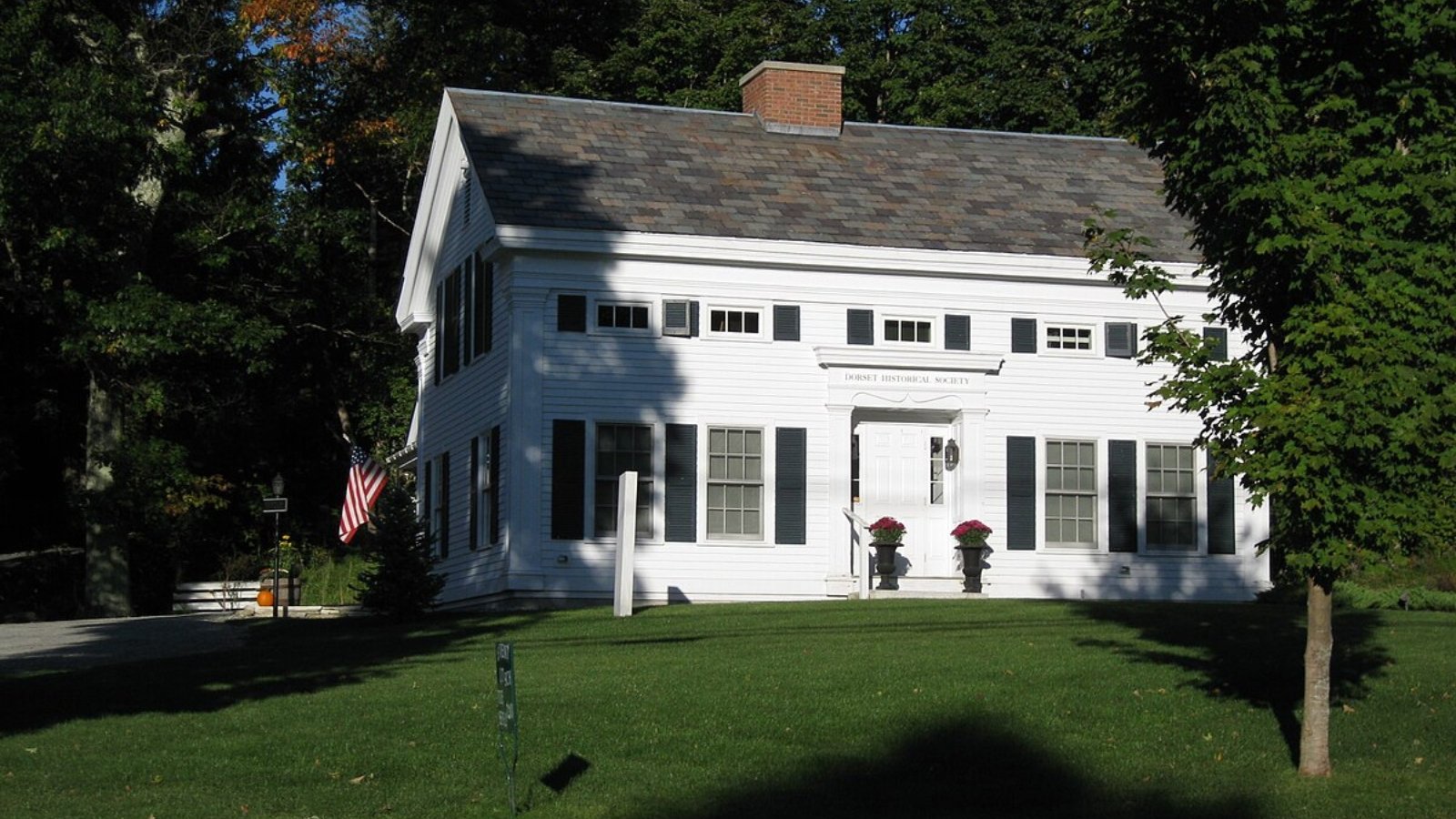
Why are people willing to pay so much to live here? What’s special about it?
Dorset combines historic village charm with access to premier recreational opportunities, creating an exclusive atmosphere that attracts affluent buyers seeking authentic Vermont character. The town features carefully preserved 18th and 19th-century architecture while providing access to skiing, hiking, and cultural attractions throughout southern Vermont. Many properties offer mountain views, privacy, and the sophisticated rural atmosphere that defines Vermont’s most desirable communities.
The community maintains strong cultural traditions including theater productions, art galleries, and seasonal festivals that create a vibrant social scene. Dorset’s location provides access to multiple ski areas and outdoor recreation while preserving the historic character and natural beauty that justify premium real estate prices.
How Dorset Rose to Prominence
Dorset was chartered in 1761 and developed as one of Vermont’s earliest and most prosperous communities. The town’s abundant marble quarries provided building materials for structures throughout New England, including the New York Public Library. Dorset’s early prosperity from quarrying and agriculture allowed residents to build substantial homes and public buildings that define the town’s character today.
The development of tourism and recreation in the 20th century attracted visitors who appreciated Dorset’s historic architecture and mountain setting. The town’s commitment to preservation and cultural activities has maintained its exclusive character while accommodating recreational tourism. Today’s real estate market reflects Dorset’s successful evolution from industrial center to sophisticated resort community that attracts affluent buyers seeking authentic Vermont heritage.
3 Interesting Tidbits
- Dorset Quarry – This abandoned marble quarry has become a popular swimming hole with crystal-clear water surrounded by marble cliffs.
- Dorset Theatre Festival – This professional summer theater attracts renowned actors and playwrights for acclaimed productions each season.
- Marble Quarrying Heritage – Dorset marble was used in major buildings including the New York Public Library and continues to be quarried today.
4. Norwich – 97% Home Price Increase Since 2010
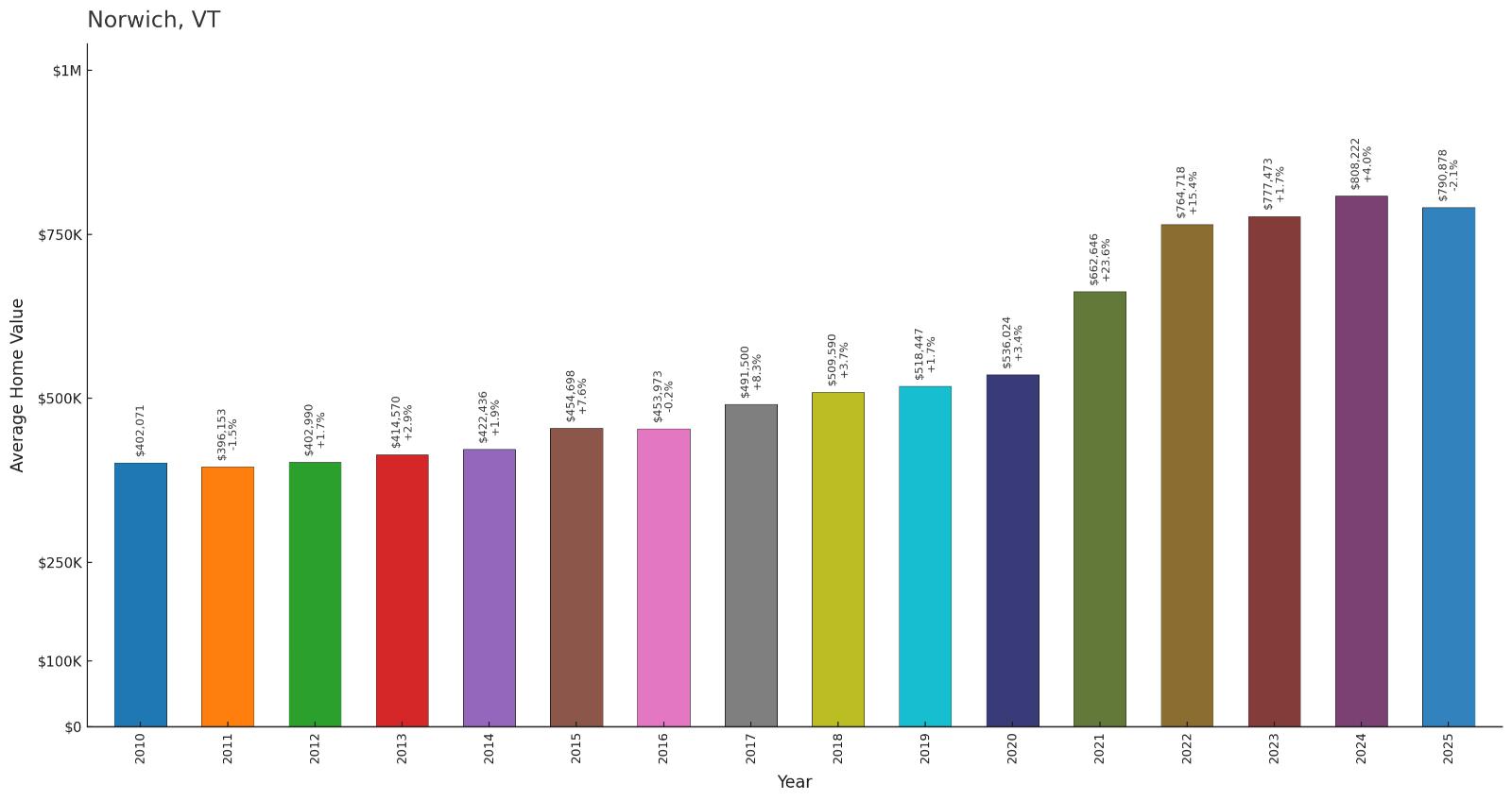
- 2010: $402,071
- 2011: $396,153
- 2012: $402,990
- 2013: $414,570
- 2014: $422,436
- 2015: $454,698
- 2016: $453,973
- 2017: $491,500
- 2018: $509,590
- 2019: $518,447
- 2020: $536,024
- 2021: $662,646
- 2022: $764,718
- 2023: $777,473
- 2024: $808,222
- 2025: $790,878
Norwich has achieved strong 97% growth since 2010, nearly doubling from around $402,000 to over $790,000. The town showed steady appreciation through the 2010s with dramatic acceleration during the pandemic years. Current values reflect Norwich’s prestige as an intellectual and cultural center with proximity to Dartmouth College and exceptional educational opportunities.
Why Norwich?
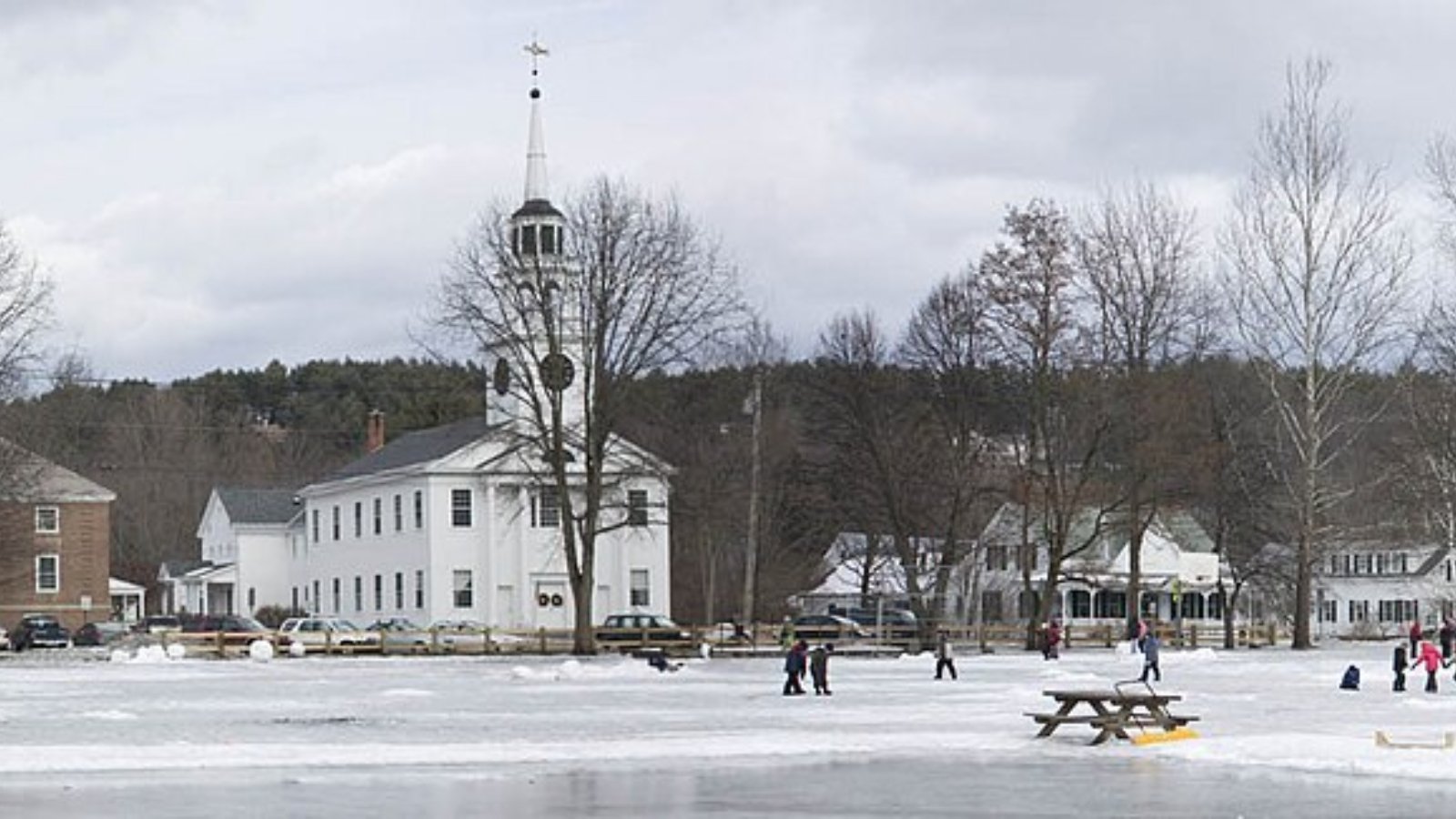
Why are people willing to pay so much to live here? What’s special about it?
Norwich attracts highly educated buyers seeking intellectual stimulation and cultural sophistication, with many residents connected to Dartmouth College across the Connecticut River in Hanover. The town combines excellent schools, cultural amenities, and outdoor recreation access while maintaining the refined atmosphere that appeals to academics and professionals. Many properties offer rural settings with convenient access to world-class educational and cultural institutions.
The community provides exceptional educational opportunities and maintains strong traditions of civic engagement and cultural activities. Norwich’s location offers four-season recreation including skiing, hiking, and cultural events while preserving the intellectual character that distinguishes it from other Vermont communities.
How Norwich Rose to Prominence
Norwich was chartered in 1761 and developed as an agricultural community in the Connecticut River valley. The town’s fertile soils and river access supported prosperous farming throughout the 19th century. Norwich’s proximity to Dartmouth College, founded in 1769 across the river in Hanover, New Hampshire, began influencing the town’s character from its early days.
The presence of Norwich University, founded in 1819 as America’s first private military college, further enhanced the town’s educational reputation before the institution moved to Northfield. The continued connection to Dartmouth College has attracted faculty, administrators, and educated professionals who value Norwich’s rural setting with academic proximity. This intellectual character has driven Norwich’s evolution into one of Vermont’s most sophisticated and expensive communities.
3 Interesting Tidbits
- King Arthur Baking – This famous baking company operates its headquarters and flagship store in Norwich, attracting food enthusiasts from across New England.
- Montshire Museum of Science – This renowned hands-on science museum provides educational programming and attracts visitors from throughout the region.
- Connecticut River Access – Norwich provides scenic access to the Connecticut River for boating, fishing, and recreation along Vermont’s eastern border.
3. Landgrove – 6% Home Price Decrease Since 2024
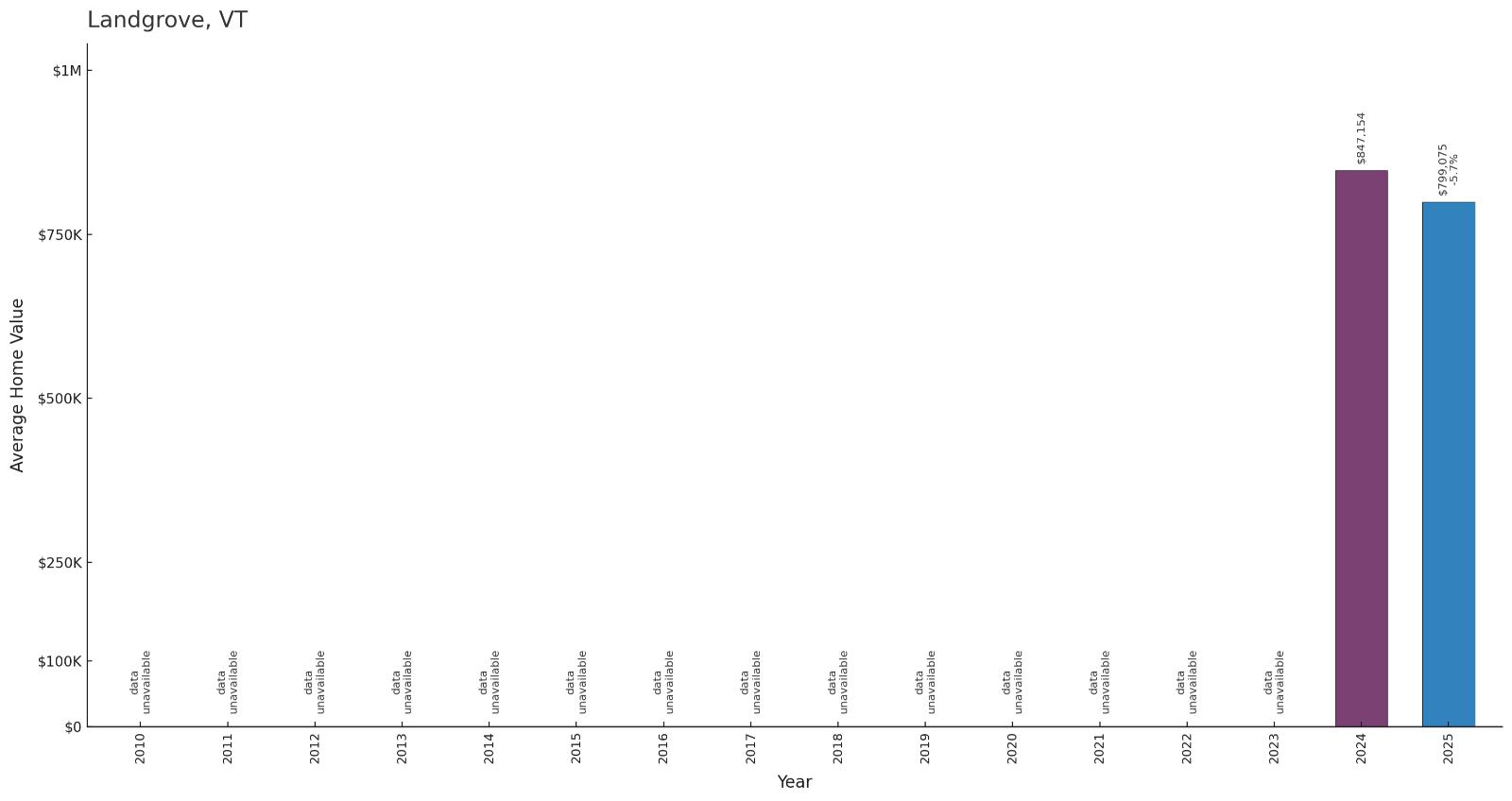
- 2010: N/A
- 2011: N/A
- 2012: N/A
- 2013: N/A
- 2014: N/A
- 2015: N/A
- 2016: N/A
- 2017: N/A
- 2018: N/A
- 2019: N/A
- 2020: N/A
- 2021: N/A
- 2022: N/A
- 2023: N/A
- 2024: $847,154
- 2025: $799,075
Landgrove shows limited data with only recent years available, experiencing a 6% decrease from 2024 to 2025. Despite the recent decline from over $847,000 to $799,000, current values place Landgrove among Vermont’s most expensive communities. The high baseline reflects Landgrove’s exclusivity as a small mountain community with exceptional privacy and recreational access.
Why Landgrove?

Why are people willing to pay so much to live here? What’s special about it?
Landgrove offers ultimate privacy and exclusivity in a pristine mountain setting that attracts affluent buyers seeking retreat-style properties. The town provides access to excellent skiing at nearby resorts while maintaining an intimate scale and natural character that larger resort communities have lost. Many properties feature extensive acreage, mountain views, and the authentic Vermont wilderness experience that commands premium prices.
The community maintains minimal development and strong conservation values that preserve the natural character prized by residents. Landgrove’s location provides four-season recreation access while offering the privacy and exclusivity that appeal to buyers seeking authentic mountain living away from commercial development.
How Landgrove Rose to Prominence
Landgrove was chartered in 1780 but remained largely wilderness due to its remote mountain location and challenging terrain. Early settlement was limited to small-scale logging and seasonal farming, with most of the town remaining forested throughout the 19th and early 20th centuries. The rugged landscape discouraged significant development or population growth.
The development of recreational skiing and interest in mountain properties began attracting buyers to Landgrove in the mid-20th century. The town’s commitment to limited development and environmental preservation has maintained its wilderness character while accommodating exclusive residential properties. Today’s real estate market reflects Landgrove’s successful preservation of pristine mountain environment that attracts affluent buyers seeking ultimate privacy and natural beauty.
3 Interesting Tidbits
- Village Inn – The historic Landgrove Inn provides country lodging and dining in an authentic Vermont mountain setting.
- Green Mountain National Forest – Much of Landgrove is surrounded by protected forest land that ensures permanent preservation of the natural environment.
- Limited Development – Landgrove maintains some of Vermont’s most restrictive development policies, preserving its exclusive mountain character.
2. Charlotte – 104% Home Price Increase Since 2010
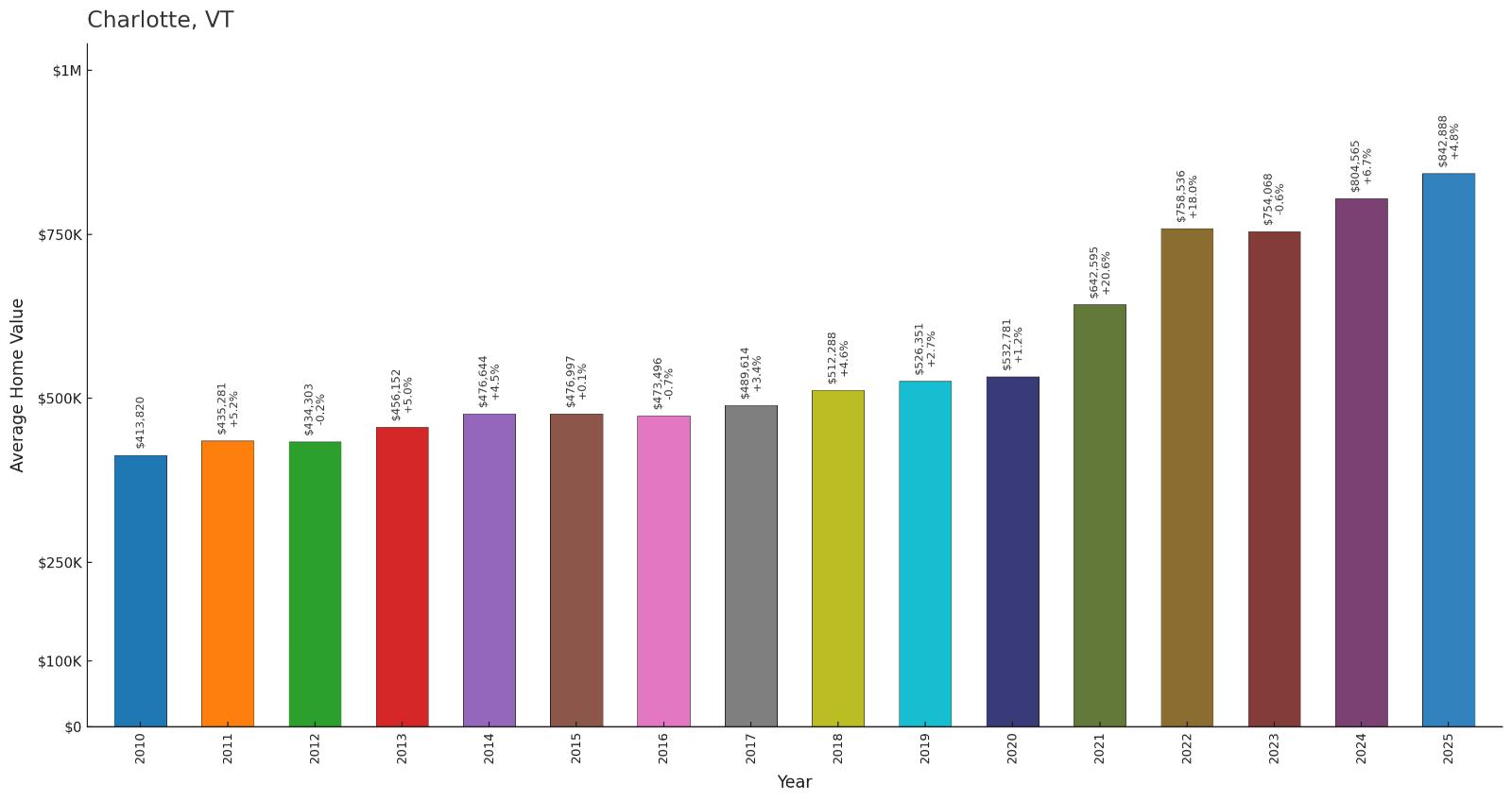
- 2010: $413,820
- 2011: $435,281
- 2012: $434,303
- 2013: $456,152
- 2014: $476,644
- 2015: $476,997
- 2016: $473,496
- 2017: $489,614
- 2018: $512,288
- 2019: $526,351
- 2020: $532,781
- 2021: $642,595
- 2022: $758,536
- 2023: $754,068
- 2024: $804,565
- 2025: $842,888
Charlotte has more than doubled since 2010, achieving impressive 104% growth from around $414,000 to nearly $843,000. The town showed steady appreciation through the 2010s with dramatic acceleration during the pandemic years and continued growth into 2025. Current values reflect Charlotte’s position as one of Vermont’s most prestigious lakefront communities.
Why Charlotte?
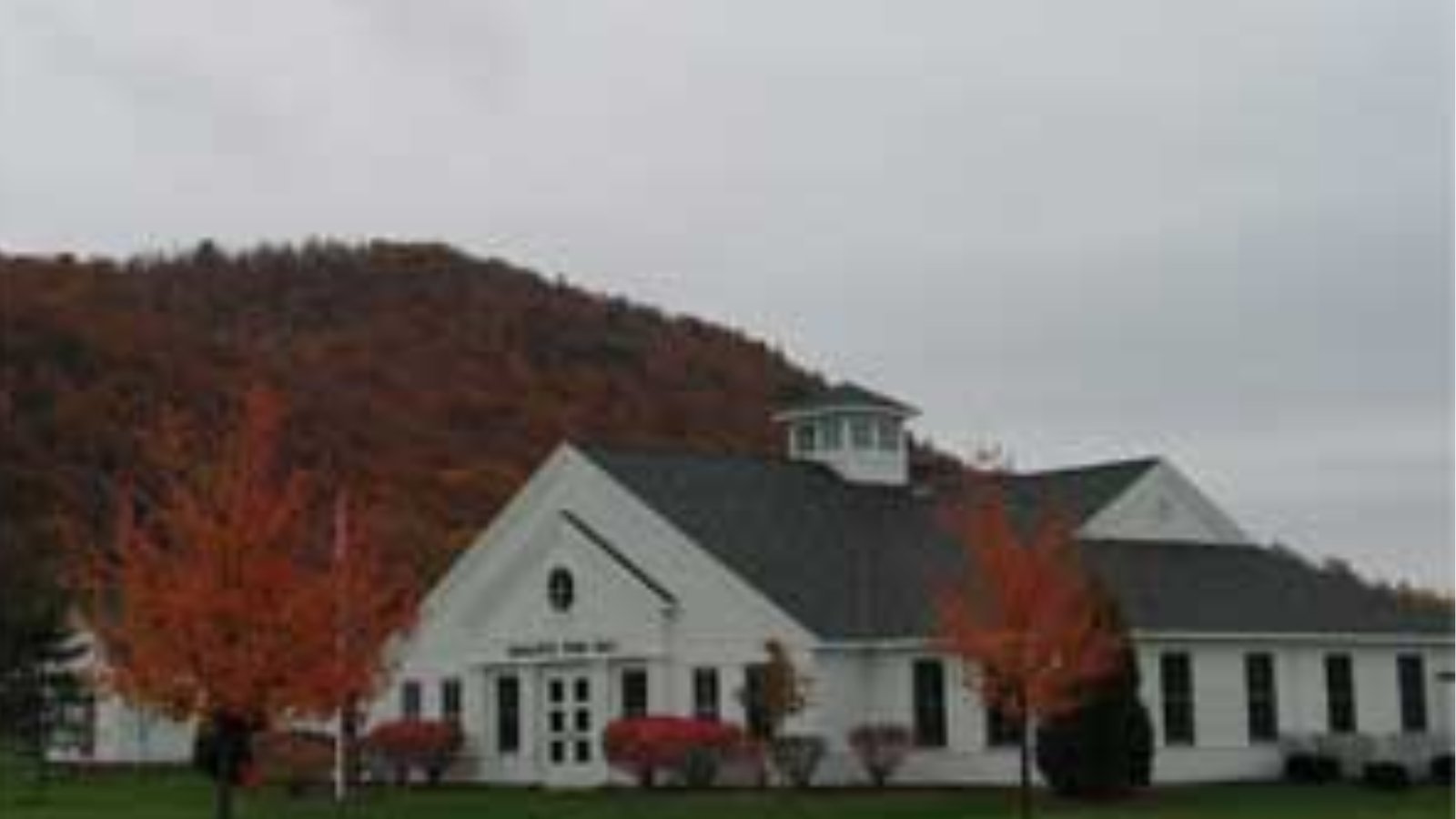
Why are people willing to pay so much to live here? What’s special about it?
Charlotte offers exclusive Lake Champlain waterfront living with expansive properties and panoramic mountain views that create a resort-like atmosphere year-round. The town attracts affluent buyers seeking sophisticated rural living with water recreation access and proximity to Burlington’s cultural and employment opportunities. Many properties feature private shoreline, agricultural preservation, and the refined country atmosphere that defines Vermont’s most exclusive communities.
The community maintains strong agricultural heritage and conservation values that preserve the pastoral character prized by residents. Charlotte’s location provides excellent recreational opportunities including boating, fishing, and water sports while offering the privacy and natural beauty that justify premium real estate prices.
How Charlotte Rose to Prominence
Charlotte was chartered in 1762 and developed as one of the Champlain Valley’s premier agricultural communities. The town’s fertile soils, favorable climate, and Lake Champlain access made it ideal for diversified farming, particularly dairy operations and apple orchards. Throughout the 19th century, Charlotte farmers supplied regional markets while maintaining substantial waterfront properties.
The town’s scenic setting and lake access began attracting summer visitors and vacation homes in the early 20th century. Charlotte’s commitment to agricultural preservation and limited development has maintained its exclusive rural character while accommodating affluent newcomers. The combination of lakefront access, preserved agriculture, and proximity to Burlington has created today’s prestigious real estate market that attracts buyers seeking sophisticated country living.
3 Interesting Tidbits
- Vermont Wildflower Farm – This popular attraction showcases native wildflower displays and provides seeds and plants for gardens throughout New England.
- Mount Philo State Park – Vermont’s first state park provides hiking trails and scenic overlooks with panoramic views of Lake Champlain and the Adirondacks.
- Agricultural Heritage – Charlotte maintains active farms and agricultural operations that preserve the rural character valued by affluent residents.
1. Stowe – 120% Home Price Increase Since 2010
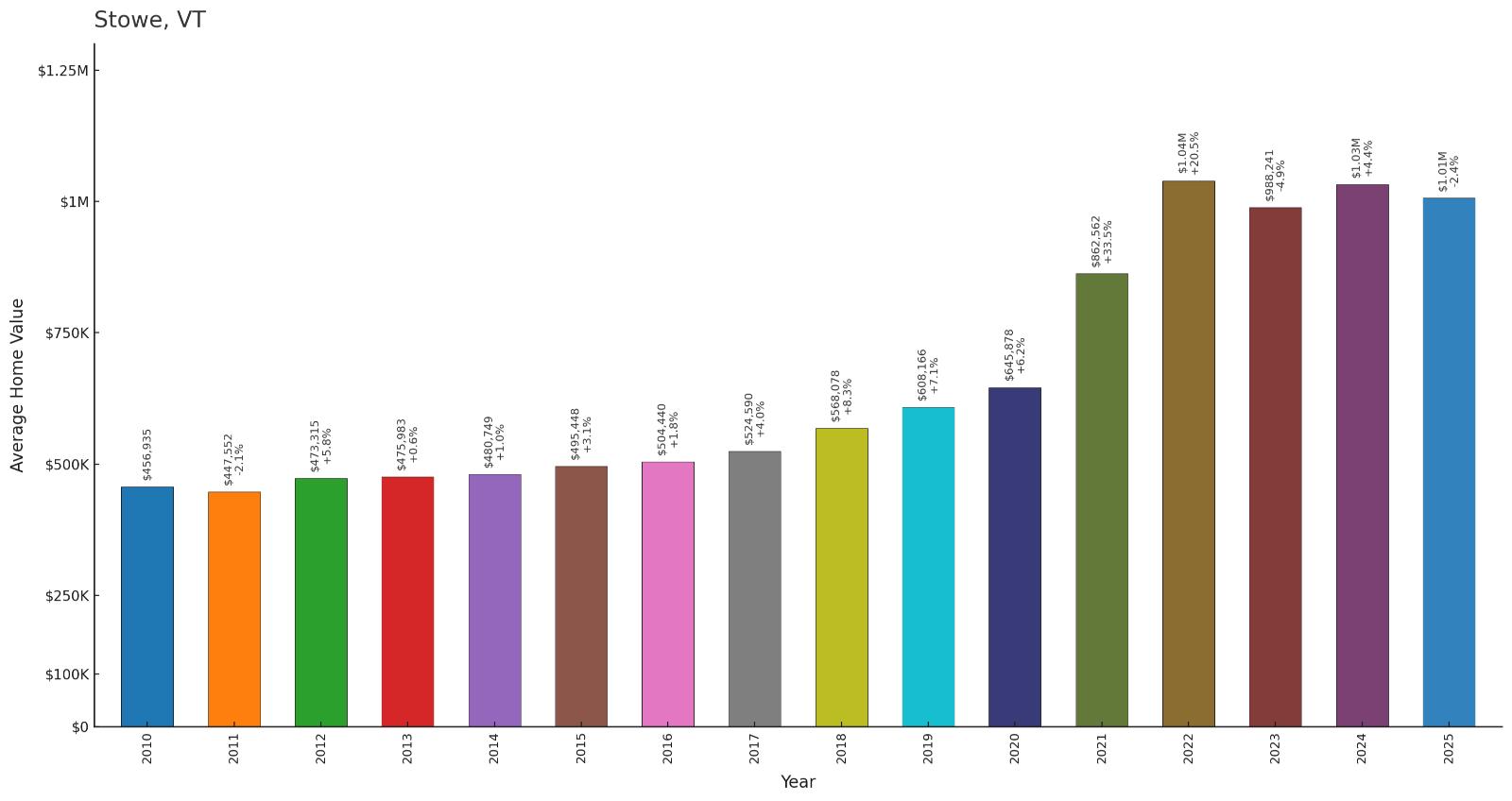
- 2010: $456,935
- 2011: $447,552
- 2012: $473,315
- 2013: $475,983
- 2014: $480,749
- 2015: $495,448
- 2016: $504,440
- 2017: $524,590
- 2018: $568,078
- 2019: $608,166
- 2020: $645,878
- 2021: $862,562
- 2022: $1,039,203
- 2023: $988,241
- 2024: $1,032,184
- 2025: $1,006,998
Stowe leads Vermont with an extraordinary 120% increase since 2010, rising from around $457,000 to over $1 million. The town showed steady appreciation through the 2010s before experiencing explosive growth during the pandemic, briefly exceeding $1 million in 2022 and 2024. Current values exceeding $1 million reflect Stowe’s status as Vermont’s premier resort destination and most expensive real estate market.
Why Stowe?
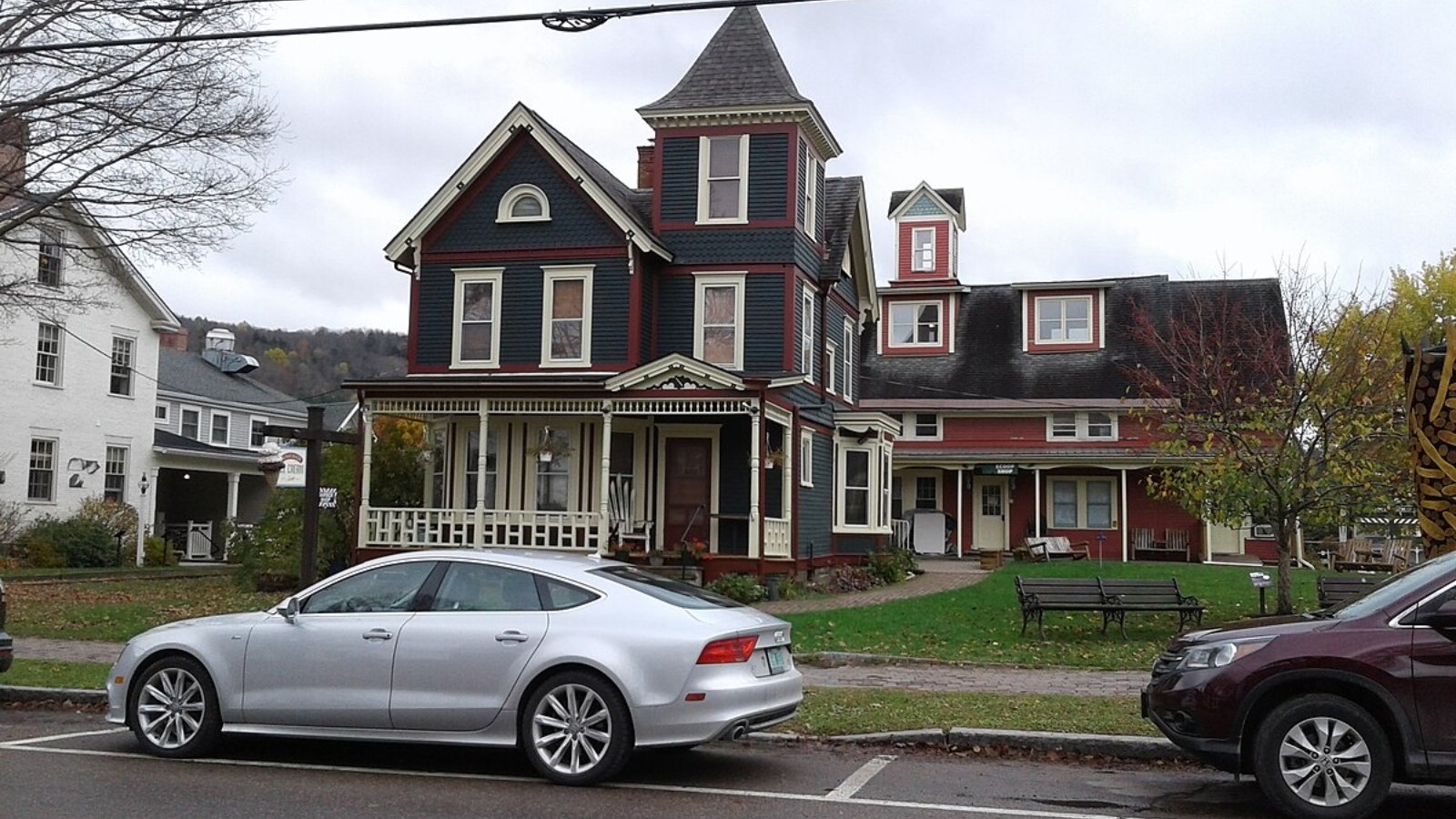
Why are people willing to pay so much to live here? What’s special about it?
Stowe represents the pinnacle of Vermont mountain living, combining world-class skiing at Stowe Mountain Resort with sophisticated amenities and breathtaking Alpine scenery. The town offers ski-in/ski-out properties, luxury mountain homes, and direct access to Mount Mansfield recreation while maintaining the authentic Vermont character that attracts affluent buyers from around the world. Many properties provide spectacular mountain views and four-season recreation access that justifies premium pricing.
The community provides upscale dining, shopping, and cultural amenities that create a sophisticated resort atmosphere year-round. Stowe’s reputation as the “Ski Capital of the East” and its comprehensive recreational infrastructure have established it as Vermont’s most prestigious and expensive real estate market for mountain properties and resort living.
How Stowe Rose to Prominence
Stowe was chartered in 1763 and developed as an agricultural community in the valley beneath Mount Mansfield. The town remained primarily rural throughout the 19th century, with farming and logging supporting the local economy. Stowe’s transformation began in the 1930s with the development of alpine skiing on Mount Mansfield, initially through the Civilian Conservation Corps.
The establishment of Stowe Mountain Resort and the town’s promotion as a ski destination attracted visitors and vacation home buyers beginning in the 1940s. Stowe’s careful balance of resort development with village preservation has created today’s sophisticated mountain community. The resort’s continued expansion and enhancement, combined with the town’s natural beauty and recreational opportunities, has driven Stowe’s emergence as Vermont’s premier luxury real estate market and most expensive community.
3 Interesting Tidbits
- Mount Mansfield – Vermont’s highest peak provides the backdrop for Stowe and offers hiking, skiing, and scenic drives that attract visitors year-round.
- von Trapp Family Lodge – The famous family from “The Sound of Music” established this Austrian-style resort in Stowe, continuing to operate it today.
- Stowe Mountain Resort – This world-class ski resort features 116 trails on Mount Mansfield and Spruce Peak, making it the premier skiing destination in the East.






